Early Views of Hollywood (1920 +)
Historical Photos of Early Hollywood |
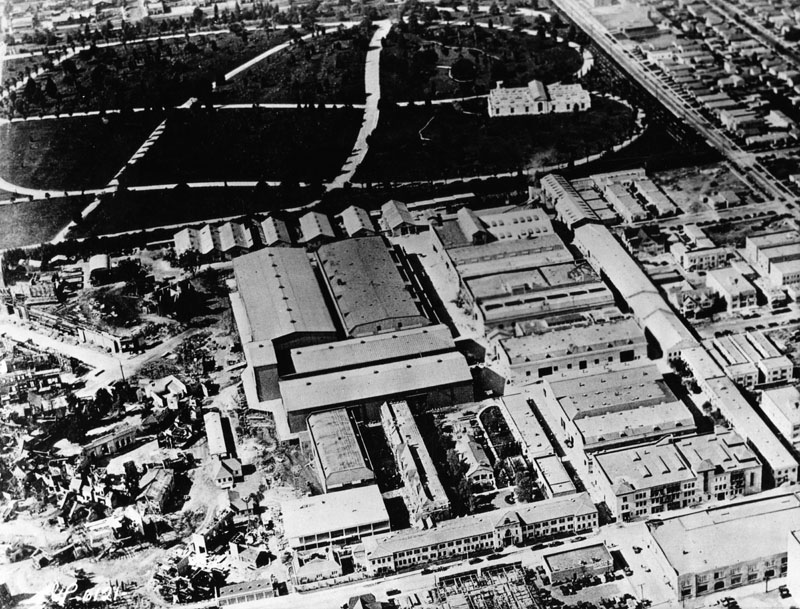 |
|
| (1930s)* - Aerial view, looking northeast, of Paramount Studios and sound stages located at 5555 Melrose Ave. Melrose runs east-west at bottom of photo. Van Ness Avenue runs south-north at upper right. The Hollywood Memorial Cemetery is seen at top. Paramount's main office building is seen at bottom-center on the north side of Melrose. |
Historical Notes Paramount Pictures dates its existence from the 1912 founding date of the Famous Players Film Company. Founder Hungarian-born Adolph Zukor, who had been an early investor in nickelodeons, saw that movies appealed mainly to working-class immigrants. With partners Daniel Frohman and Charles Frohman he planned to offer feature-length films that would appeal to the middle class by featuring the leading theatrical players of the time (leading to the slogan "Famous Players in Famous Plays". By mid-1913, Famous Players had completed five films, and Zukor was on his way to success. |
Paramount-Famous-Lasky Corporation West Coast Studios
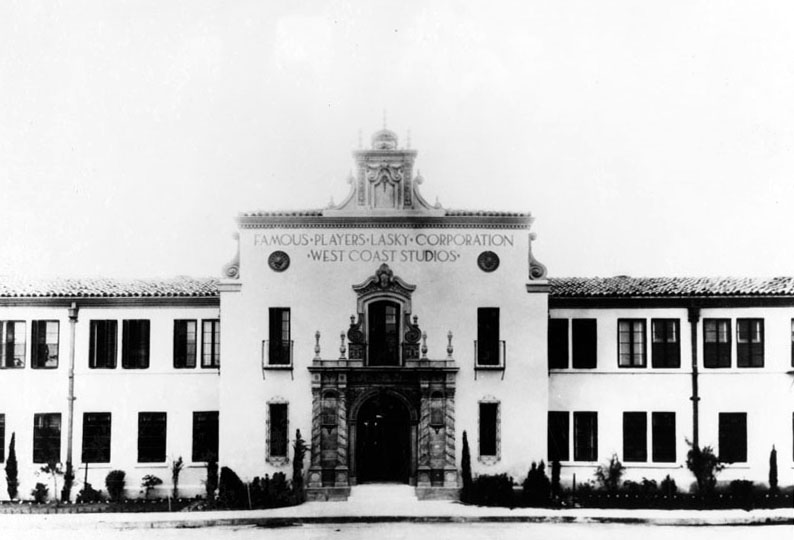 |
|
| (ca. 1916)* - Entrance to the Famous Players-Lasky Corporation West Coast Studios located at 5555 Melrose Avenue before Paramount was added. |
Historical Notes In 1916, Adolph Zukor maneuvered a three-way merger of his Famous Players, the Lasky Company, and Paramount. The new company Lasky and Zukor founded, Famous Players-Lasky Corporation, grew quickly, with Lasky and his partners Goldwyn and DeMille running the production side, Hiram Abrams in charge of distribution, and Zukor making great plans. Famous Players-Lasky and its "Paramount Pictures" soon dominated the business. |
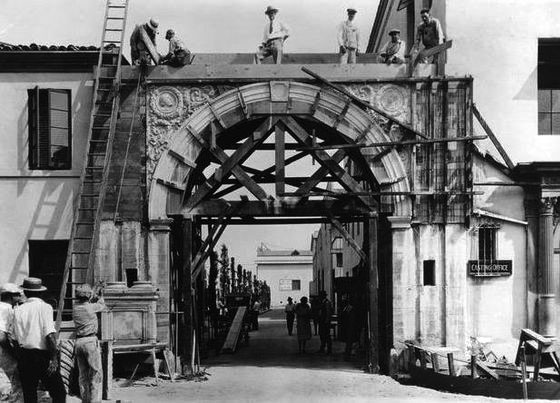 |
|
| (1925)* – View showing the construction of the Famous Players-Lasky gate, later becoming the iconic Paramount Studios gate. |
Historical Notes In September 1927, Famous Players-Lasky was reorganized under the name Paramount Famous Lasky Corporation, later becoming the Paramount Pictures Corporation (now a division of Viacom). |
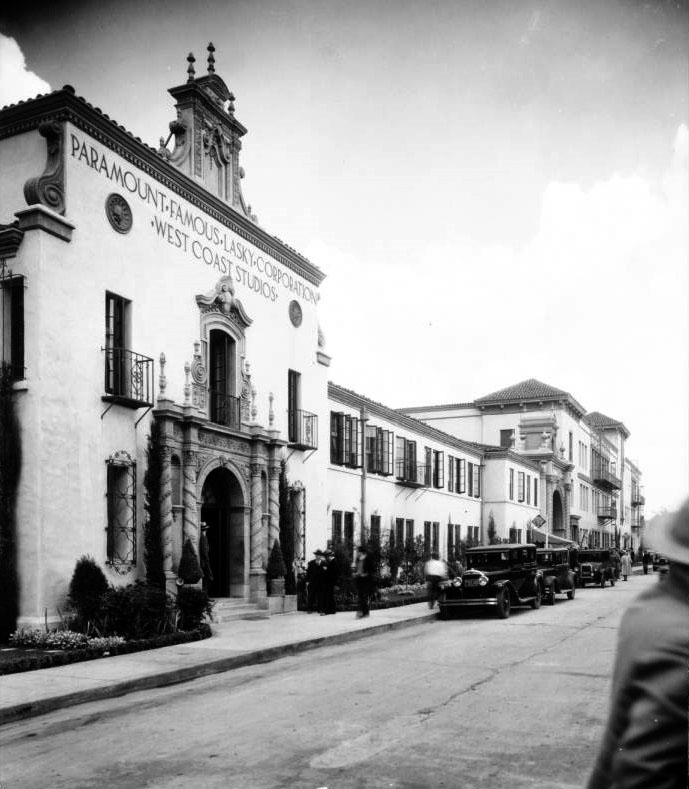 |
|
| (1930)* - View of the Paramount Famous Lasky Corporation Studios at 5451 Marathon Street in Hollywood. The main entrance is through an elaborately carved stone archway in the foreground at left, and a sign above the entryway bears the name of the studio. A line of dark vehicles is parked along the side of the street in front of the building, and many pedestrians can be seen as well. The studio entrance gates can be seen at center-right. |
Historical Notes Zukor signed and developed many of the leading early stars, including Mary Pickford, Marguerite Clark, Pauline Frederick, Douglas Fairbanks, Gloria Swanson, Rudolph Valentino, and Wallace Reid. With so many important players, Paramount was able to introduce "block booking", which meant that an exhibitor who wanted a particular star's films had to buy a year's worth of other Paramount productions. It was this system that gave Paramount a leading position in the 1920s and 1930s, but which led the government to pursue it on antitrust grounds for more than twenty years. |
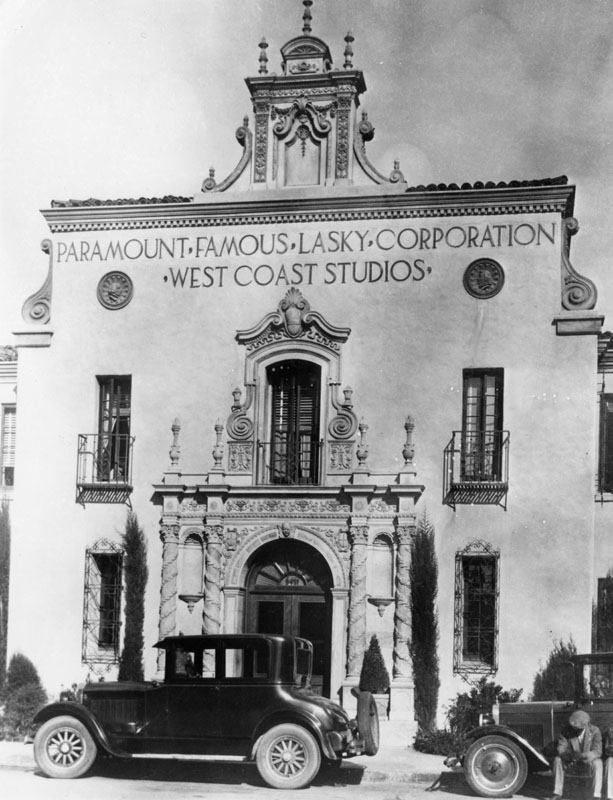 |
|
| (ca. 1930s)* - View of the Paramount-Famous-Lasky Corporation West Coast Studios building. |
Historical Notes Paramount films emphasized stars; in the 1920s there were Swanson, Valentino, and Clara Bow. By the 1930s, talkies brought in a range of powerful new draws: Miriam Hopkins, Marlene Dietrich, Mae West, W.C. Fields, Jeanette MacDonald, Claudette Colbert, the Marx Brothers (whose first two films were shot at Paramount's Astoria, New York, studio), Dorothy Lamour, Carole Lombard, Bing Crosby, band leader Shep Fields, famous Argentine tango singer Carlos Gardel, and Gary Cooper among them. In this period Paramount can truly be described as a movie factory, turning out sixty to seventy pictures a year. |
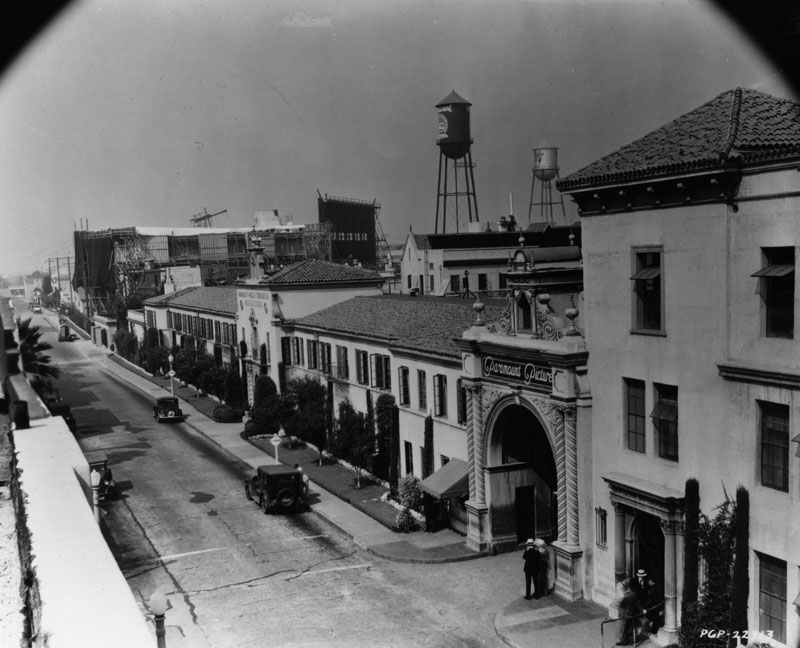 |
|
| (1936)* - View looking west on Melrose Avenue showing the Paramount Studios corporate office building at center-left and one of the entrance gates in the foreground. |
Historical Notes In 1933, Mae West would also add greatly to Paramount's success with her suggestive movies She Done Him Wrong and I'm No Angel. However, the sex appeal West gave in these movies would also lead to the enforcement of the Production Code, as the newly formed organization the Catholic Legion of Decency threatened a boycott if it was not enforced. |
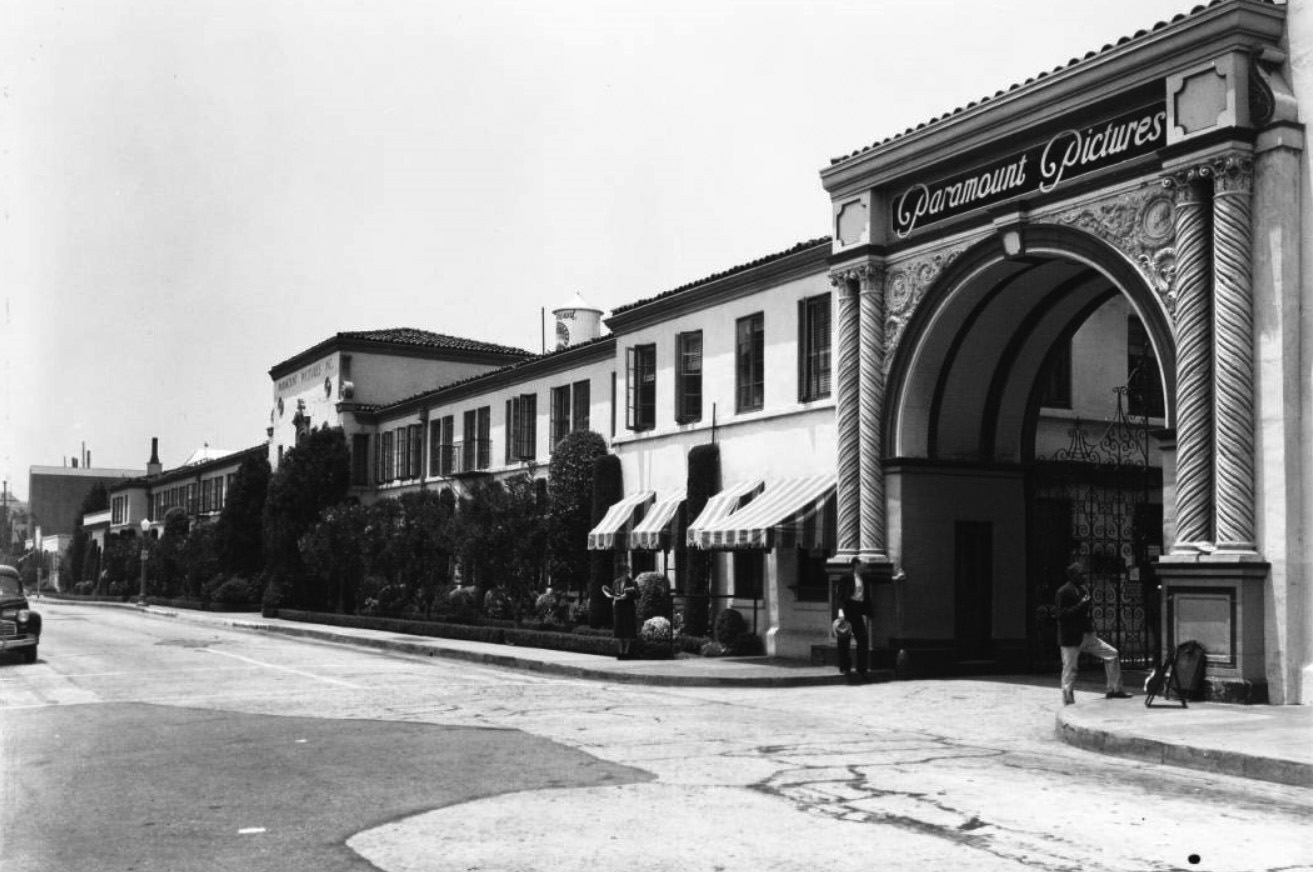 |
|
| (1940)* – Street view showing the front gates to Paramount Studios at 5555 Melrose Avenue. Several people stand just outside the large archway of the gated entrance to the studios. The top of a Paramount water tower can be seen over the roof in the center distance. |
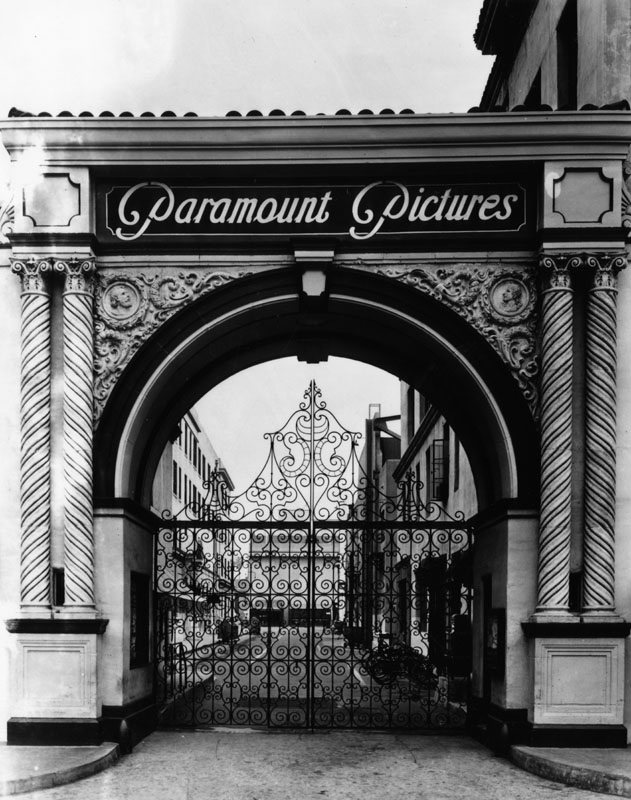 |
|
| (1957)* - View of the elaborately carved stone archway entrance to Paramount Studios in Hollywood. |
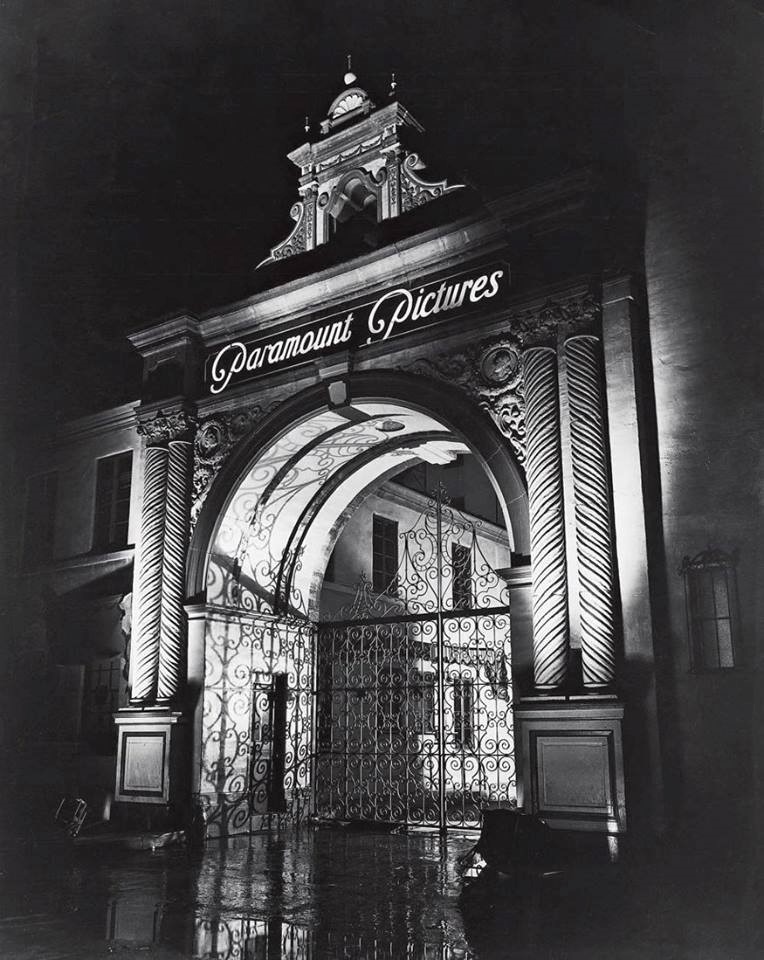 |
|
| (n.d.)* – Night view showing the Paramount Pictures gate with spotlights accentuating its many features. The lighting shows the texture of the columns, and decorative motifs over the arch. Note how the light at the back projects the intricate ironwork of the gates onto the walls of the arch. |
Then and Now
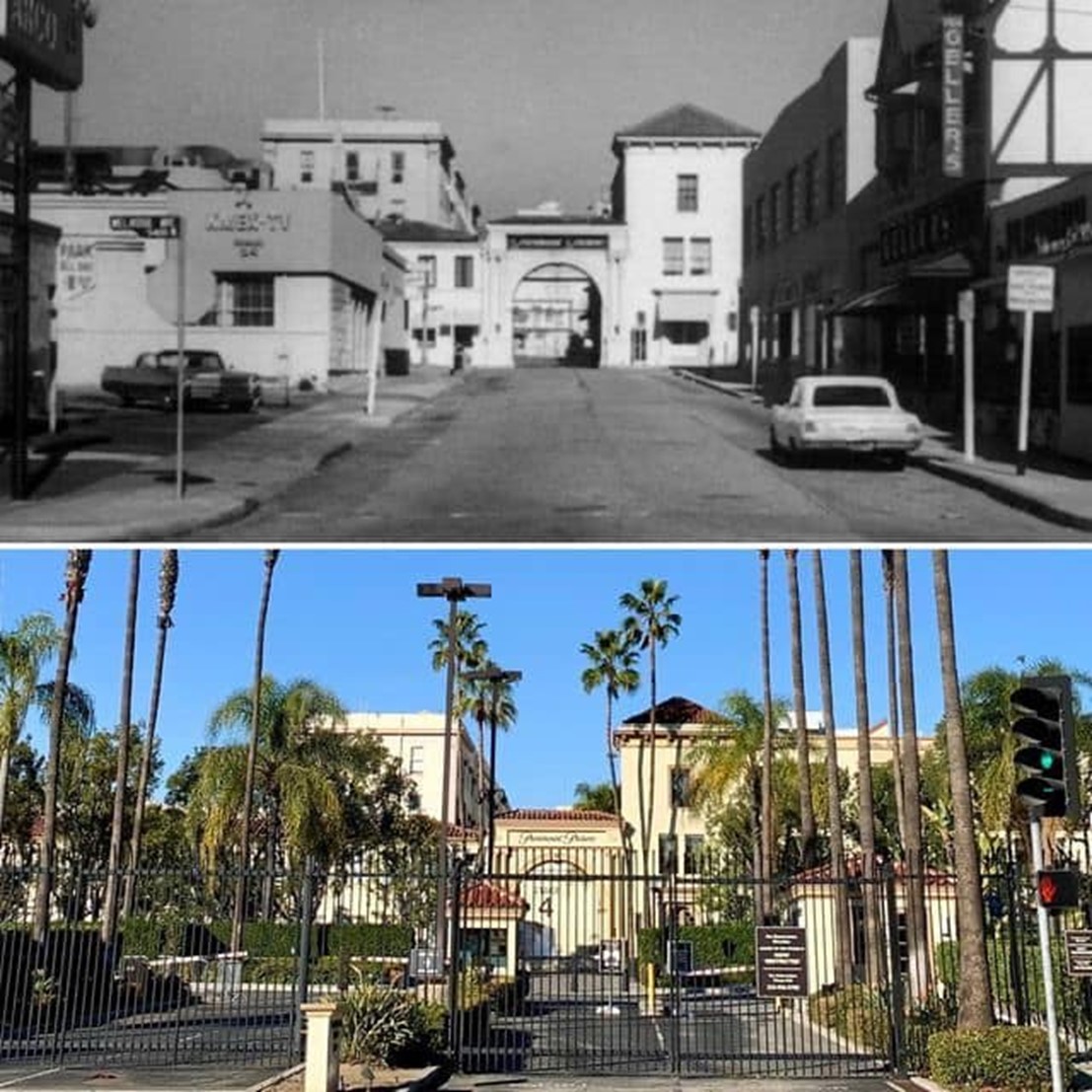 |
|
| Then and Now, The Bronson Gate at Paramount Studios.* |
 |
|
| (n.d.)* - View of the entrance gates to Paramount Pictures with the current addition of palm trees and fountain. |
Historical Notes Paramount is the fifth oldest surviving film studio in the world behind Universal Studios, Nordisk Film, Pathé, and Gaumont Film Company. It is the last major film studio still headquartered in Hollywood. |
Famous Players Fiction Studios (Raleigh Studios)
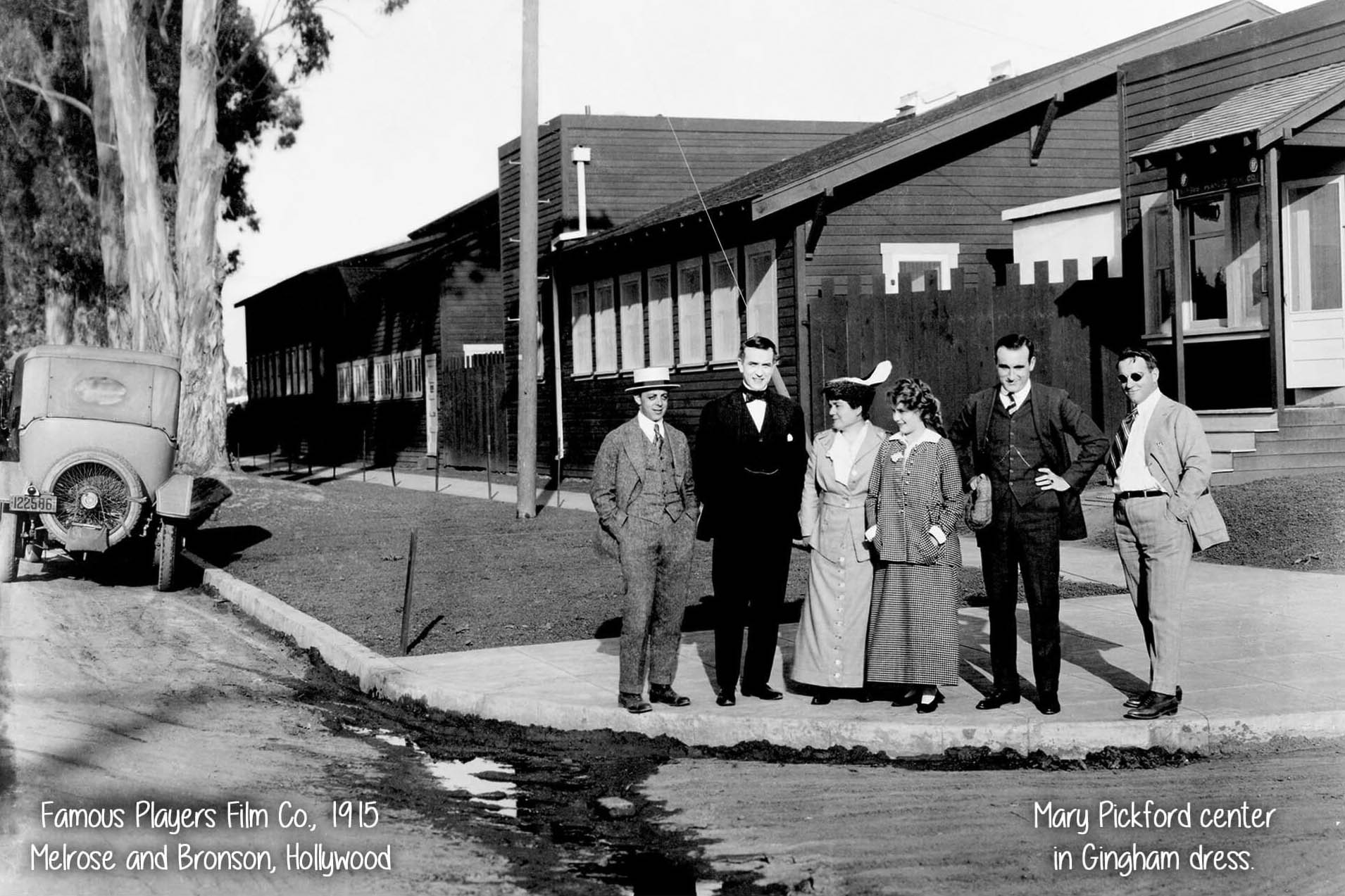 |
|
| (1915)* - A group of people, including Mary Pickford, stand on the southeast corner of Melrose and Bronson Avenue in front of the Famous Players Film Co. Studios. |
Historical Notes The Famous Players Film Company was a film company founded in 1912 by Adolph Zukor in partnership with the Frohman brothers, powerful New York City theatre impresarios. In 1915, the company established Famous Players Fiction Studios at 5300 Melrose Avenue in Hollywood. The new studio's first film starred Mary Pickford. The studio later became Clune Studio, then California Studio, then Gross-Krasne, followed by Producers Studios Inc., and is now known as Raleigh Studios. Raleigh Studios is known for being the site of Gunsmoke, Perry Mason, and currently Let's Make a Deal. It is one of the oldest studios in Hollywood. Over the years, it has been known by various names, including: 1915: Famous Players Fiction Studios 1916: Clune Studios 1919: Fairbanks Productions 1922: CBC/Waldorf Comedies 1924: United Studios 1934: Prudential Studios 1941: California Studios 1946: Enterprise Studios (reverting to California Studios after bankruptcy) 1960s: Producers Studio 1979: Raleigh Film & Television Studios |
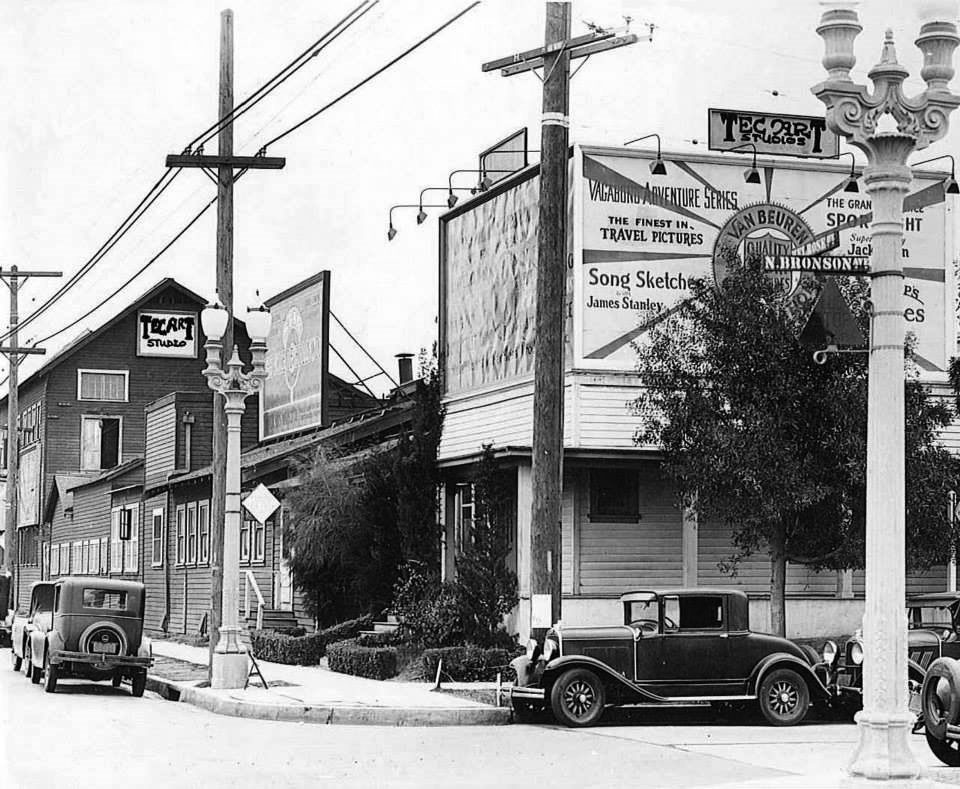 |
|
| (1927)* - View looking southeast at the intersection of Melrose and Bronson Avenue. At the time of this photo, the lot was occupied by United Studios, which is now Raleigh Studios. Note the ornate two-lamp streetlight. |
Historical Notes It's worth noting that the studio has been in continuous operation since 1915, making it the longest continuously operating studio of its type. The name "Raleigh Studios" came into use when Raleigh Enterprises acquired the studio in 1979. Throughout its history, the studio has maintained its location at the corner of Melrose Avenue and Bronson Avenue in Hollywood, directly across from Paramount Studios. The twin street lights along Melrose were the Marbelite 1900 model, distinguished by its squarish base. The Melrose lights were removed around 1950, but there are a few survivors fairly close by. Wilshire Boulevard on the west side also had similar streetlights in the 1930s. |
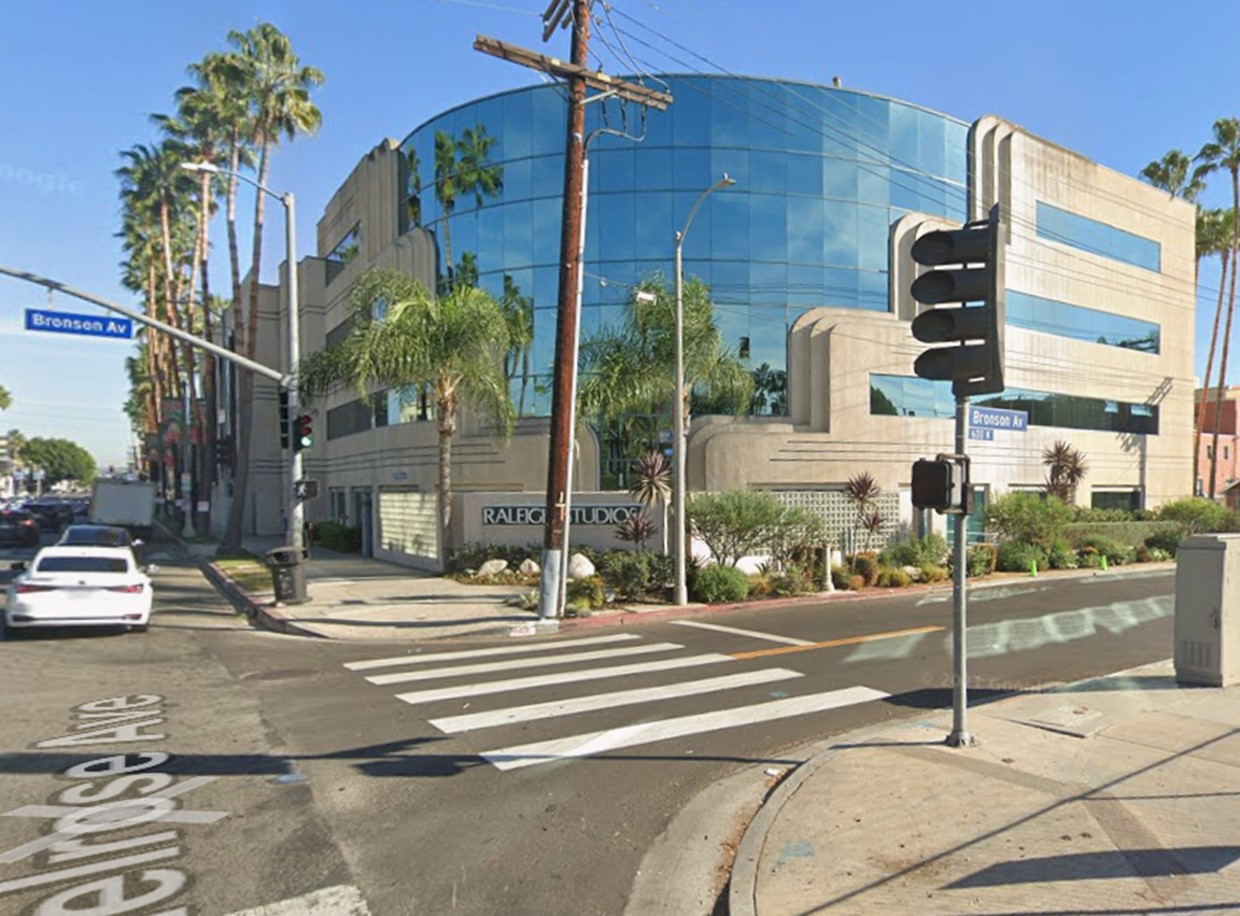 |
|
| (2021)* - View looking toward the southeast corner of Melrose and Bronson Avenue, now the site of Raleigh Studios. |
Historical Notes Since its founding in 1915, Raleigh Studios has evolved into one of the longest continuously operating studios worldwide. Initially established as Famous Players Fiction Studios, it saw multiple ownership changes and name variations, such as Paralta Studios and Douglas Fairbanks Studios. During the silent era, it built one of the first soundstages with a glass top. In 1928, Walt and Roy Disney started their sound recording company on the lot. Raleigh Enterprises acquired the studio in 1979, expanding and modernizing it, including developing Raleigh Studios Manhattan Beach in 1998 and engaging in global projects. Adding Hollywood Rentals in 2004, it became a major lighting and grip equipment provider. Despite fluctuating global production incentives, Raleigh has focused on enhancing its Hollywood lot. Hosting numerous influential filmmakers and productions, it remains a modern facility with high-speed internet and contemporary amenities, preserving its historical significance in Hollywood |
Then and Now
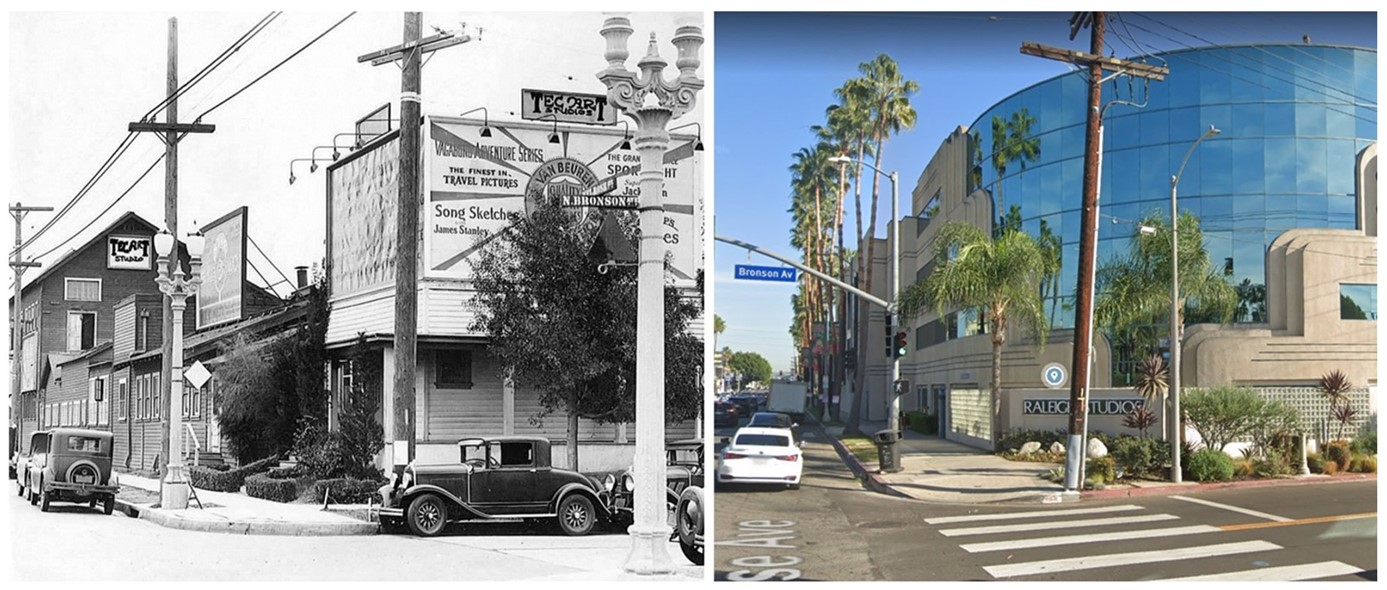 |
|
| (1927 vs 2021)* - View looking toward the southeast corner of Melrose and Bronson Avenue, now the site of Raleigh Studios. |
Ravenswood Apartments
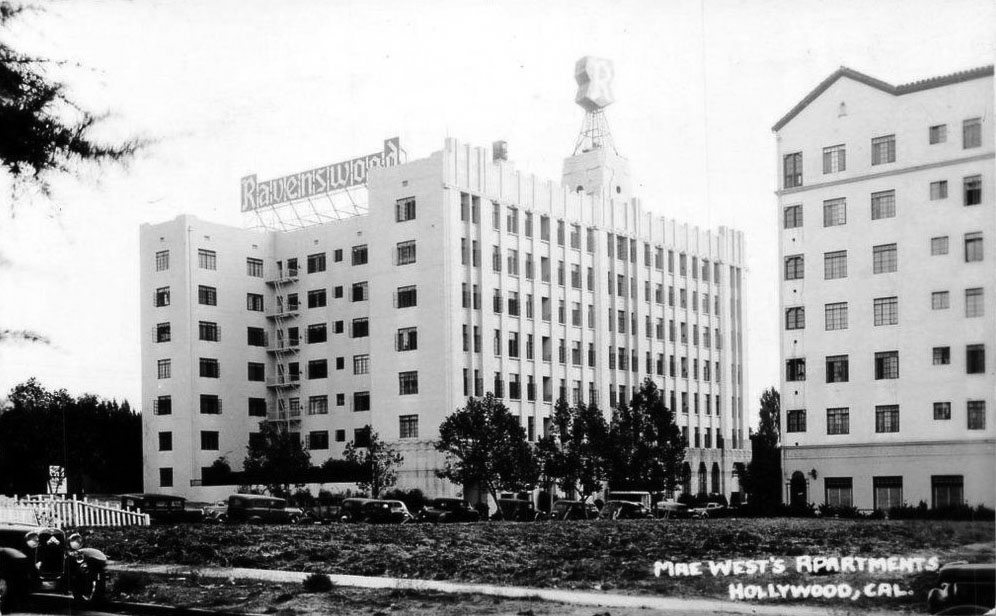 |
|
| (1930s)*# - Postcard view looking southeast showing the Ravenswood Apartments (570 S. Rossmore Ave) as seen from Clinton Street. Caption reads: "Mae West's Apartments". The lighted Ravenswood sign and the giant revolving "R" (now gone) were visible from Hollywood and Vine. |
Historical Notes Throughout the years, the Ravenswood Apartments housed several movie stars, including Mae West, Ava Gardner and Clark Gable. |
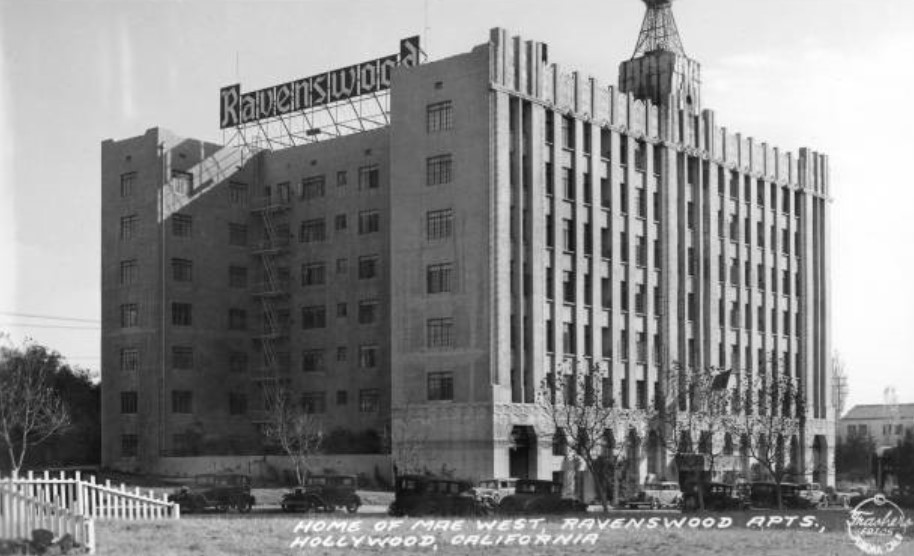 |
|
| (1936)* – Postcard view showing the Art Deco Ravenswood Apartments at 570 S. Rossmore Ave. Caption reads: “Home of Mae West, Ravenswood Apts., Hollywood, California” |
Historical Notes Mae West moved into Apartment #611, a 2 bedroom, 2 bath unit, shortly after her arrival in Hollywood in 1932. The apartment had been reserved for her by Paramount and she liked it so much she never left. Offered a lifetime lease, she eventually had a share in the building when she lent the owners some money and they used the building as collateral. West lived there until her death in 1980. |
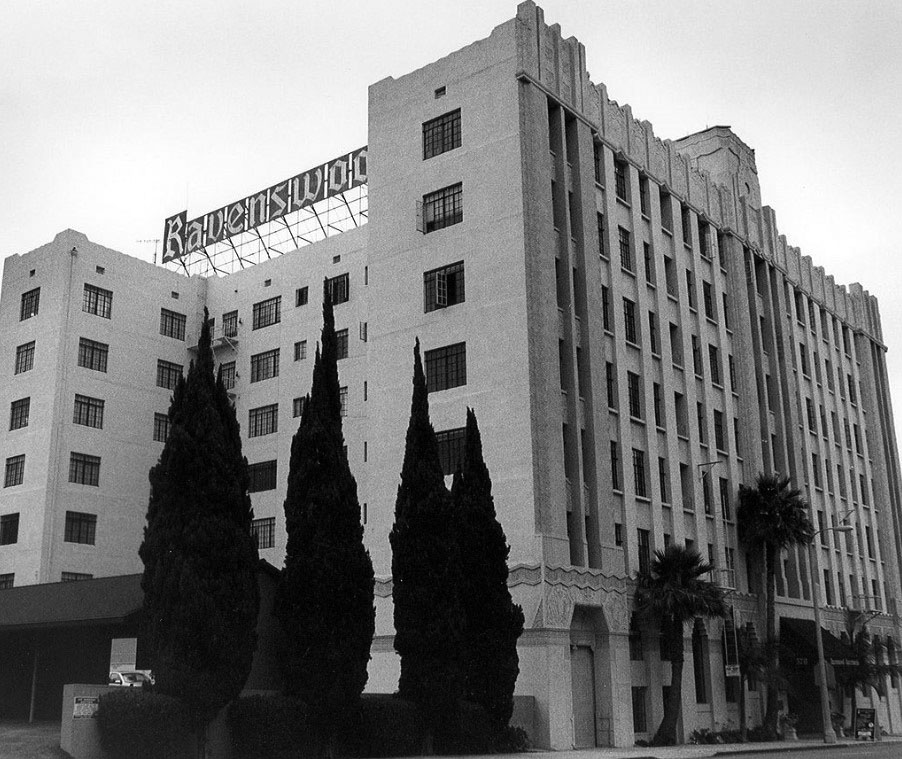 |
|
| (2003)*^ – View of the Ravenswood Apartments on Rossmore Avenue just south of Clinton Street. |
Historical Notes The Ravenswood is a historic apartment building at 570 North Rossmore Avenue in Hollywood. Designed by architect Max Maltzman and built by Paramount Pictures in 1930, it is considered a landmark Art Deco masterpiece. It has been declared a Historic-Cultural Monument (No. 768) by the City of Los Angeles (Click HERE to see complete listing). |
Grauman's Chinese Theater
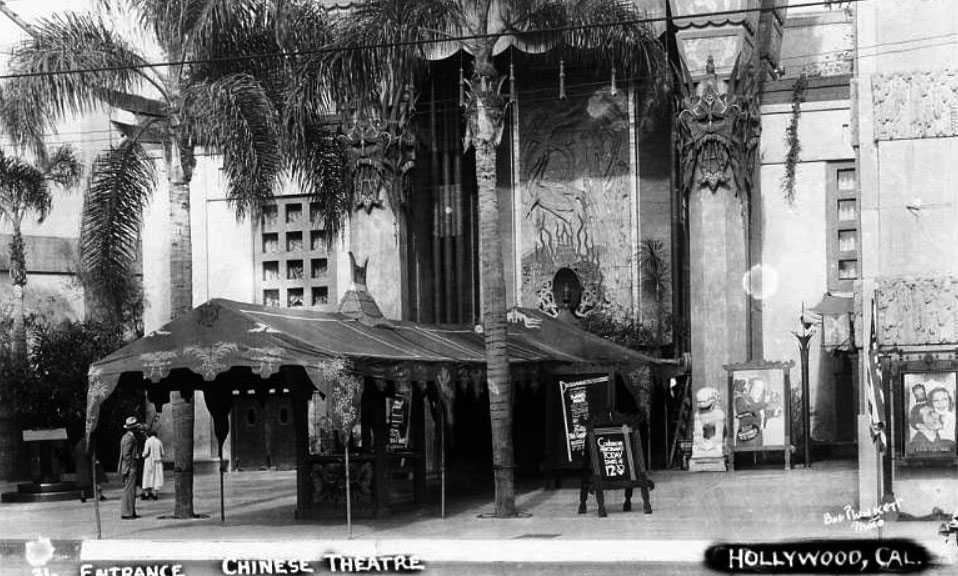 |
|
| (1934)#*^# – Close-up postcard view showng the entrance to the Chinese Theatre with the box office installed in the forecourt. Now Playing: "The White Parade" with Loretta Young and John Boles |
Historical Notes The White Parade is a 1934 film that was nominated for the Academy Award for Best Picture. It was written by Rian James, Jesse Lasky Jr., Sonya Levien and Ernest Pascal, from the novel by Rian James. The film was directed by Irving Cummings. Dedicated to "the memory of Florence Nightingale", the plot concerns the travails and romances of young women as they study to become nurses. It stars Loretta Young and John Boles. The only surviving print is located at the UCLA film archive, and can be viewed at the Instructional Media Lab, Powell Library, after making an appointment. This is one of two Best Picture nominees that have never been released on home video. The other is East Lynne (1931 film). with Loretta Young and John Boles.*^ |
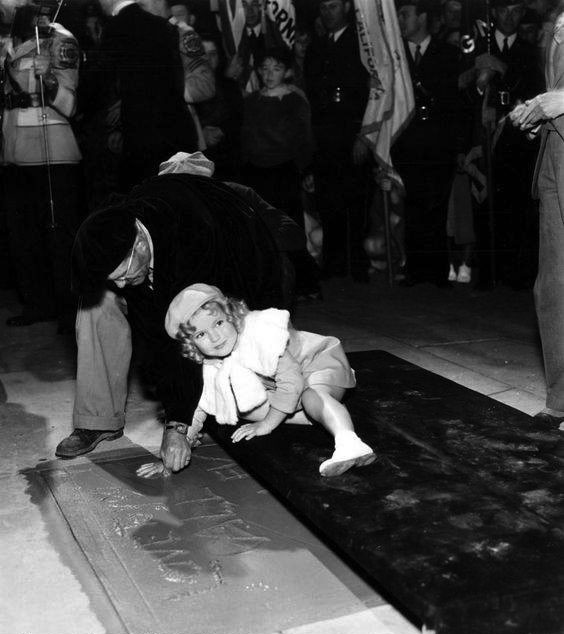 |
|
| (1935)#**# – View showing Shirley Temple at age 6 leaving her hand-and-footprint at a ceremony outside the Grauman’s Chinese on March 14, 1935. |
Historical Notes Shirley Temple was, without a doubt, the biggest child star ever. She was the number-one box-office star from 1935 through 1938. She once said her Mom took her to Bullocks Wilshire to meet Santa Claus. She stopped believing when she sat on his lap and Santa Claus asked her for an autograph. #**# |
 |
|
| (1936)^.^ - Shirley Temple gets her name strung up over Hollywood Boulevard for the May 1936 run of "Captain January" at Grauman's Chinese Theater. |
Historical Notes Shirley Temple began her film career in 1932 at the age of three. In 1934, she found international fame in Bright Eyes, a feature film designed specifically for her talents. She received a special Juvenile Academy Award in February 1935 for her outstanding contribution as a juvenile performer to motion pictures during 1934, and film hits such as Curly Top and Heidi followed year after year during the mid-to-late 1930s. Licensed merchandise that capitalized on her wholesome image included dolls, dishes, and clothing. Her box-office popularity waned as she reached adolescence. She appeared in a few films of varying quality in her mid-to-late teens, and retired completely from films in 1950 at the age of 22. As an adult, now Shirley Temple Black, she entered politics and became a diplomat, serving as United States Ambassador to Ghana and later to Czechoslovakia, and as Chief of Protocol of the United States.*^ |
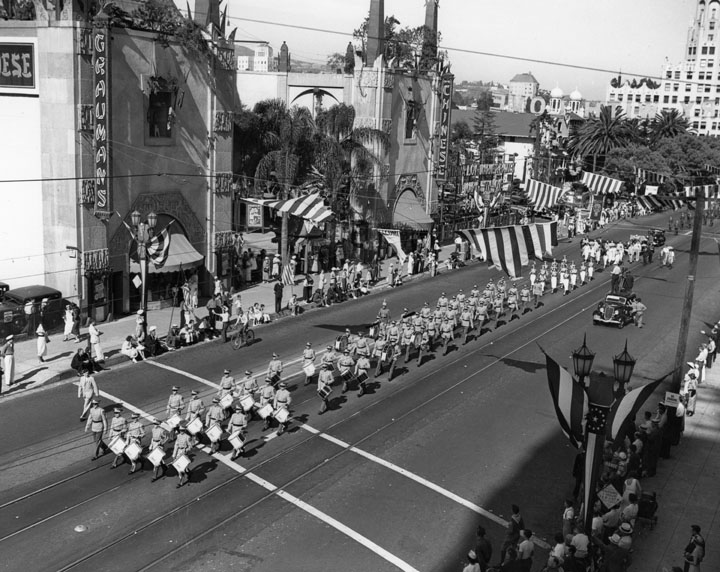 |
|
| (1936)* - A marching band in the 1936 Welcome Military Parade on Hollywood Boulevard passes in front of Grauman's Chinese Theater. |
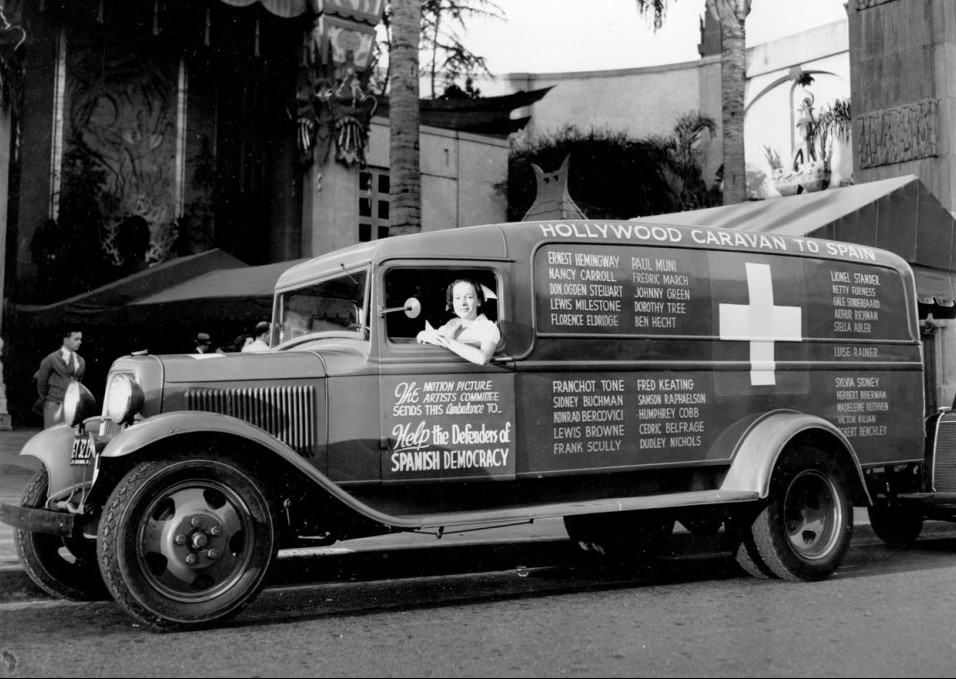 |
|
| (1937)^##* - View of the Hollywood Caravan to Spain in front of Grauman’s Chinese Theatre. |
Historical Notes Riette Kahn is shown at the wheel of an ambulance donated by the American movie industry to the Spanish government in Los Angeles, California, on Sept. 18, 1937. The Hollywood Caravan to Spain will first tour the U.S. to raise funds to “help the defenders of Spanish democracy” in the Spanish Civil War.^##* |
* * * * * |
Hollywood Police Station
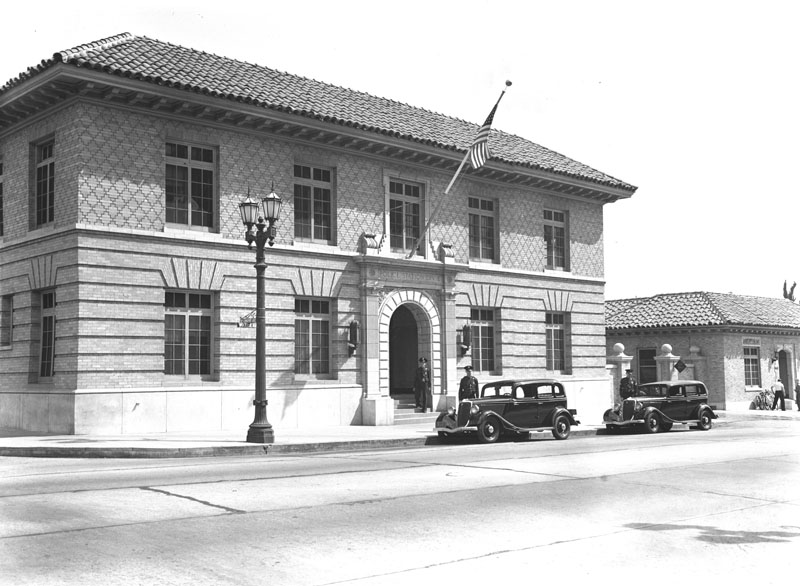 |
|
| (1936)* - Exterior view of the Hollywood police station, Division 6, located at 1358 No. Wilcox Ave., with the receiving hospital next door at right. Three uniformed officers stand in front, next to parked police cars. A flag flies above the entrance. |
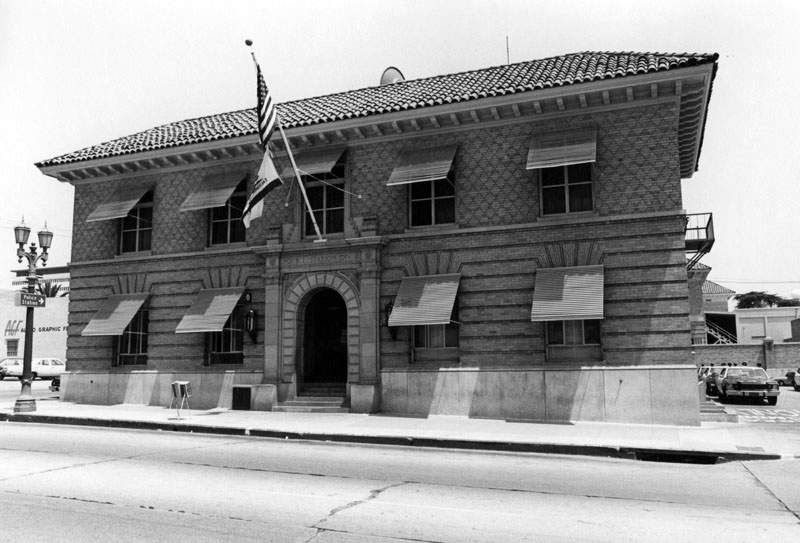 |
|
| (ca. 1970s)* - Exterior of Los Angeles Police Dept. Station, Div. 6, located on the southwest corner of Wilcox and De Longpre avenues. Photo by Tom LaBonge |
Historical Notes A new police station building stands at this site today. Click HERE for contemporary view. |
Hollywood Post Office
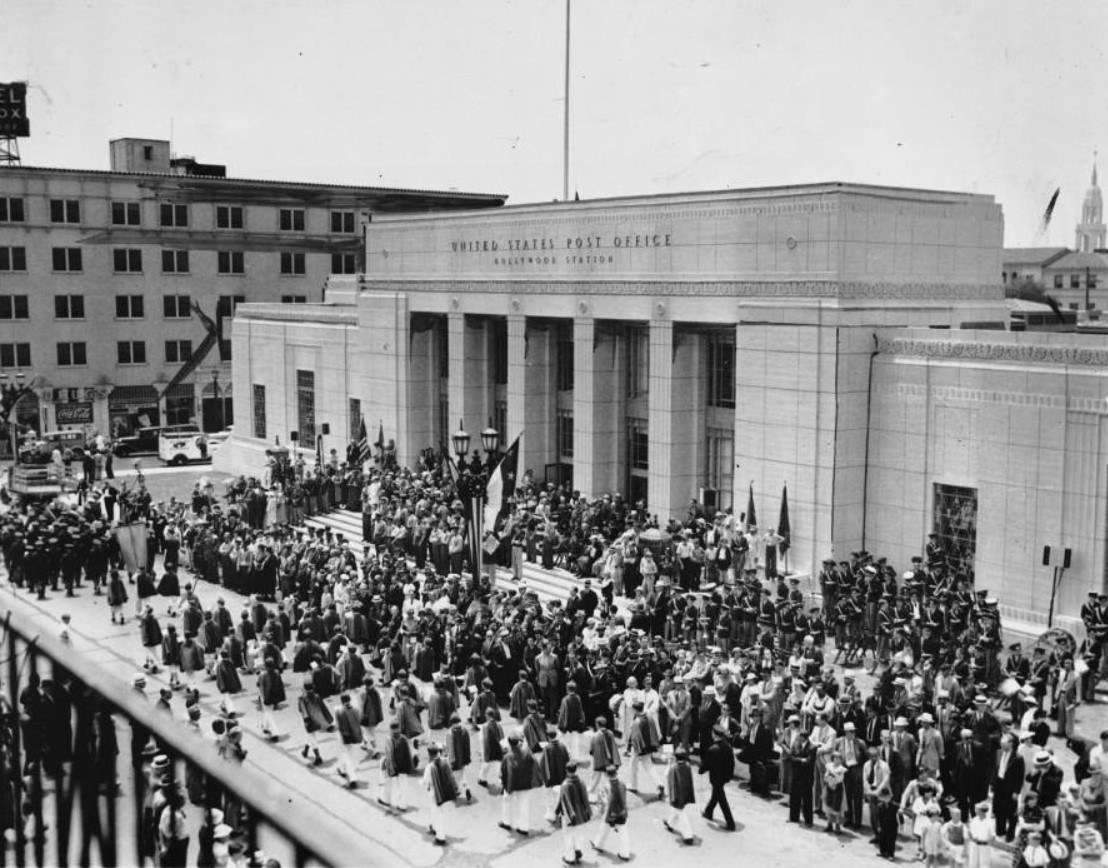 |
|
| (1937)^^ - View showing the opening of the Hollywood Post Office (Hollywood Station) at 1615 Wilcox Avenue with a parade out front. |
Historical Notes In 1937, renowned Art Deco architect Claud Beelman, a partner at Curlett and Beelman, was commissioned by the Works Progress Administration (WPA) to design the Hollywood Post Office Building. A wooden bas-relief inside, titled "The Horseman", was carved by artist Gordon Newell as a WPA commission and still stands above a door. Claud Beelman was a self-trained draftsman turned "moderne" architect in the early 20th century. He designed the Los Angeles County Fair Gallery, also commissioned by the WPA in 1937.*^ |
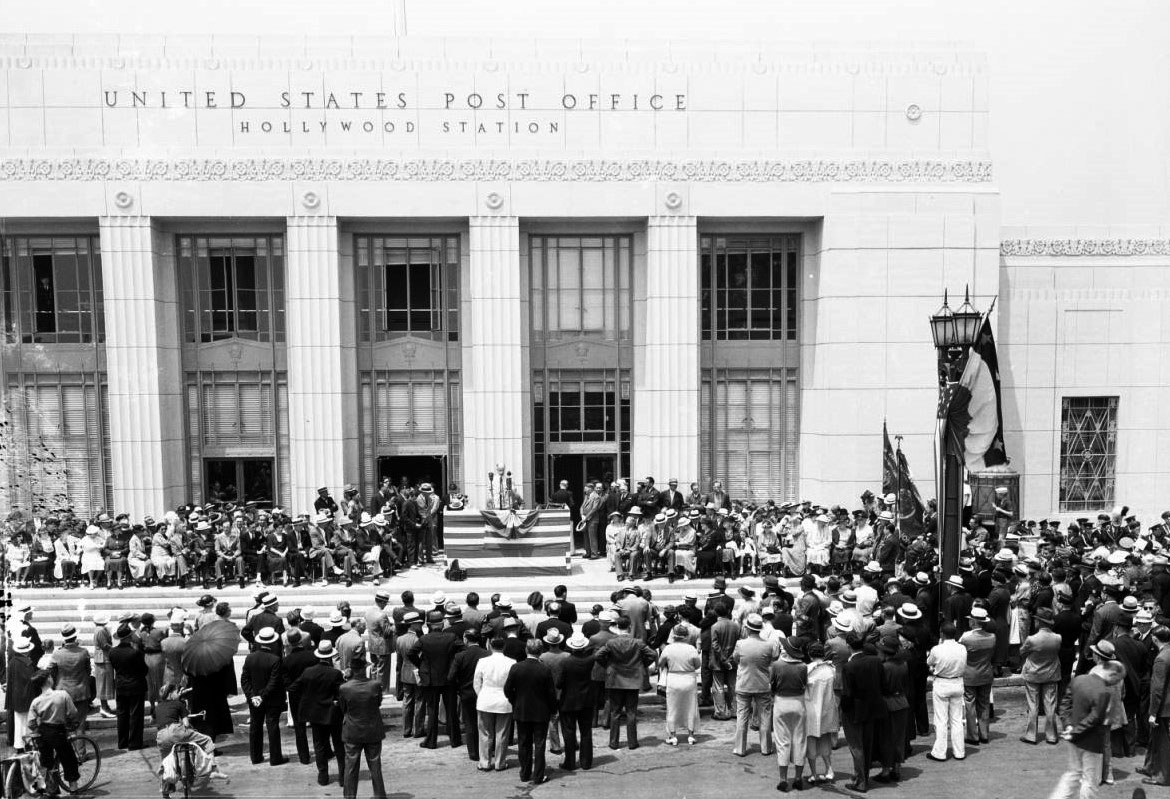 |
|
| (1937)^^ - A man is seen standing behind a podium and giving a speech to a crowd on the steps of the new Art Deco Hollywood Station. The post office is located on the northwest corner of Wilcox and Selma avenues. |
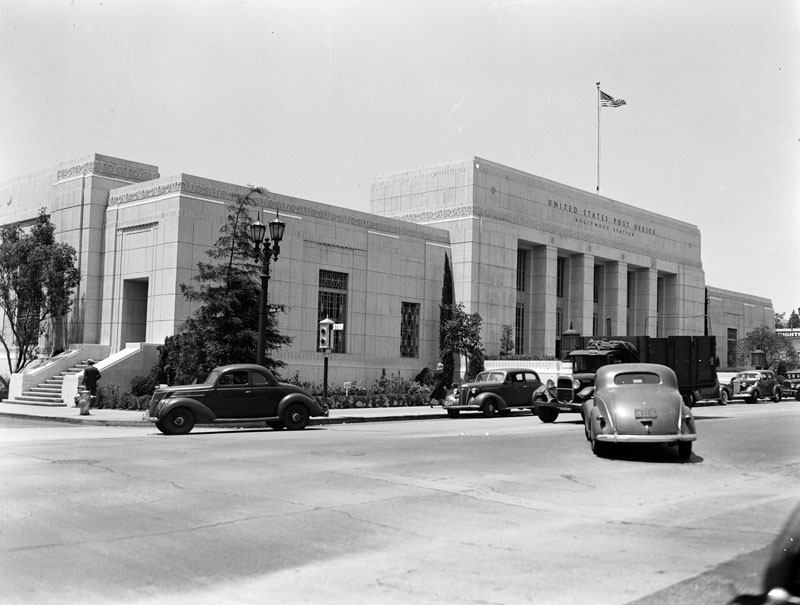 |
|
| (1939)* - Exterior view of the Hollywood Post Office, located at 1615 No. Wilcox Avenue in Hollywood. |
Historical Notes The post office is one of the few governmental and historical structures left unscathed in Hollywood. It was dedicated as a LA Historic-Cultural Monument in 1985. Today, the building is also a “dead letter repository for love letters to such Hollywood luminaries as Clark Gable, Judy Garland, and others”. *^ Click HERE for contemporary view. |
* * * * * |
Hollywood Citizen-News Building
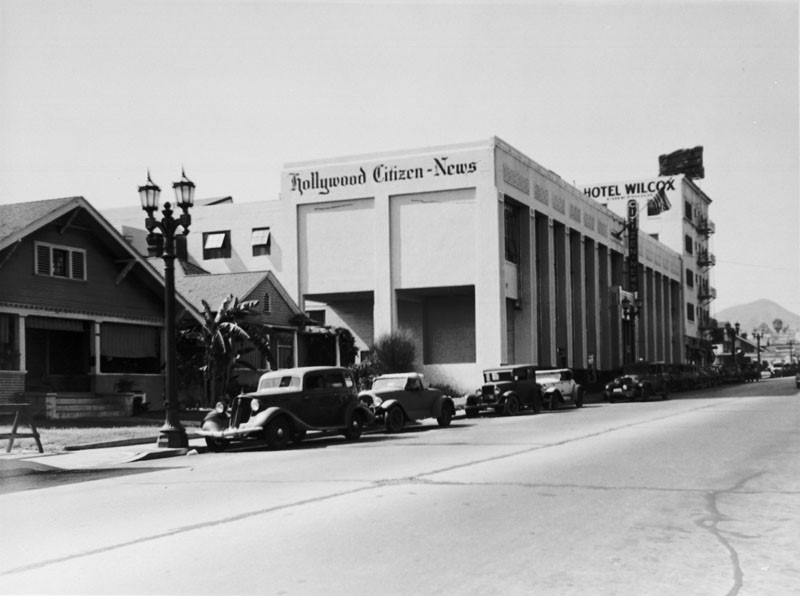 |
|
| (1934)* – View looking north on Wilcox Avenue from near Sunset Boulevard showing the Hollywood Citizen-News Building at Exterior view of the Hollywood Citizen-News building on Selma and Wilcox, in Hollywood. |
Historical Notes Constructed in 1930, the art deco structure designed by architect Francis D. Rutherford was the production headquarters for the Hollywood Citizen News. The newspaper operated under various owners from the 1930s to the early 1970s. ^^# |
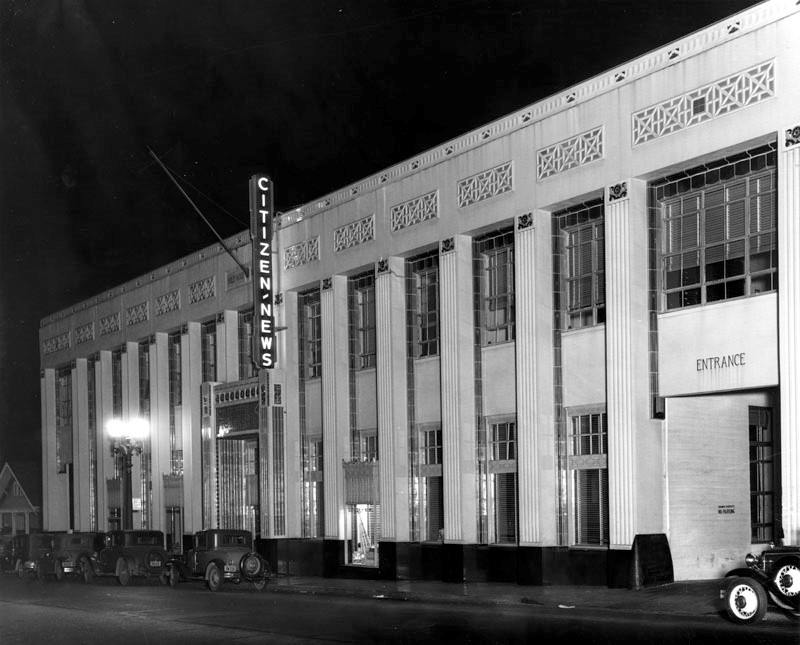 |
|
| (1930s)* - Night view of the exterior of the Hollywood Citizen-News building near the corner of Wilcox and Selma avenues, Hollywood. |
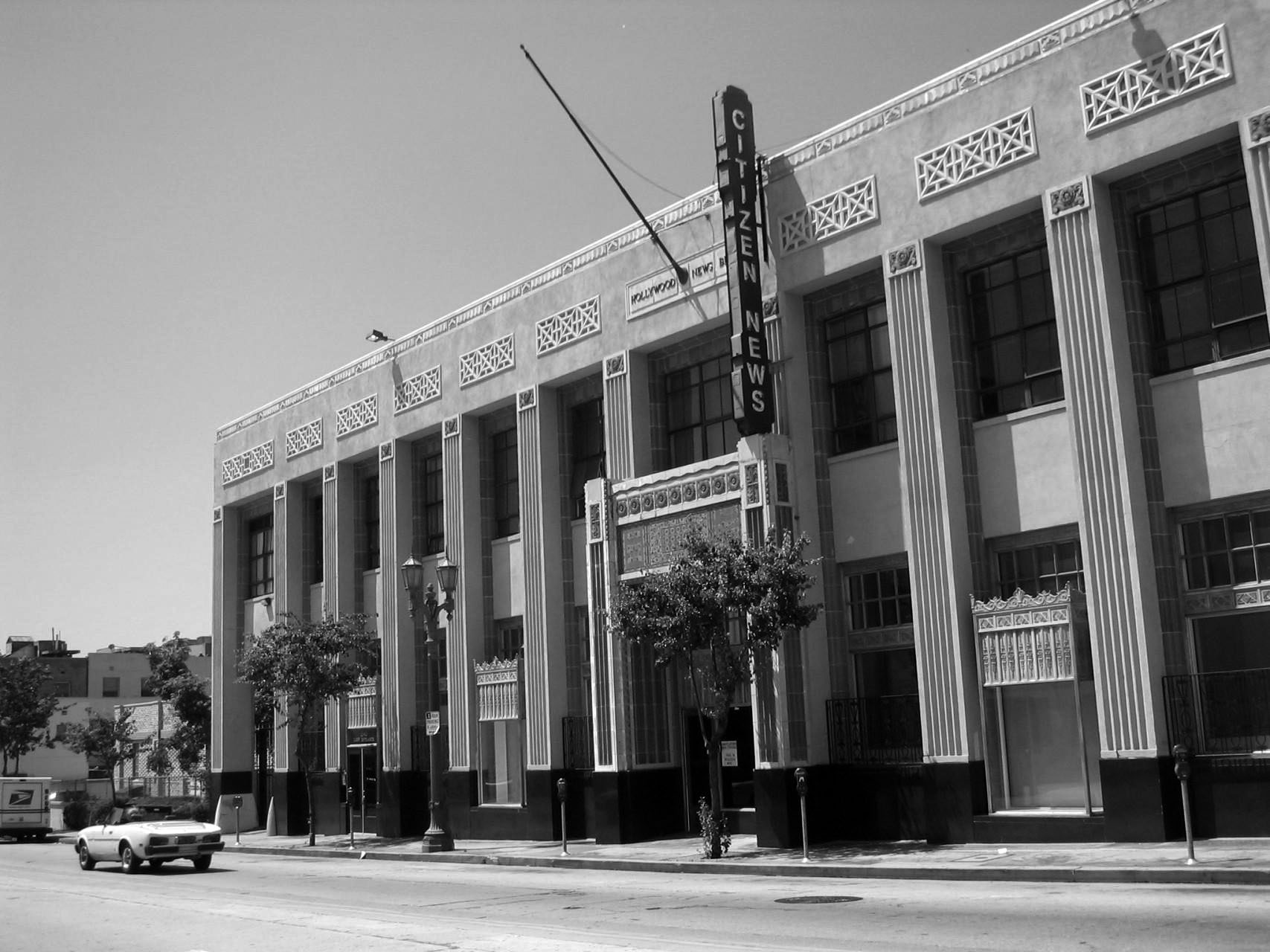 |
|
| (2014)^^# – View showing the Citizen-News Building at 1545 N. Wilcox Avenue. Click HERE to see a more contemporary view. |
Historical Notes The building, which is located between Hollywood and Sunset boulevards, underwent a multimillion-dollar renovation in 2006 to cater to the tastes of tenants in the media and entertainment industries. It has high ceilings, skylights, operable windows and patios on the second floor.^^# |
* * * * * |
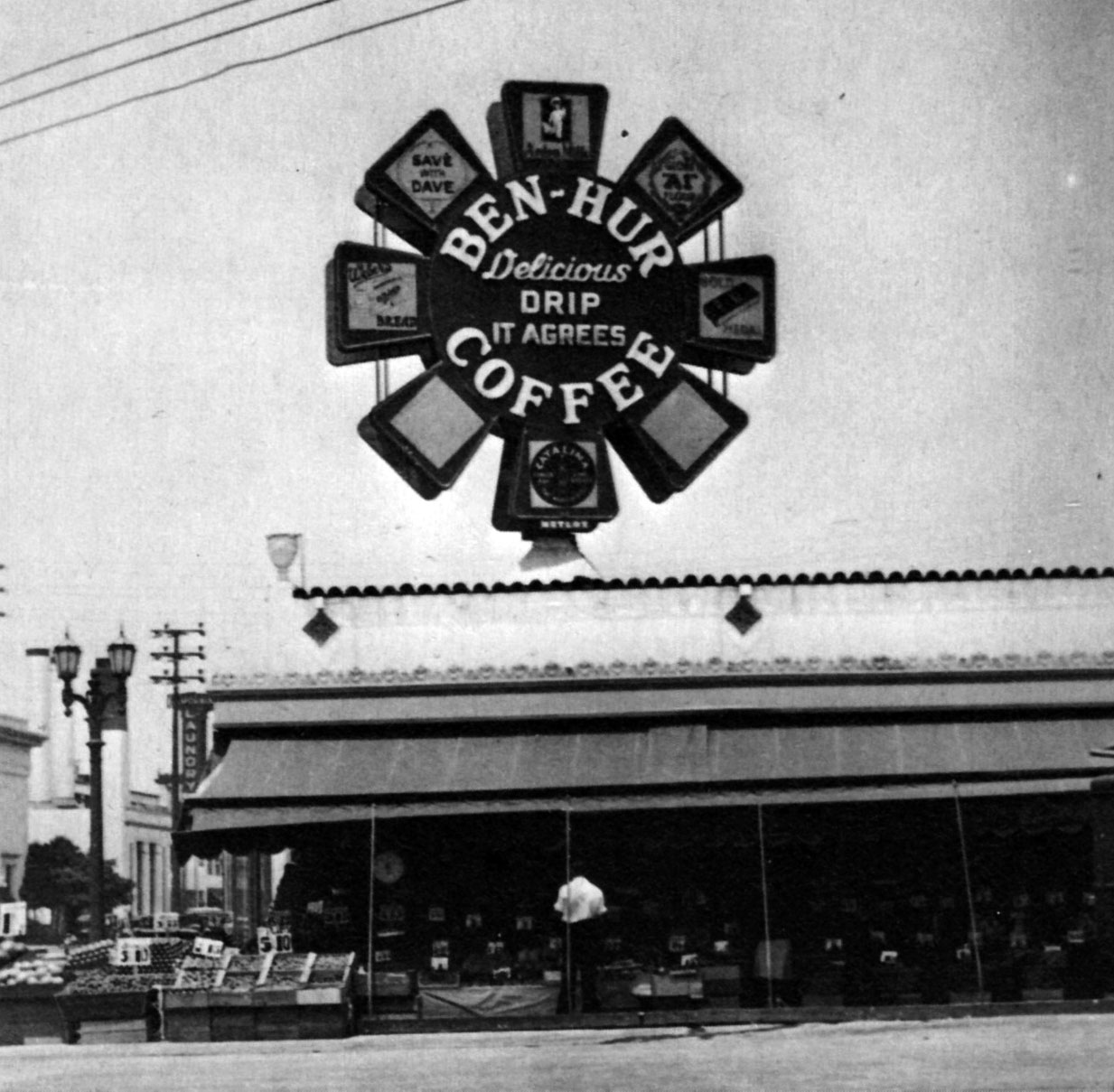 |
|
| (ca. 1937)*# – Ben-Hur Coffee: ‘The Starbucks of the 1930s’. View of a market on the northeast corner of Vine and Romaine streets with an oversized sign on top of its roof reading: “Ben-Hur Coffee – Delicious Drip – It Agrees” |
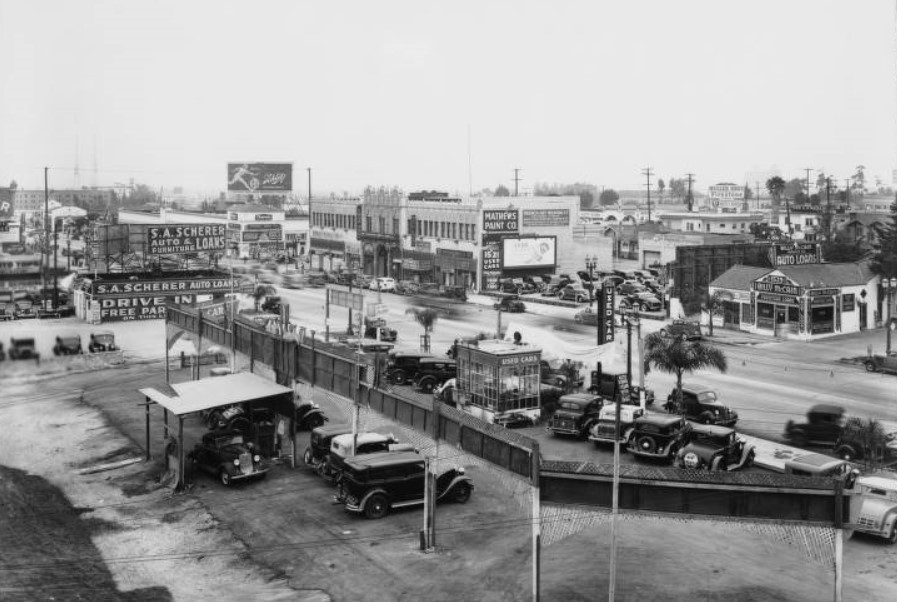 |
|
| (1937)^** - A slightly elevated view of property in Hollywood bordered by Sunset, Vine, Selma, and Argyle. The foreground is occupied by the Luger used car lot. Other businesses visible along the street are auto loan companies, a paint company, a drug store, and a chop suey company. |
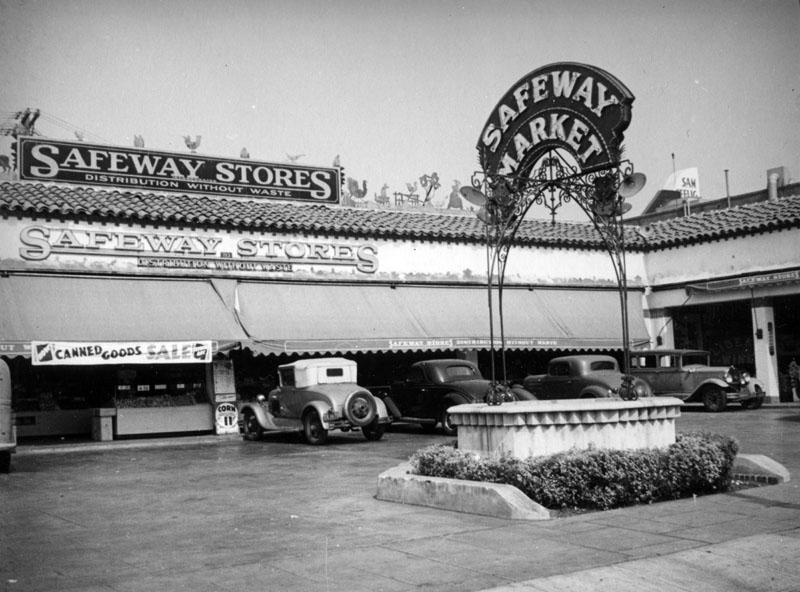 |
|
| (1937)* - View of the open air Safeway market with its Spanish tiled roof located on 5509 Sunset Boulevard near Western. Just behind the Safeway market on the upper right can be seen the sign board for the more modern Sam Seelig Market at 1515 N. Western. |
Historical Notes Sam Seelig Company was founded in April 1912 by Sam Seelig, who had come to California from Arizona in 1911. Seelig opened a single grocery store in Los Angeles at the corner of Pico and Figueroa streets. The chain had grown to 71 stores by 1922. After World War I, the firm became deeply indebted to its main grocery wholesaler, a firm owned by W.R.H. Weldon. In a swap of stock for debt, Weldon assumed control of the chain, leaving Seelig in charge of retail operations. Seelig then left the company in 1924 to enter the real estate business, forming Sam Seelig Realty. As a result of Seelig's departure, the company held a contest in 1925 to develop a new name, the result of which was Safeway. The original slogan was "an admonition and an invitation" to "Drive the Safeway; Buy the Safeway.” The point of the name was that the grocery operated on a cash-and-carry basis; it did not offer credit, as had been traditional for grocers. It was the "safe way" to buy because a family could not get into debt via its grocery bill (as many families did, especially during the Great Depression). By 1926, Safeway Stores had 322 stores centered in Southern California.*^ |
Hollywood and Highland
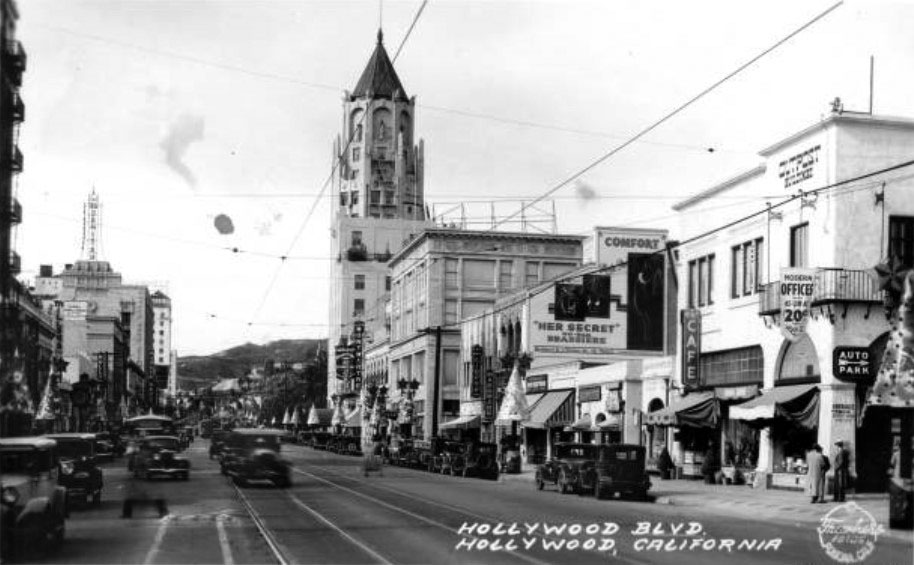 |
|
| (1936)^*^^ – Postcard view looking west on Hollywood Boulevard towards Highland Avenue where the 13-story First National Bank Building stands on the northeast corner. |
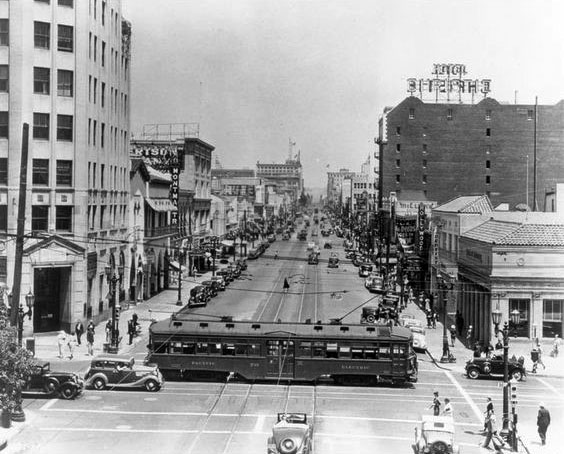 |
|
| (1936)#^* – View looking west on Hollywood Boulevard from Highland Avenue with the entrance to the 13-story First National Bank Building seen at left. The Hotel Christie can be seen in the upper-right. Note the long streetcar passing through the middle of the intersection. |
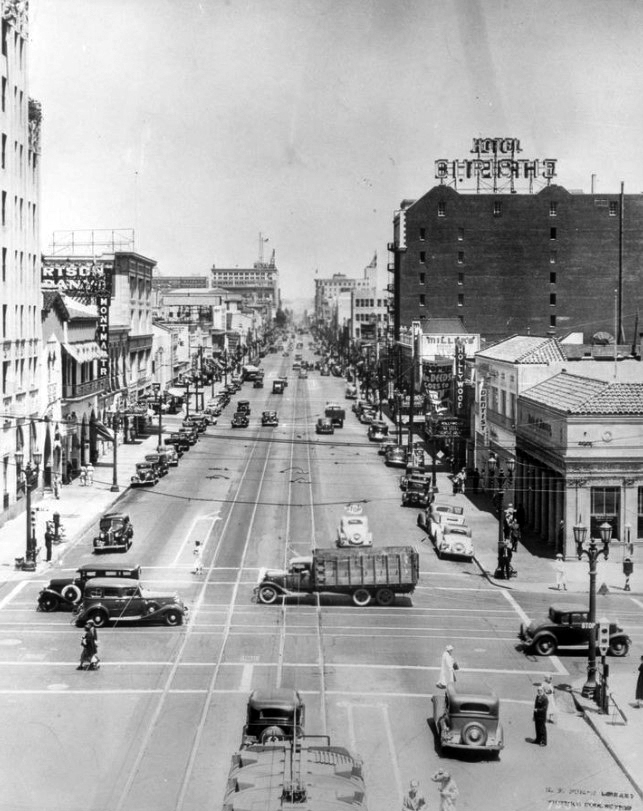 |
|
| (1936)^x^ - Hollywood & Highland, looking east towards Vine. The Hotel Christie (6724 Hollywood Blvd) is seen on the right, now more recently serving as the Church of Scientology Information Center. On the left, on the northeast corner, is the First National Bank Building. Note the Semaphore Traffic Signals on the corners. The Hollywood Theatre can also be seen at center-right. |
 |
|
| (1936)^.^ – Rooftop view looking east on Hollywood Boulevard at Highland Avenue. |
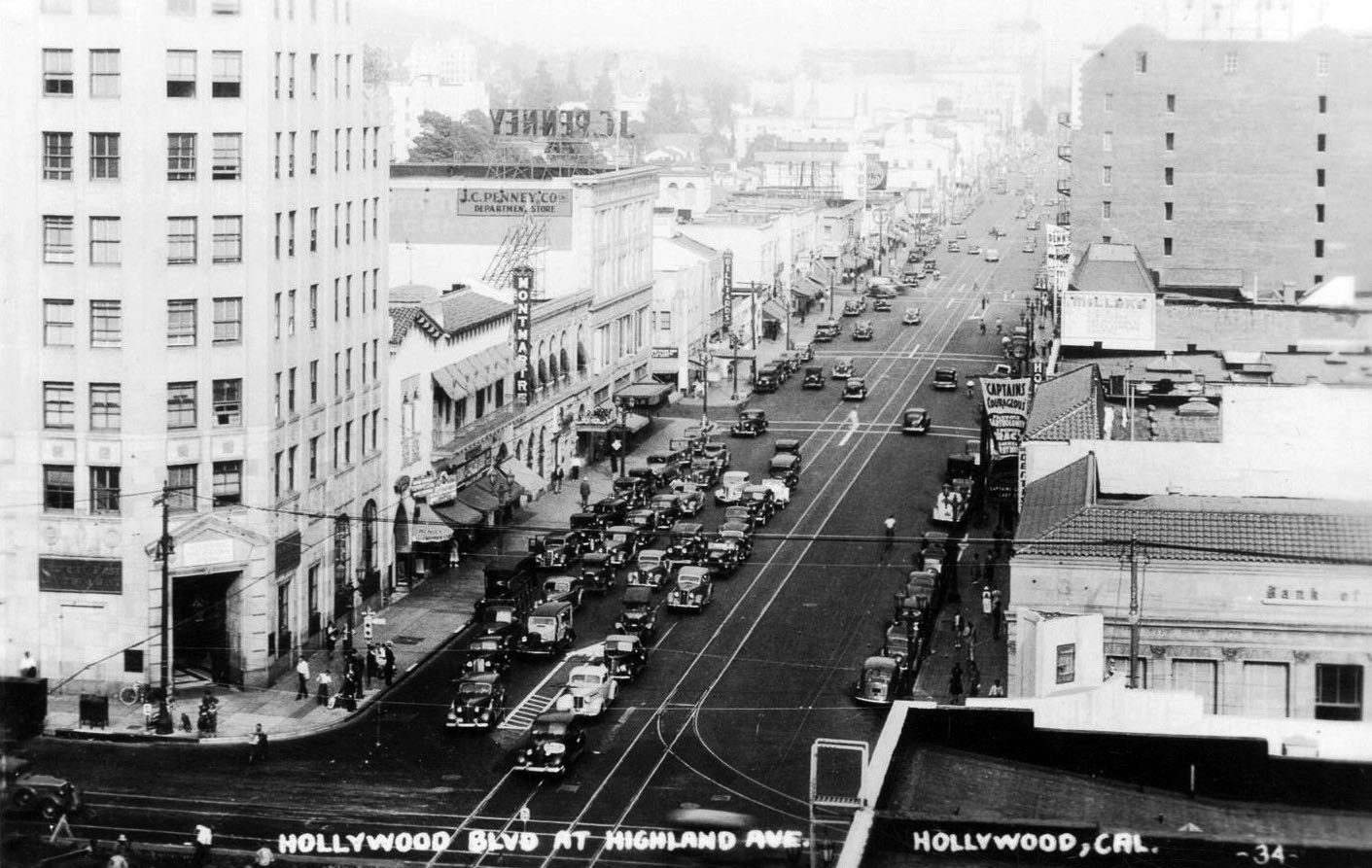 |
|
| (1937)**## – Postcard view looking east along Hollywood Boulevard at Highland Avenue. On the north side of Hollywood can be seen the 13-story First National Bank Building, Montmartre Café, and the new J.C. Penney. Across the street is the Hollywood Theatre showing “Captain Courageous” with Spencer Tracey. On the N/W corner (out of view) stands the Hollywood Hotel. |
 |
|
| (1936)^.^ - Street view looking east on Hollywood Boulevard from Highland Avenue . On the right can be seen the Hollywood Theatre and Hotel Christie. Note the ornate two-lamp streetlights* lining both sides of the Boulevard. The photo appears in the terrific book "Hollywood, The First 100 Years" by Bruce Torrence. Published by the Hollywood Chamber of Commerce in 1979, it's available on Amazon. |
Historical Notes *The ornate two-lamp streetlights seen above were called "Metropolitan Streetlights" and were developed especially for Hollywood in the early 1920s. They ultimately found their way onto the "best" streets of surrounding communities. The ‘Metropolitan’ is still quite common in Hollywood (Click HERE to see more). |
Then and Now
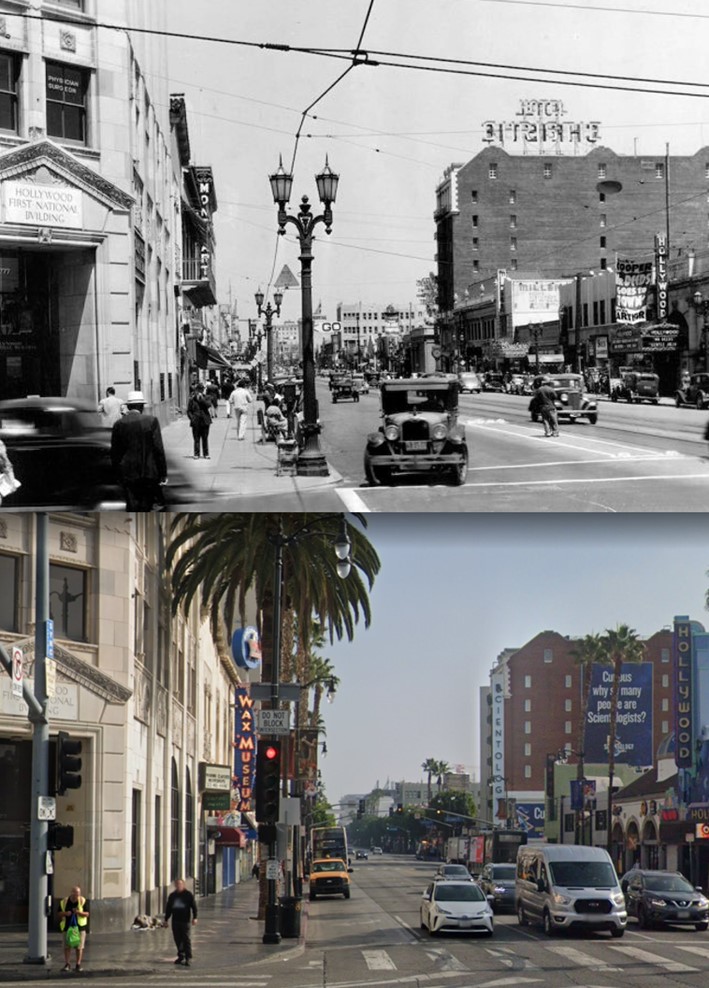 |
|
| (1936 vs. 2021)* - Hollywood and Highland looking East. |
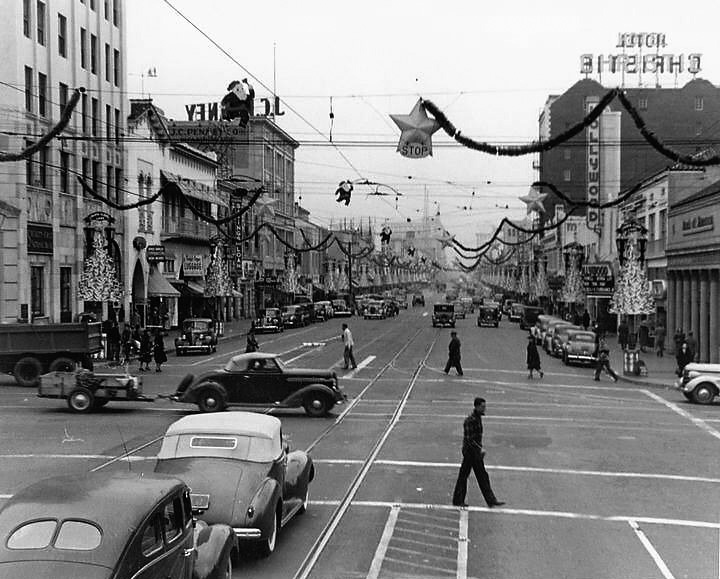 |
|
| (1938)^.^ - A look east on Hollywood Blvd. from Highland during the holidays. Note the decorations in the form of a Christmas tree surrounding the streetlights. |
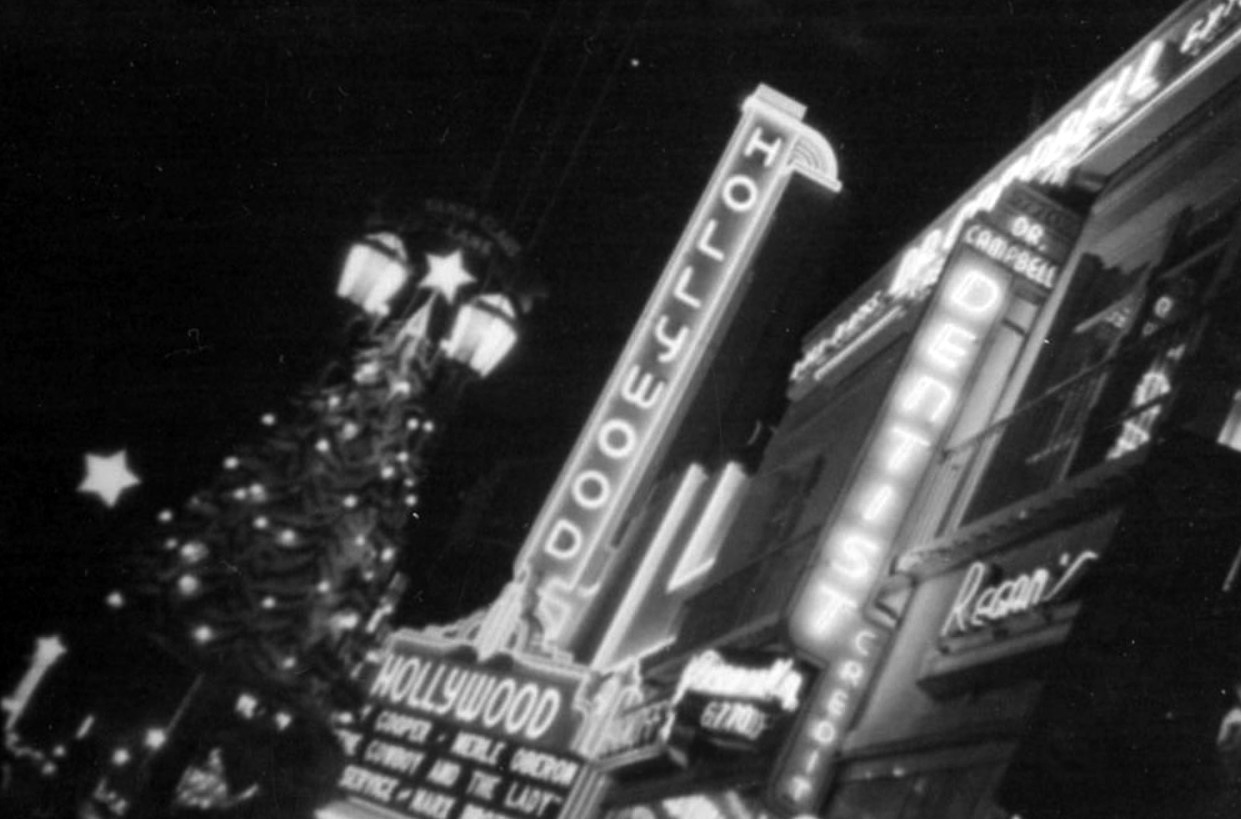 |
|
| (1938)* - Close-up view showing the Hollywood Theatre with neon sign and marquee. Now playing: "The Cowboy and the Lady" with Gary Cooper and Merle Oberon. Christmas tree decoration engulfs a streetlight on the left and another neon sign for a dentist office is seen on the right. Photo: Herman Schultheis |
Historical Notes Opened in 1913, this was Hollywood's second theatre and had an initial admission price of 10 cents. The facade was of white glazed brick with marble tile in the lobby. The auditorium featured Corinthian columns and a coffered ceiling. The owner of the project was H.L. Lewis. The Idle Hour had been the first theatre to open in Hollywood, in late 1910 or early 1911 (Click HERE to see more). |
.jpg) |
|
| (1938)* - Night time view showing the Hollywood Theatre located at 6764 Hollywood Boulevard. The marquee features films "Merrily We Live" and "Romance in the Dark". Businesses are seen on each side of the theater. |
Historical Notes Designed originally in 1913 by architects Kremple and Erkes, the theater got a remodel in 1927 by Clifford Balch. Another renovation and redesign by S. Charles Lee occurred in 1936 where the original white brick façade was replaced with a deco version. The signage currently on the building is from that remodel. A final remodel took place in 1977. In the early 1990s, the theatre became a venue for the Guinness Book of World Records. (Click HERE to see more). |
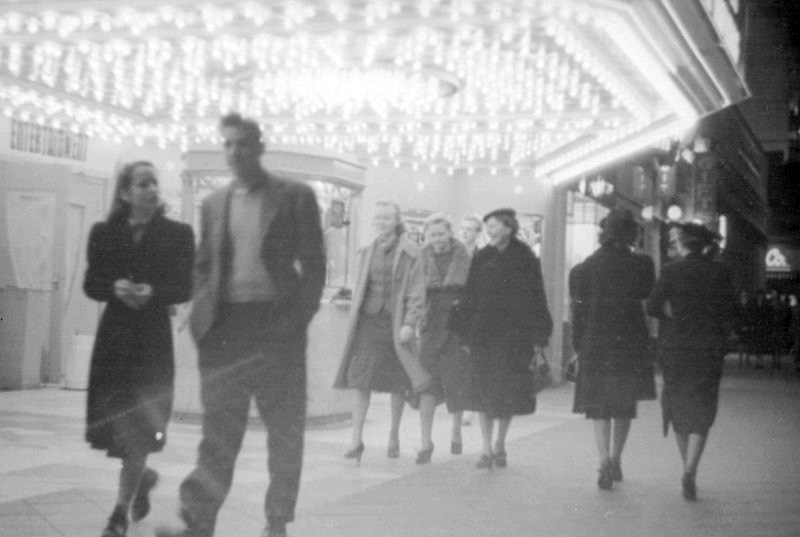 |
|
| (1938)* – Close-up view showing people walking along Hollywood Boulevard in front of a well-illuminated Hollywood Theatre. Photo by Herman Schultheis. |
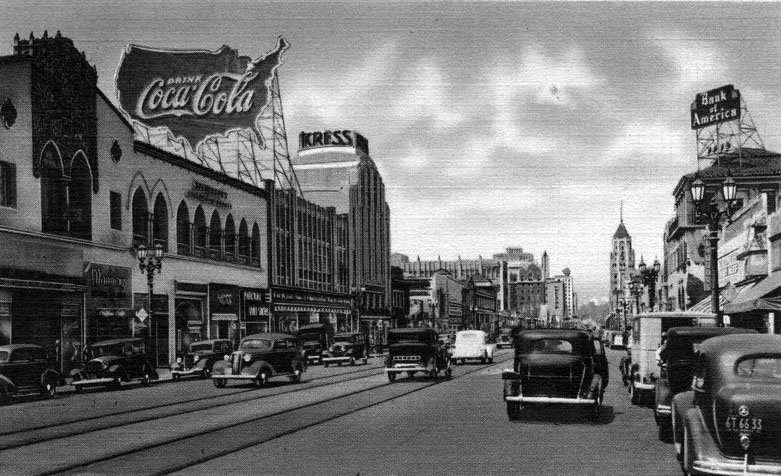 |
|
| (ca. 1937)^*# – Postcard view of Hollywood Boulevard looking west toward Whitley Avenue. A large Coca Cola sign is seen on top of the J.J. Newberry Building. The next tall build behind it is the Art Deco-style Kress Building. On the right in the distance is the First National Bank Building. |
Kress Building (later home of Frederick's of Hollywood)
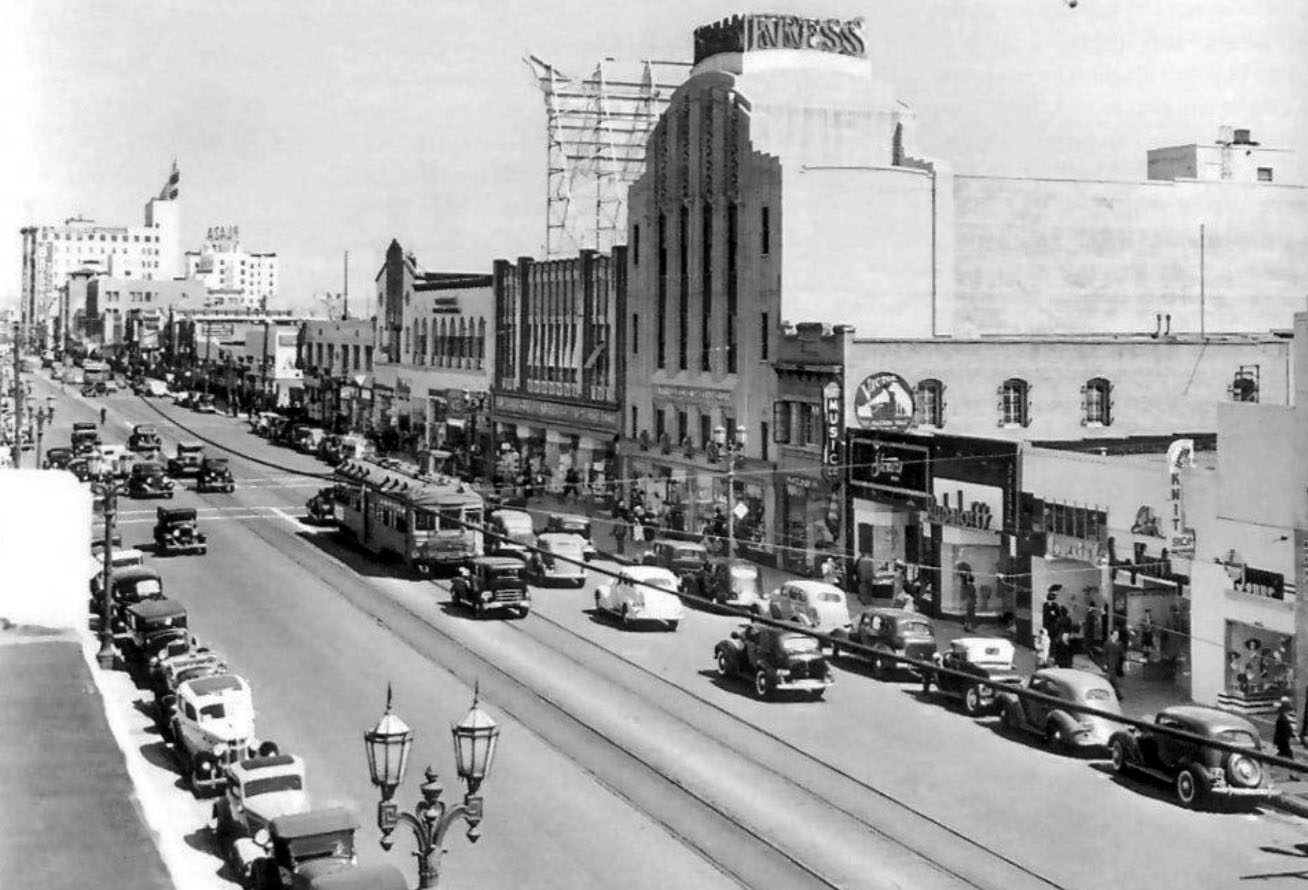 |
|
| (1937)^##* - View looking east on Hollywood Boulevard toward Whitley Avenue. At right is the 5-story Art Deco Kress Building. |
Historical Notes S. H. Kress & Co. was a national chain of 5-10-25 cent department stores. They operated from 1896 to 1981 but were most popular from the 30s into the 50s. This store stood on Hollywood Blvd right next to a “five-and-dime” competitor, J.J. Newberry. This Kress Building is still there, including the red neon sign at the top, and it’s been fully and beautifully restored. |
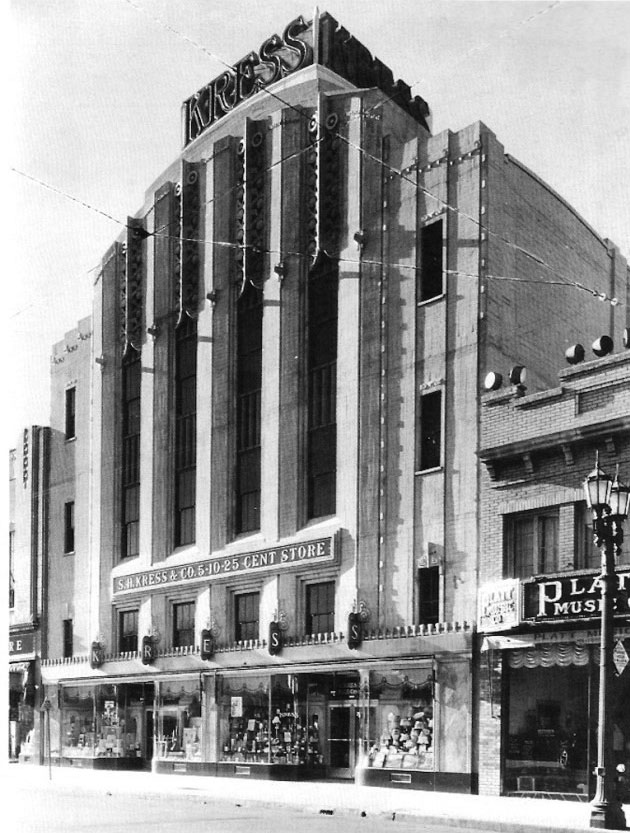 |
|
| (1934)**## – Close-up view of the Kress Building located at 6608 Hollywood Boulevard. Sign over front entrance reads: S. H. Kress & Co. 5–10–25 Cent Store. |
Historical Notes The chain’s founder, Samuel H. Kress (1863–1955), took architecture seriously. His Hollywood Boulevard store (1934) was a Hollywood spectacular, designed in an Art Deco style by S.H. Kress & Co. chief architect Edward F. Sibbert.^ |
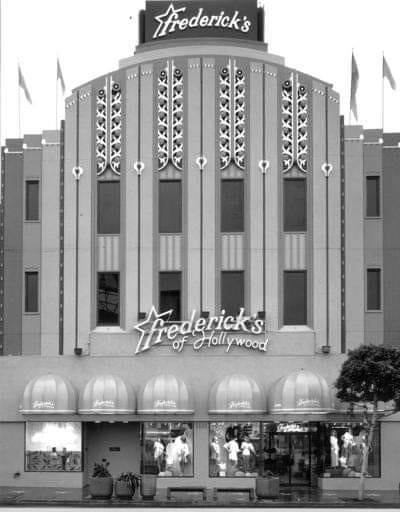 |
(n.d.)^.^ - View showing the Kress Building now occupied by Frederick’s of Hollywood. | |
Historical Notes In 1946, Frederick Mellinger opened Frederick's Fifth Avenue in New York, a mail-order business selling products that his World War II Army friends told him their girlfriends would like. A year later Mr. Mellinger moved the store to the West Coast into the Kress Building, where the bright purple Art Deco-style headquarters on Hollywood Boulevard became a landmark. |
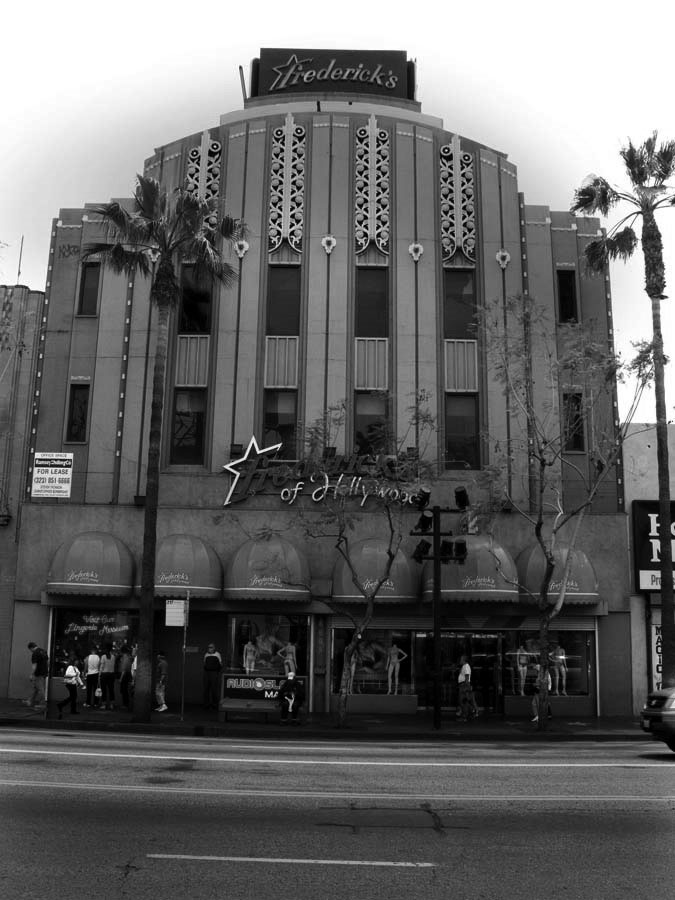 |
|
| (2005)^.^ - Frederick’s of Hollywood Lingerie Museum, Hollywood, CA. |
Historical Notes From 1949 to 2005, the building housed lingerie retailer Frederick’s of Hollywood. Within the landmark store, Frederick’s of Hollywood Lingerie Museum featured lingerie worn by celebrities in movies. The exhibit even included the bra worn by Tony Curtis in Some Like It Hot (1959). In September 2005, after 59 years, the store moved to a larger space a few blocks away, near the corner of Hollywood Boulevard and Highland Avenue. |
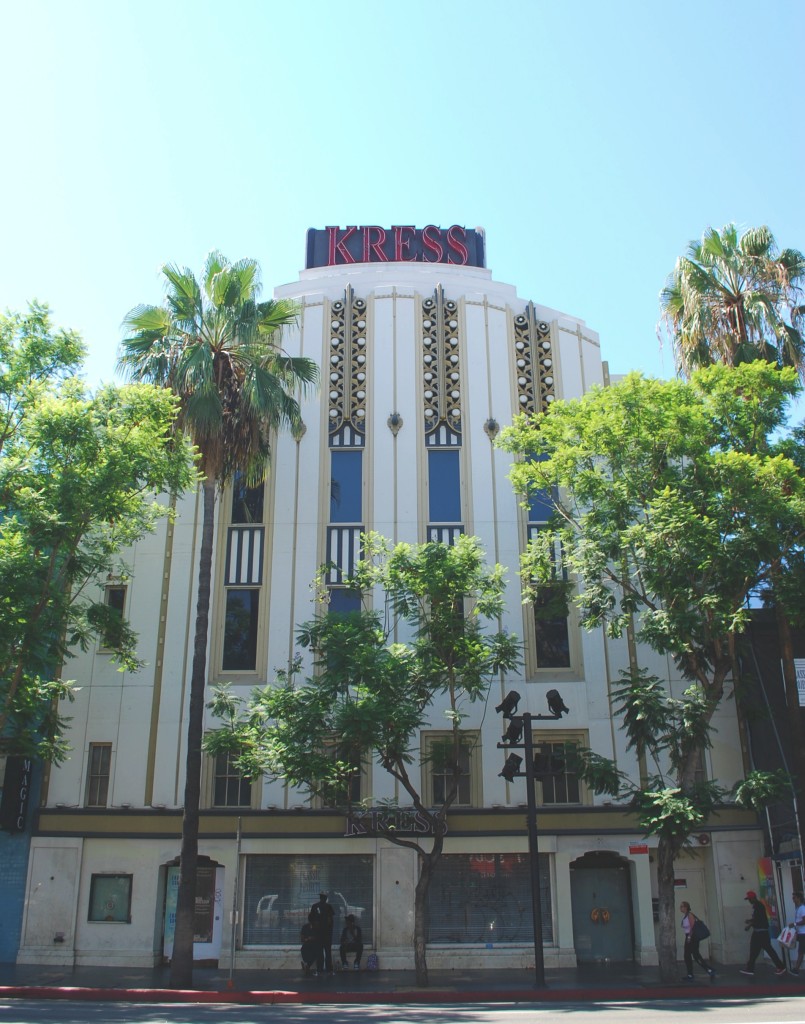 |
|
| (ca. 2018)^^ - View of the Kress Building as it appears today, 6608 Hollywood Boulevard. The building was previously the office and retail headquarters for Frederick' s of Hollywood and later operated as the Kress nightclub and restaurant. |
Historical Notes In 2008, after a multi-year restoration, the Kress name went back onto the building—but not as a sign for an S.H. Kress & Co. variety store. That chain disappeared from U.S. cities in 1981. The building became the short-lived Kress Hollywood nightclub and restaurant. Currently the building is unoccupied (Jan. 2019). |
Hollywood and Cherokee
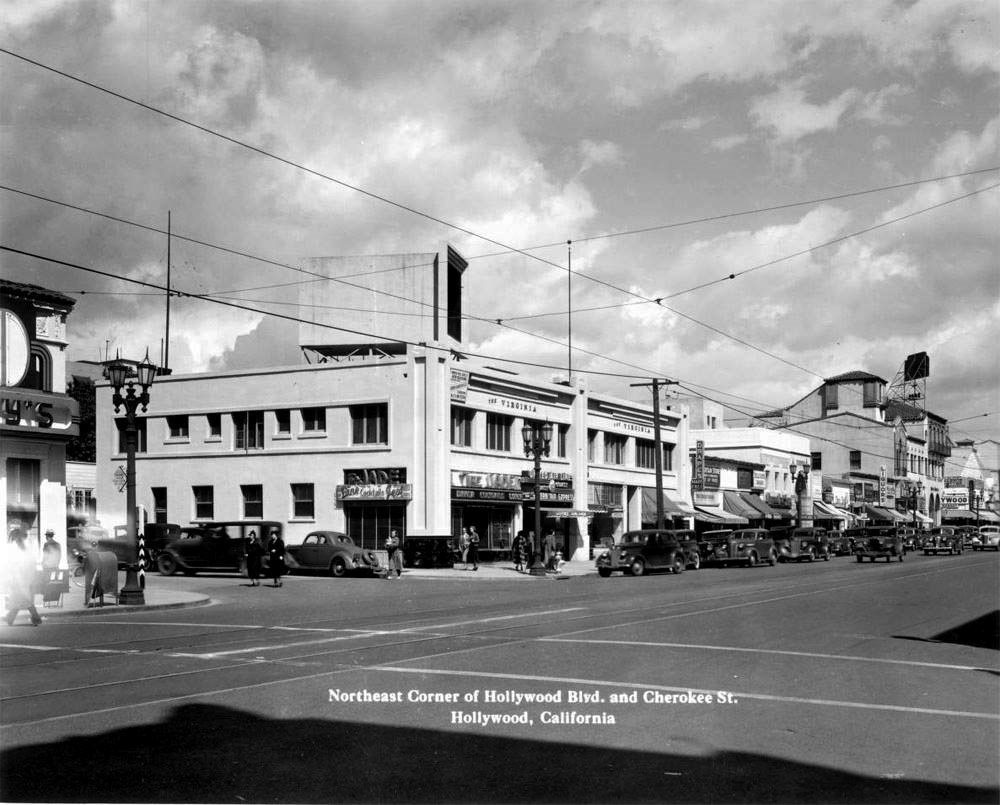 |
|
| (ca. 1939)* – View looking east on Hollywood Boulevard at Cherokee Street (3 blocks east of Highland). The building on the NE corner will soon become a Sontag Drug Store, after a remodel. The building on the NW conrer would become future home of M'Goos Pizza. |
 |
|
| (1940s)* - Looking east on Hollywood Boulevard at Cherokee Avenue with Sontag Drug Store on the NE corner. Today, ‘Escape Hotel’, a live entertainment venue with escape rooms, occupies this building. Click HERE for contemporary view. |
Historical Notes Sontag Drug Stores was one of the largest drug store chains in the U.S. in the 1930’s & 1940’s. It was also one of the first to allow customers to browse and choose their own products rather than requesting them from a clerk behind a counter. All in all, there were 16 Sontag Drugs located in Los Angeles, and another 32 in other locations – for a total of 48 stores. Their Los Angeles headquarters was located at the corner of Wilshire Blvd. and La Cienega Blvd. (torn down and replaced at one time with the Flynt Building).^ |
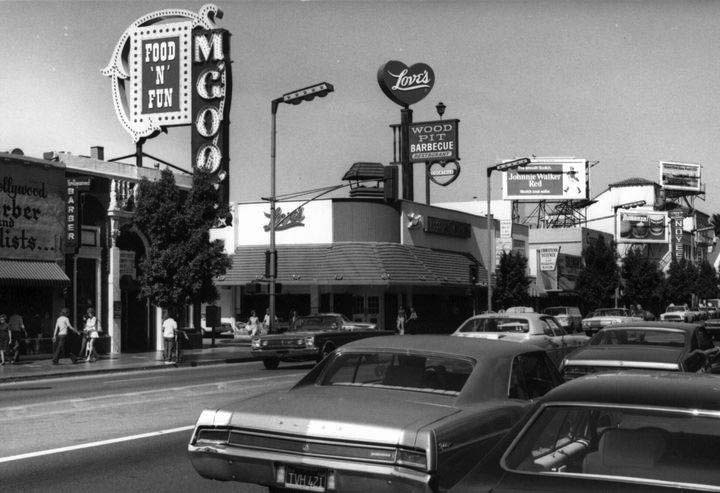 |
|
| (1976)* – View looking east on Hollywood Boulevard toward Cherokee Avenue. On the northeast corner stands Love’s BBQ Restaurant where Studio Cafe is today. Across the street, on the northwest corner is M’Goo’s Pizza which today is a souvenir store. Click HERE to see contemporary view. |
Historical Notes M'Goo's opened in 1959 at the northwest corner of Hollywood and Cherokee. M'Goo's Food 'n Fun - was a fun old time Irish themed restaurant. Owner Marty Bryman sold beer by the pound (6 lbs for $2.50) and champaign by the bubbles - in a glass slipper. |
Hollywood Hotel
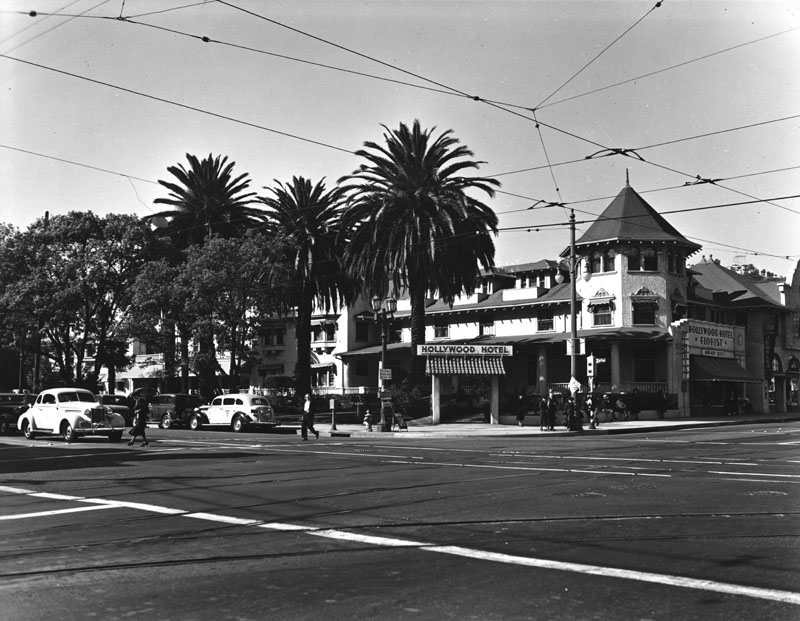 |
|
| (ca. 1937)* - The Hollywood Hotel, located on the northwest corner of Hollywood Boulevard and Highland Avenue. |
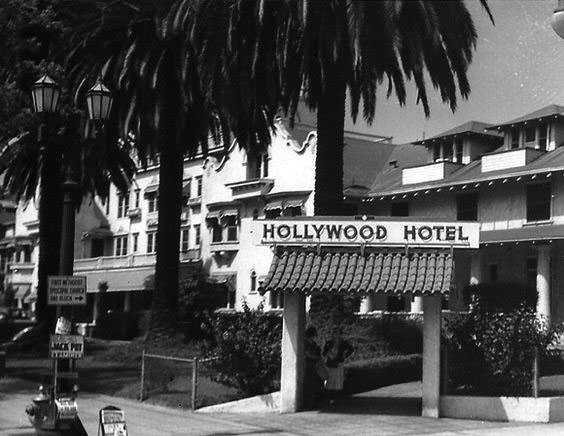 |
|
| (ca. 1937)#**# – Close-up view showing two women standing under the archway in front of the Hollywood Hotel near the NW corner of Hollywood and Highland. |
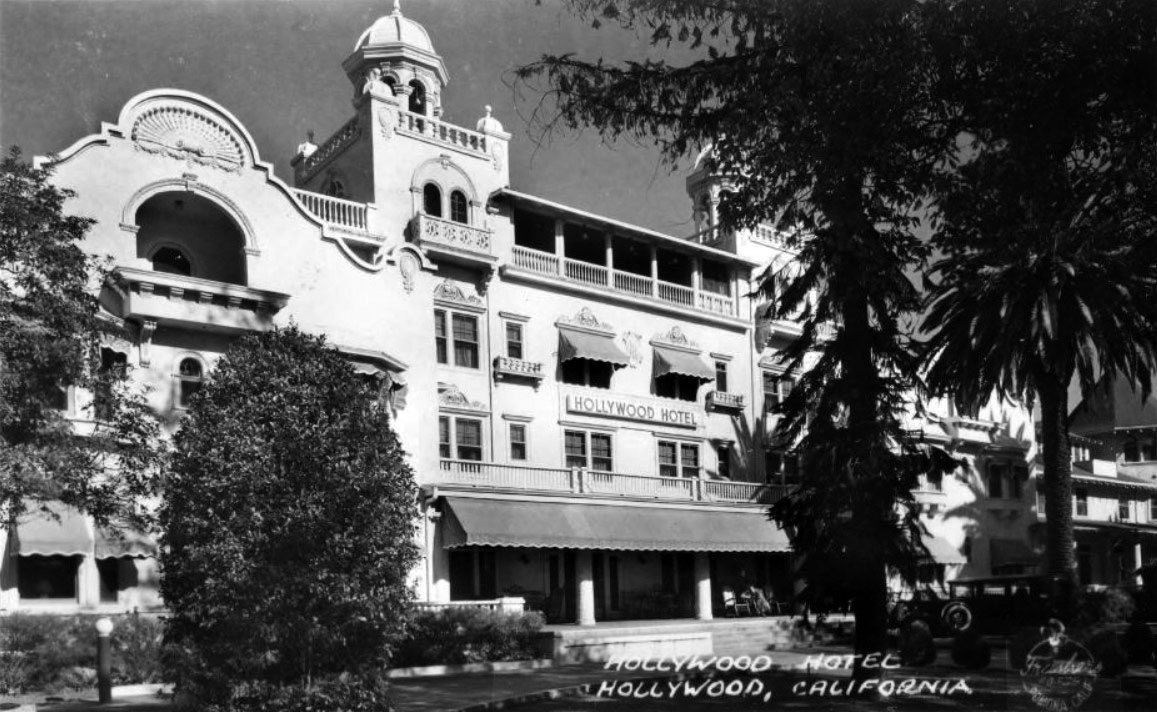 |
|
| (1938)*^#* – Front view of the Hollywood Hotel with early model car parked in front. |
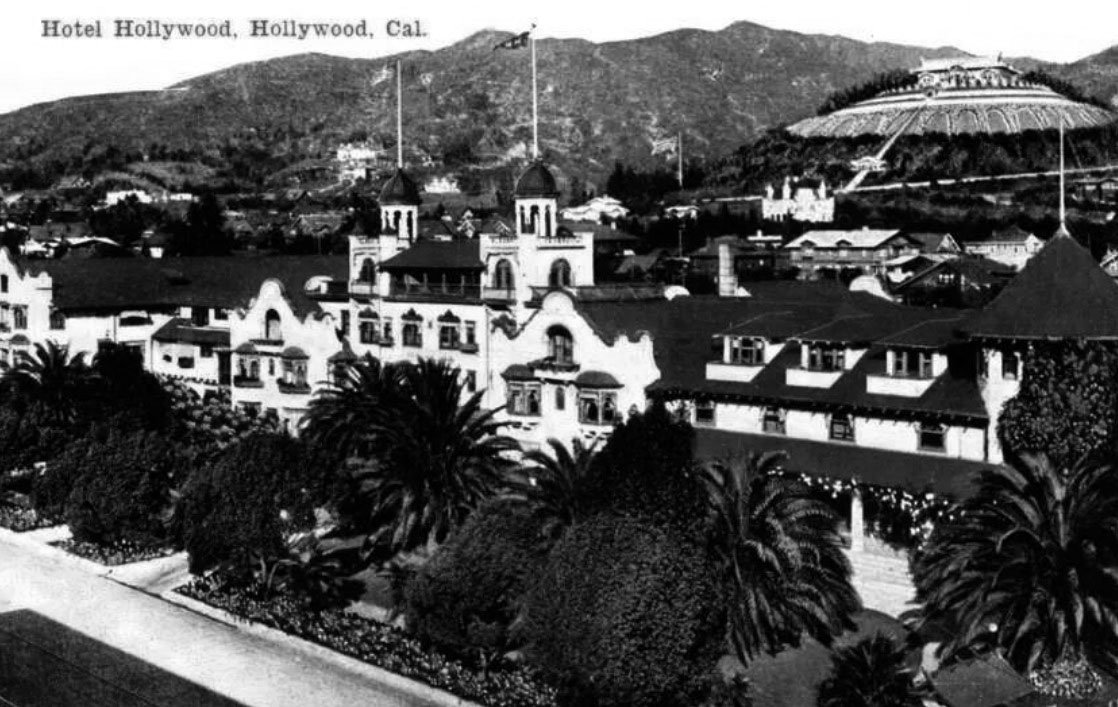 |
|
| (1940)##^* – Postcard view showing the Hollywood Hotel located on the northwest corner of Hollywood and Highland. The hilltop Japanese estate and gardens of brothers Charles and Adolph Bernheimer can be seen in the upper right corner. |
Historical Notes Though the Hollywood Hotel housed many of the great stars in its day, it was razed in August 1956 to make way for a $10 million development, with a twelve story office building for the First Federal Savings & Loan Association of Hollywood, a shopping center and parking lots. In 2001, the Hollywood and Highland entertainment complex, which includes the Hollywood and Highland Center, the current home of the Academy Awards, was constructed on the site.*^ After WWII, the Bernheimer home was remodeled and converted into apartments. Soon thereafter, Thomas O. Glover purchased the property and began the restoration of what was to become the Yamashiro restaurant.* |
Click HERE to see more Early Views of the Hollywood Hotel |
Hollywood Boulevard
.jpg) |
|
| (1937)* - View of Hollywood Boulevard looking west from one and a half blocks east of the intersection of Hollywood and Vine Street on July 21, 1937. There are a few cars on the street, as well as streetcar tracks. The Taft Building is at left, and the Equitable Building and Pantages Theatre at right. |
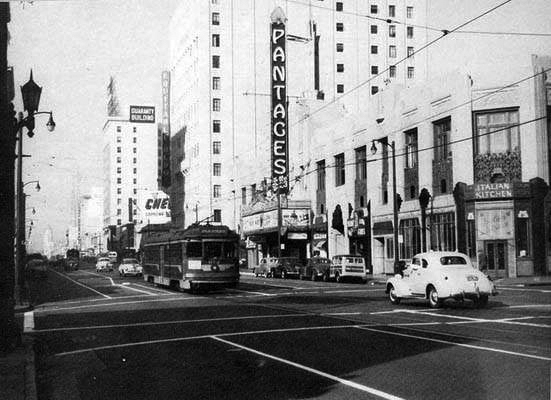 |
|
| (ca. 1938)* – View looking west on Hollywood Boulevard at Argyle Avenue showing a streetcar heading east across the street from the Pantages Theatre. |
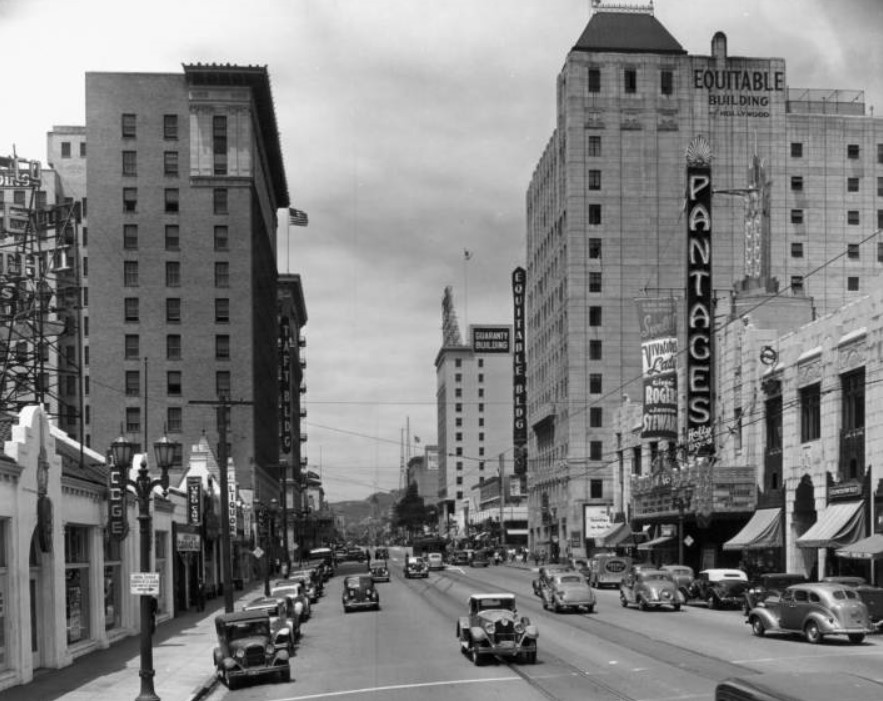 |
|
| (ca. 1938)^^ - View looking west on Hollywood Boulevard showing the Pantages Theatre on the right. One block to the west is the intersection of Hollywood and Vine where three taller buildings stand (Equitable Building, Taft Building, and Broadway-Hollywood Building). |
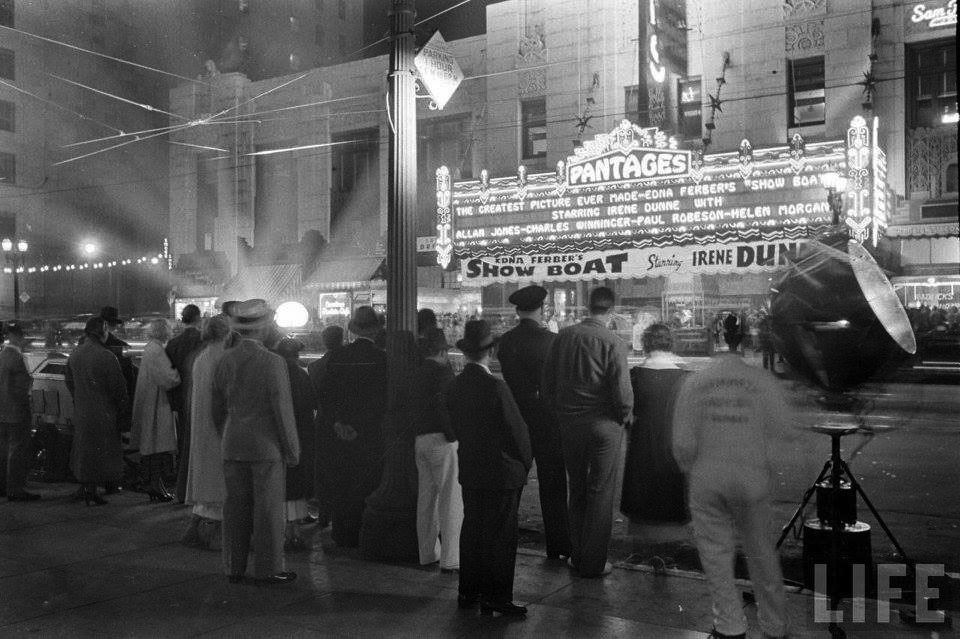 |
|
| (1936)#**# – Life Magazine photo showing a crowd gathered across Hollywood Boulevard from the Pantages Theatre as Universal Pictures hold a whiz-bang premiere for “Show Boat”. Notice how the marquee claims it is “The Greatest Picture Ever Made”. |
 |
|
| (ca. 1938)* – View looking east on Hollywood Boulevard at Sycamore Avenue with the Roosevelt Hotel seen in the background. |
.jpg) |
|
| (1937)* - Hollywood Boulevard looking east from Sycamore Ave. In the background are First National Bank Building, the Roosevelt Hotel and the Chinese Theater. First National Bank Building was designed by Meyer and Holler. |
Historical Notes The thirteen story First National Bank Building with Gothic/Renaissance elements a la Art Deco is one of a handful of structures in the city that is adorned with gargoyles. It was the tallest building in Los Angeles from 1927 to 1932.* |
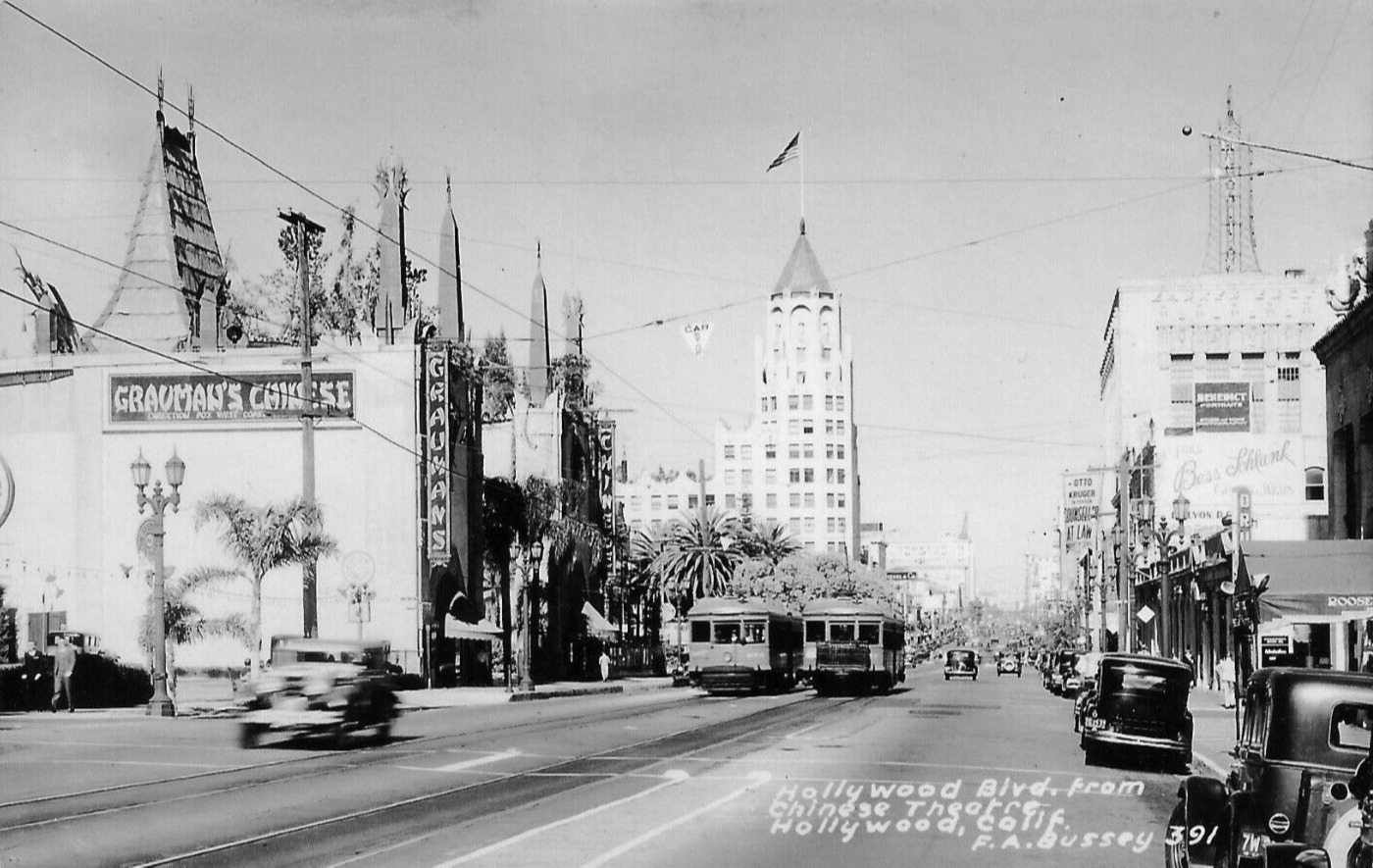 |
|
| (1933)* - Postcard view of Hollywood Boulevard looking east. Two streetcars are seen passing each other in front of the Chinese Theatre. The Art Deco First National Bank Building stands on the northeast corner of Hollywood Boulevard and Highland Avenue. A very large American Flag flys above its Gothic-style tower. |
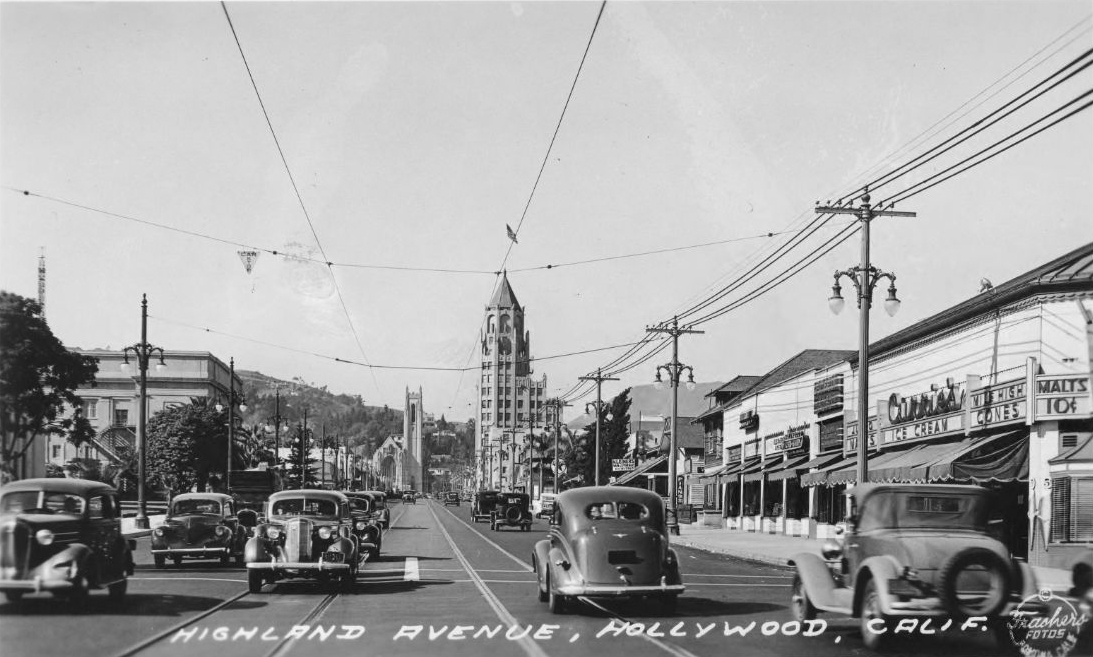 |
|
| (1937)*^## - Looking north on Highland Avenue near Sunset Boulevard. Hollywood High School can be seen at far left, and in the center distance are the Hollywood United Methodist Church and the Hollywood First National Bank Building.^^ |
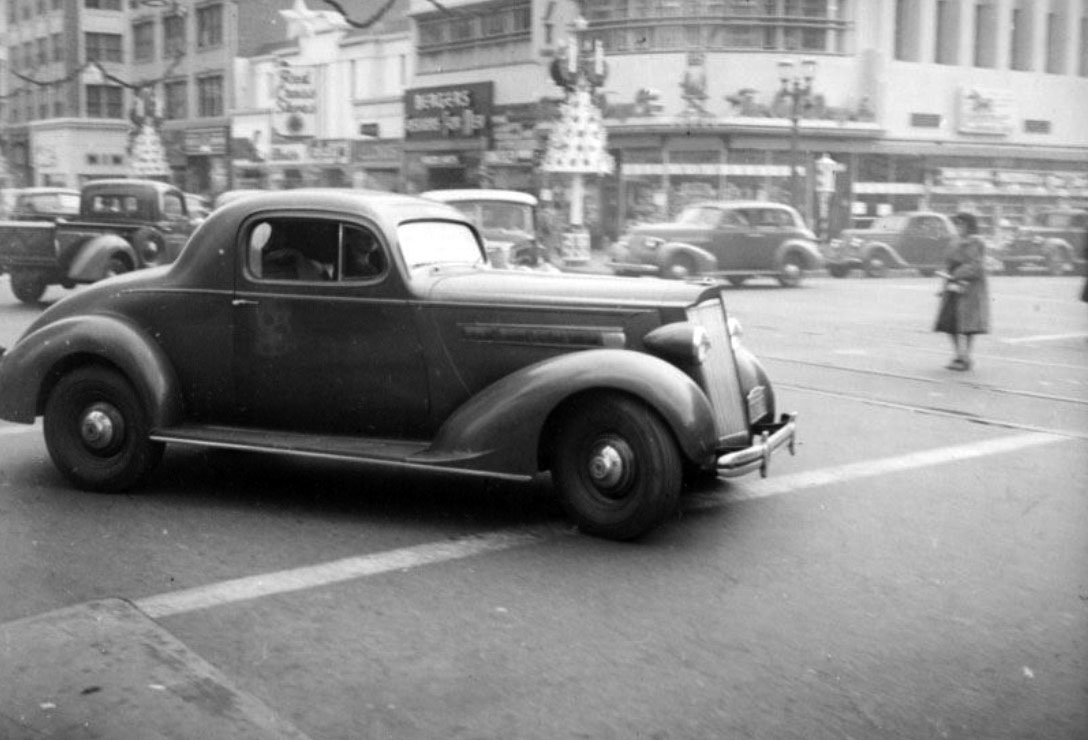 |
|
| (1937)* - View showing a 1936 Packard 120 Straight Eight Coupe making a right turn onto Hollywood Boulevard from Cahuenga. Photo by Herman Schulteis |
Historical Notes Packard was an American luxury automobile marque built by the Packard Motor Car Company of Detroit, Michigan, and later by the Studebaker-Packard Corporation of South Bend, Indiana. The first Packard automobiles were produced in 1899, and the last in 1958. According to many people the introduction of the Packard 120 (seen above) was Packard's savior in the '30's during the final years of the Great Depression.*^ |
Currie's Ice Cream
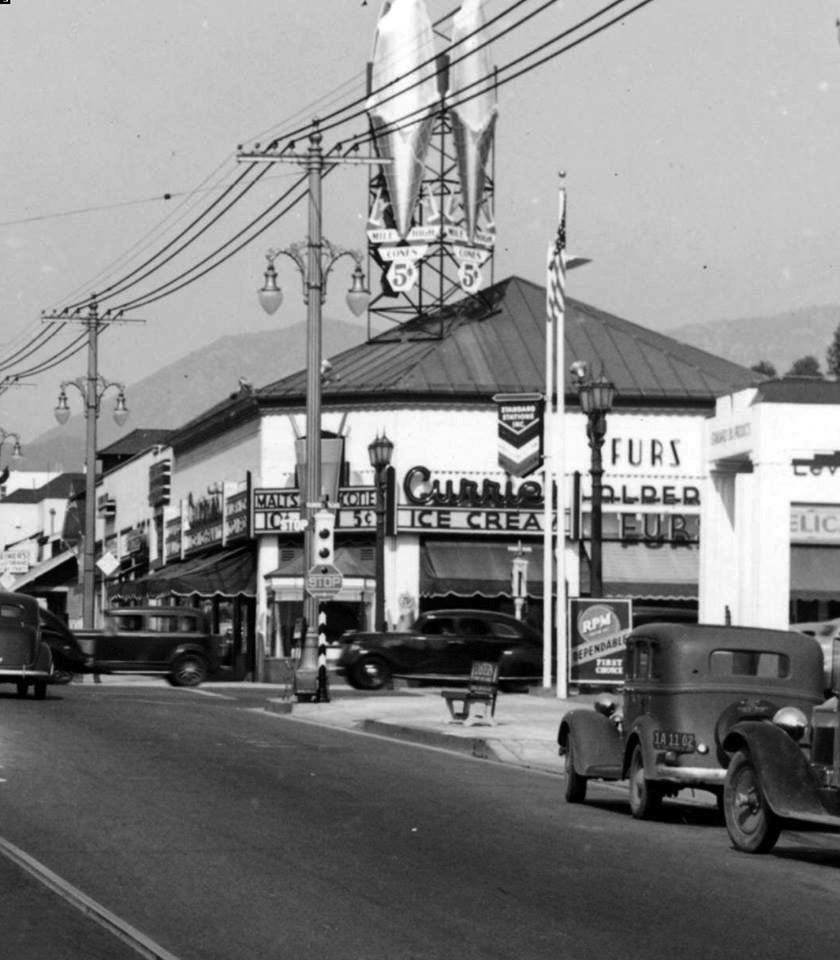 |
|
| ((ca. 1936)* – View looking north on Highland Avenue toward Sunset Boulevard. Currie’s Ice Cream parlor is seen on the northeast corner with its Mile High Cone sign on the roof. |
Historical Notes People still fondly remember the Currie’s chain and its “mile-high cone” whose replica was often displayed billboard-style on roofs. The chain was started in 1927 by three brothers named Kuhns. After WWII they sold it to the Good Humor Company who later sold it to Lipton in the 1960s. In 1964 the chain opened its 87th store, in North Hollywood. Although Currie’s anticipated launching units in every community in Southern California, only three outlets were listed in the 1967 Los Angeles phone book and the chain had disappeared by the 1980s. +##+ |
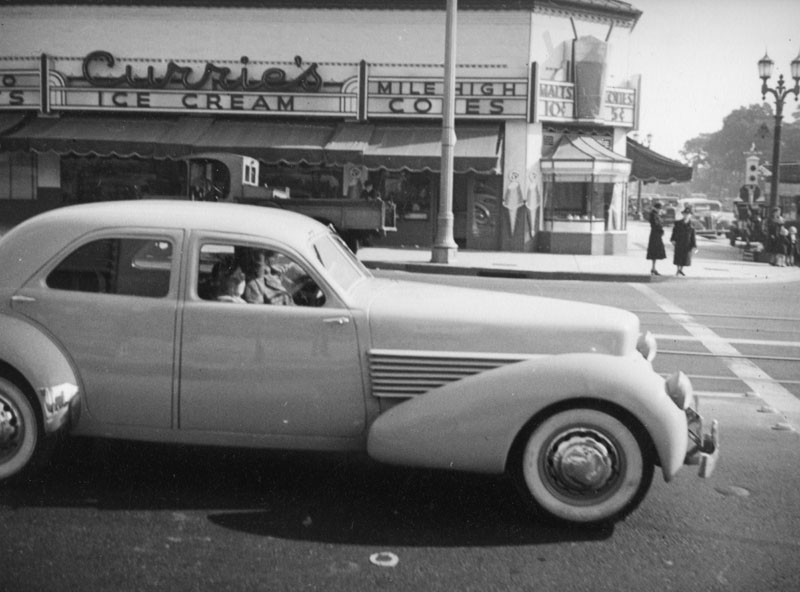 |
|
| (1937)* - A 1936 Auburn Cord 812 Westchester stops on Highland at the intersection of Sunset in front of Currie's Ice Cream shop, which is located on the NE corner at 6775 Sunset Boulevard. A dimensional sign that looks like a soda with two straws seems to illustrate the claim that the store featured "mile high cones." |
Historical Notes Cord was the brand name of an American automobile company from Connersville, Indiana, manufactured by the Auburn Automobile Company from 1929 through 1932 and again in 1936 and 1937.*^ |
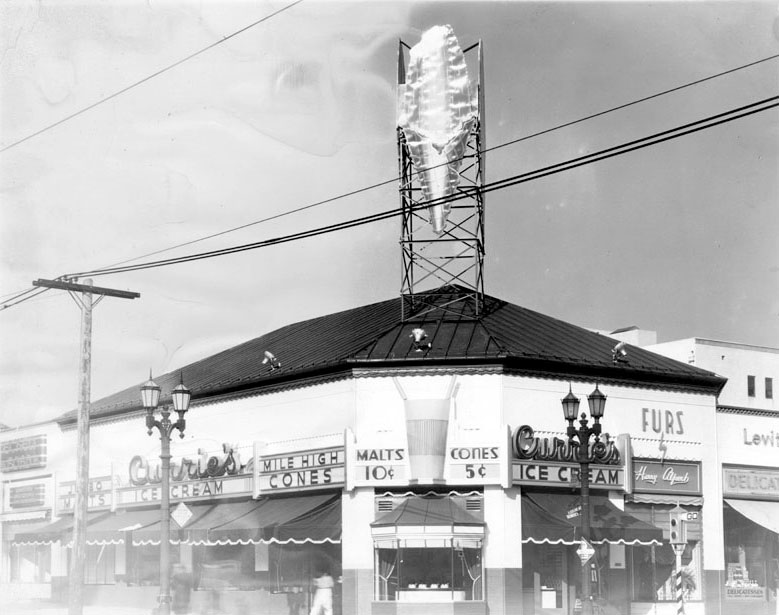 |
|
| (ca. 1940s)* - Close-up view of Currie's Ice Cream parlor on the northeast corner of Sunset Boulevard and Highland Avenue across the street from Hollywood High School. An enormous piece of metal in the shape of an ice cream cone is displayed on the roof. Signs above the awnings read, "Jumbo malts", Mile high cones", "Malts .10 cents" and "Cones .5 cents". The shop next door has a sign that reads, "Furs by Harry Alpert", and the one next to that is a delicatessen. The northeast corner of Sunset and Highland is now a mini mall. Click HERE to see contemporary view. |
Historical Notes Most of the buildings that housed Currie's Ice Cream had the larger than life cone on top of the building. These “hey-you-can’t miss-me!” buildings (referred to as Novelty or Programmatic Architecture) were made to pull automobile drivers right off the road. Click HERE to see more examples of Programmatic Architecture. |
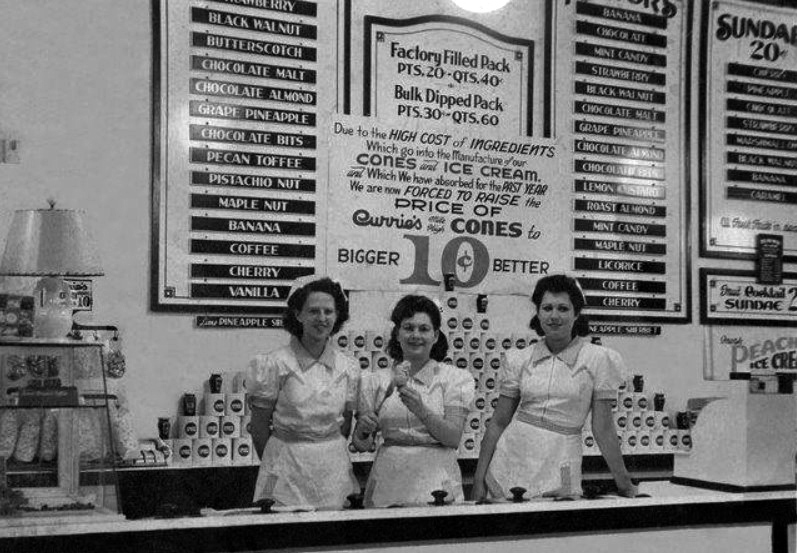 |
|
| (n.d.)^.^ - Interior view of Currie’s. 40 cents for a quart of ice cream and they're apologizing for having to raise the prices. Yikes! |
* * * * * |
Hollywood and Vine
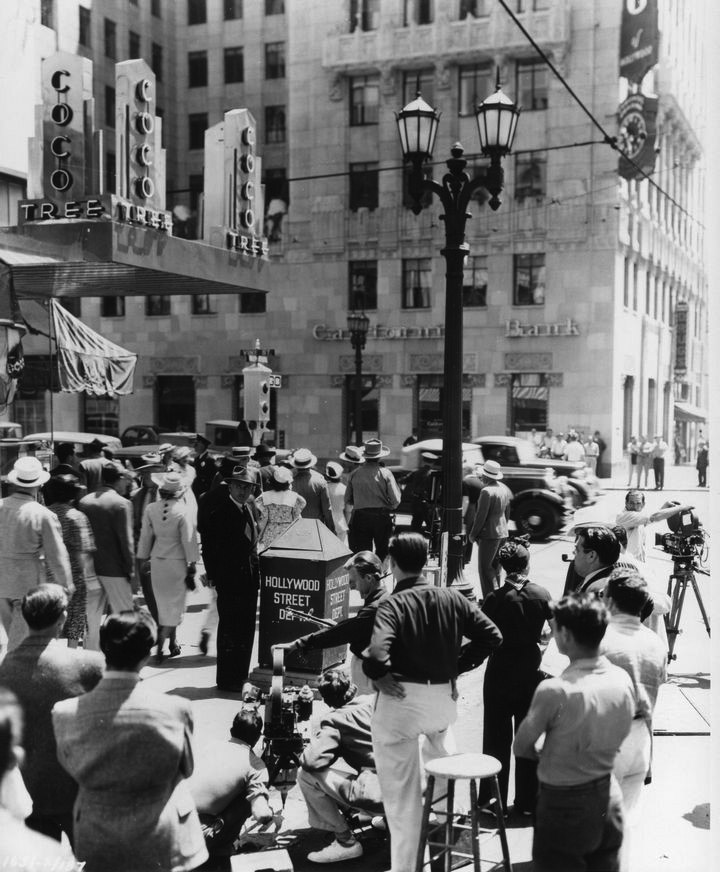 |
|
| (1936)*# - View showing some filming in front of the CoCo Tree Café on the northwest corner of Hollywood and Vine with the Equitable Building in the background. |
Historical Notes Carl Laemmle’s vision was to build a 900 seat theatre and office tower on this corner. However, the depression thwarted his plan so he opened the CoCo Tree Café and used the top of the building to advertise his Universal Pictures. Click HERE to see more in N/W Corner of Hollywood and Vine. |
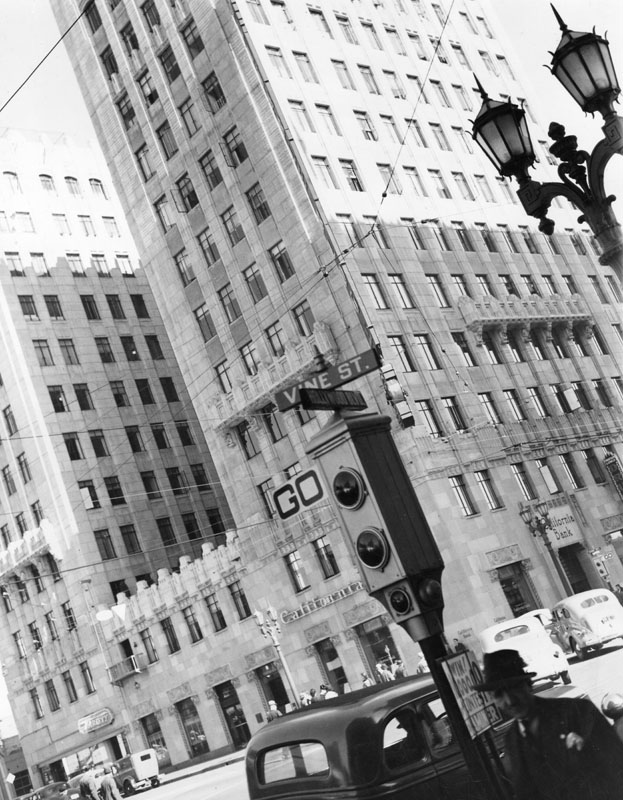 |
|
| (1938)* - Traffic signal at Hollywood and Vine, looking northeast, with the Equitable Building in the background. An ornate two-lamp streetlight is at the upper-right of photo. Click HERE to see more in Early L.A. Streetlights. |
* * * * * |
Ivar and Yucca
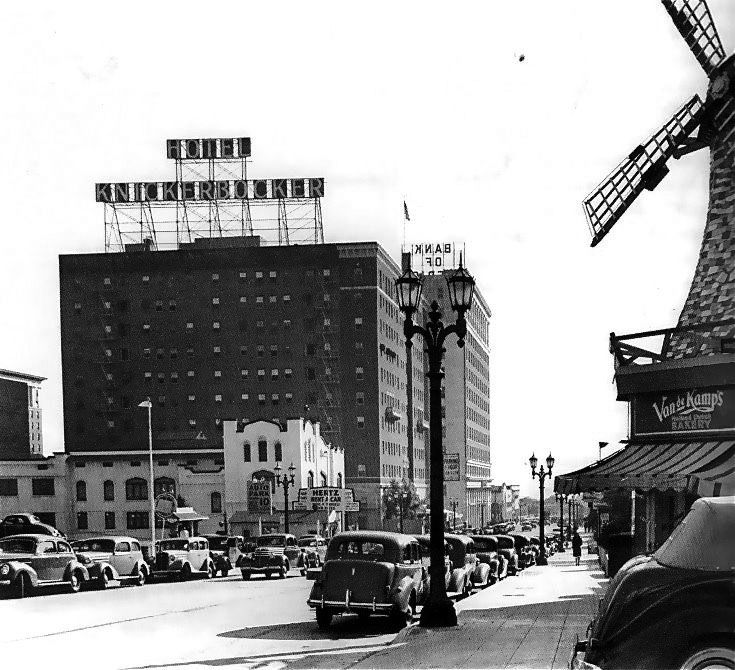 |
|
| (1938)#**# – View looking south on Ivar Avenue from Yucca Street towards the Hotel Knickerbocker. The iconic windmill of the Van de Kamp’s coffee shop dominates the S/W corner of Ivar and Yucca. The Glen-Holly Hotel once stood where the Van De Kamp's is seen above. It was the 2nd hotel to be built in Hollywood (1895). Click HERE to see contemporary view. |
Historical Notes Theodore J. Van de Kamp and brother-in-law Lawrence L. Frank were the owners and originators of the Van de Kamp Bakeries. Fondly known as the "Taj Mahal of all bakeries". Van de Kamp and Frank also founded both the Tam O'Shanter's (1922) and Lawry's Prime Rib Restaurant (1938) restaurants. The bakery was sold by the Van de Kamp family and acquired by General Baking Co. in 1956. The company was sold to private investors in 1979, and closed in bankruptcy in 1990. Former Los Angeles County District Attorney John Van de Kamp is a grandson of the baker's founder. *^ Click HERE to see Van de Kamp's 1st Windmill Bakery Shop. |
Hotel Knickerbocker
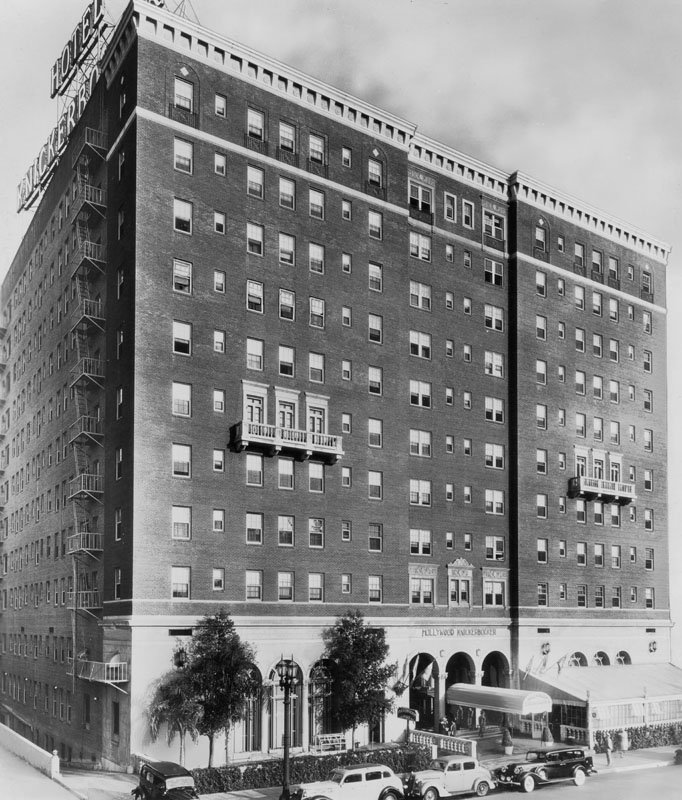 |
|
| (1938)* - View of the Hollywood Knickerbocker Apartment Hotel, located at 1714 Ivar Avenue. |
Historical Notes In 1923 E. M. Frasier built this 11-story hotel in Spanish Colonial style, which catered to Hollywood's film industry and was home to many stars throughout the years. This historic building began life as a luxury apartment building that was at the heart of Hollywood back in the 1920s, before becoming a hotel later in its history; its slogan was "Your home for a year or a day". The building has been linked with tragic deaths and because of this, it is considered haunted by some. Some unfortunate occurrences: D.W. Griffith died of a stroke on July 21, 1948 under the crystal chandelier of the lobby; a costume designer named Irene Gibbons jumped to her death from a hotel window; William Frawley, who lived at the hotel for decades, died of a heart attack on the sidewalk in front of the Knickerbocker. Other stars that frequented the hotel with better luck were: Rudolph Valentino, Elvis Presley, Marilyn Monroe and Joe DiMaggio, Frank Sinatra, Lana Turner, Mae West, and Cecil B. DeMille among many, many others. In 1970 a renovation project converted the hotel into housing for senior citizens.* |
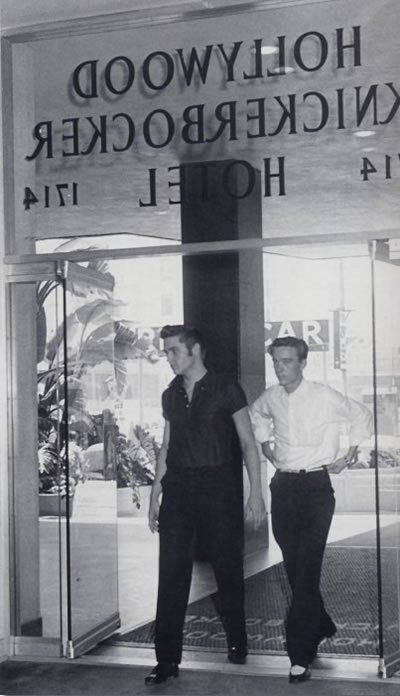 |
Historical Notes Before it became the allegedly haunted apartment complex it is today, this Hollywood hotel was a revolving door of A-list movie stars. Marilyn Monroe and Joe DiMaggio used to rendezvous at the hotel bar, and Elvis shacked up here while shooting his first film, “Love me Tender.” *#*
|
|
| (1956)*# - An Elvis sighting at the Hollywood Knickerbocker Hotel. |
* * * * * |
Street Flooding
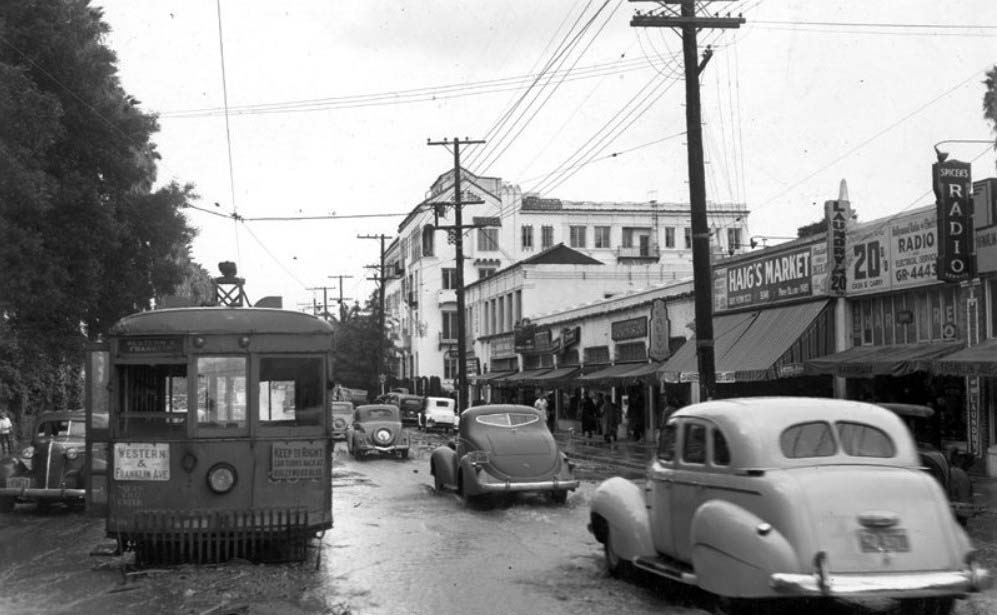 |
|
| (1938)**^** – View looking west on Franklin Avenue from Bronson Avenue. The Western and Franklin Avenue streetcar is stalled due to street flooding. On the right is Haig’s Market and a radio store. |
Historical Notes More than six inches of rain fell on March 2, 1938 throughout Southern California, causing widespread flooding throughout Los Angeles County. Rain continued intermittently for several days. Click HERE to see more Views of Flooding in Early L.A. |
Highland and Cahuenga
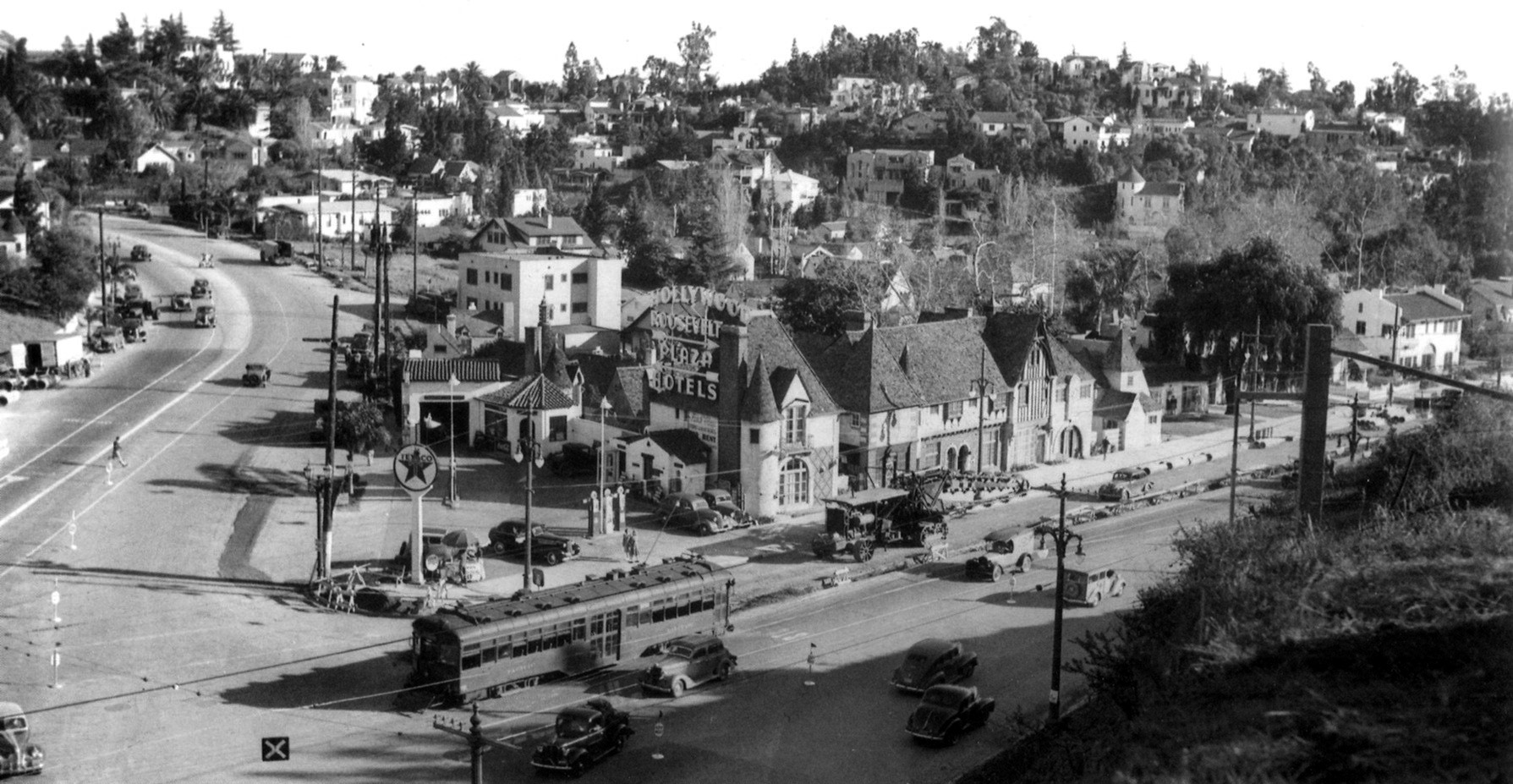 |
|
| (1937)*#^ - Panoramic view looking toward the southeast corner of Cahuenga (left) and Highland Ave (right). Streetcars and automobiles share the road at this busy intersection. A Texaco service station stands on the corner with the Hollywood Roosevelt Plaza Hotels behind it (Note: this hotel is not related to the famous Roosevelt Hotel on Hollywood Boulevard). |
Historical Notes This little nestle of buildings was known as the French Village. It was set on a triangular plot of land at the point where Highland Avenue and Cahuenga Boulevard converged as they entered the Cahuenga Pass. This puts it roughly across the street from the front entrance of the Hollywood Bowl. It opened in 1920, and throughout the 1920s, 30s, and 40s, the French Village was home to a revolving community of actors, writers, costume designers, dance instructors and singing coaches. #^^# In 1937, to relieve traffic congestion at this busy Cahuenga and Highland intersection, a tunnel was bored under Highland Avenue. Note: A large construction boring tractor can be seen at center of photo. |
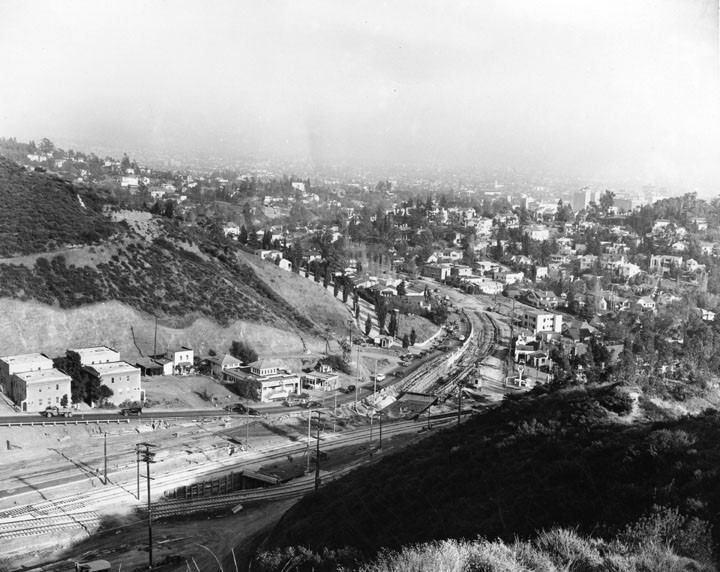 |
|
| (1937)* - View looking southeast toward Whitley Heights showing the construction of a tunnel (Cahuenga Tunnel) under Highland Avenue. Cahuenga Boulevard veers off to the left and would become the location of the Hollywood Freeway in the early 1950s. |
Highland-Cahuenga Tunnel
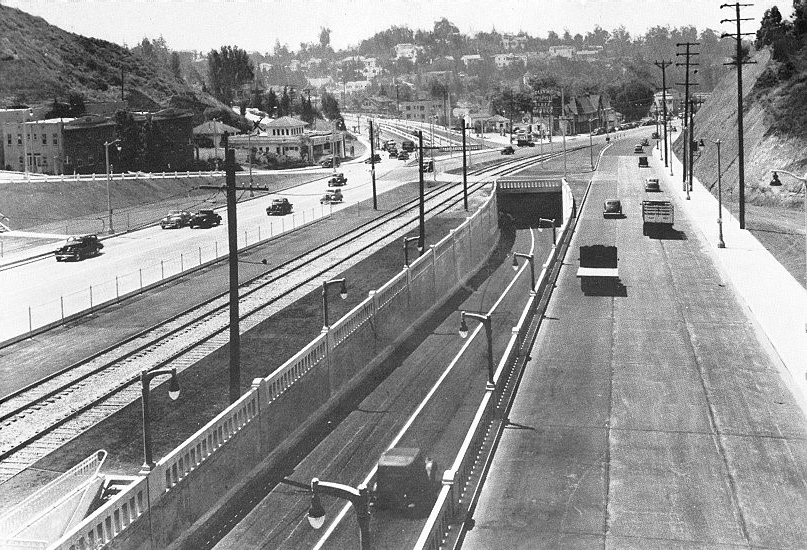 |
|
| (ca. 1938)++^ - View looking southeast showing the Cahuenga and Highland intersection shortly after a tunnel was bored to relieve congestion. US 101 traffic took the tunnel. Highland Ave traffic went to the right. |
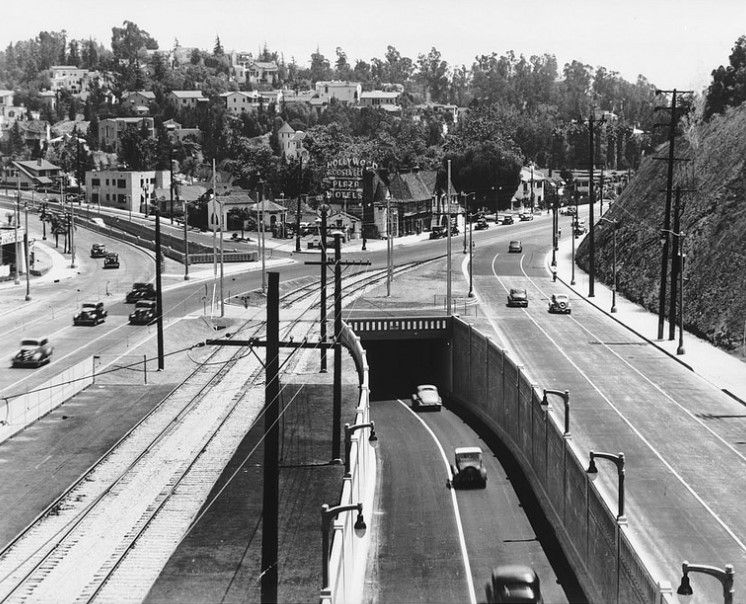 |
|
| (1938)^^ - Looking southeast at Whitley Heights across the intersection of Cahuenga Boulevard shortly after the construction of the new underpass to Highland Avenue. The entrance to the Hollywood Bowl is just beyond the shoulder of the hill on the right. |
Historical Notes The seriously complicated solution to the traffic pattern was largely eliminated in the coming years through the realignment and widening of Caheunga. |
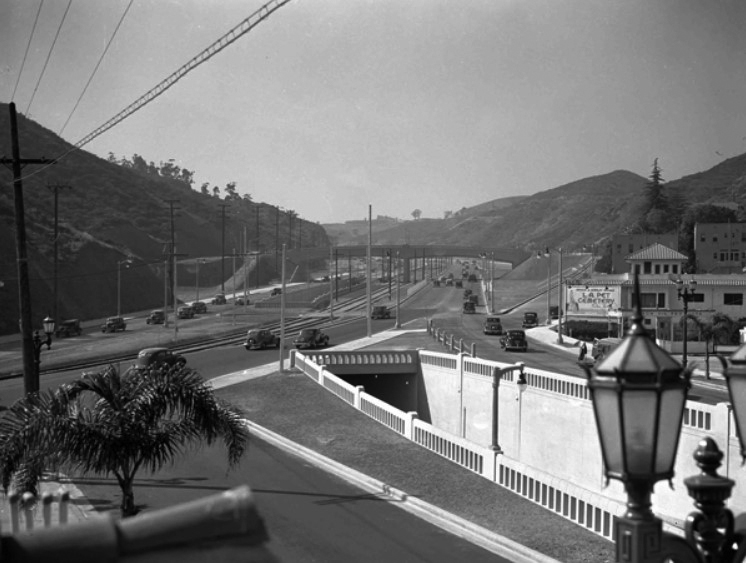 |
|
| (1940s)#^^ - View looking northwest showing Cahuenga Pass as it heads toward the San Fernando Valley. The tunnel at center-right (since closed) extended Highland Boulevard to the north, under the Freeway. The Hollywood Bowl is on left (out of view) on the other side of the freeway. |
Historical Notes This entire area would change pemanently with the construction of the Hollywood Freeway. The first segment of the Hollywood Freeway built was a two mile stretch through the Cahuenga Pass. That segment opened on June 15, 1940. It was then known as the "Cahuenga Pass Freeway." Pacific Electric Railway trolleys ran down the center of this freeway until 1952. |
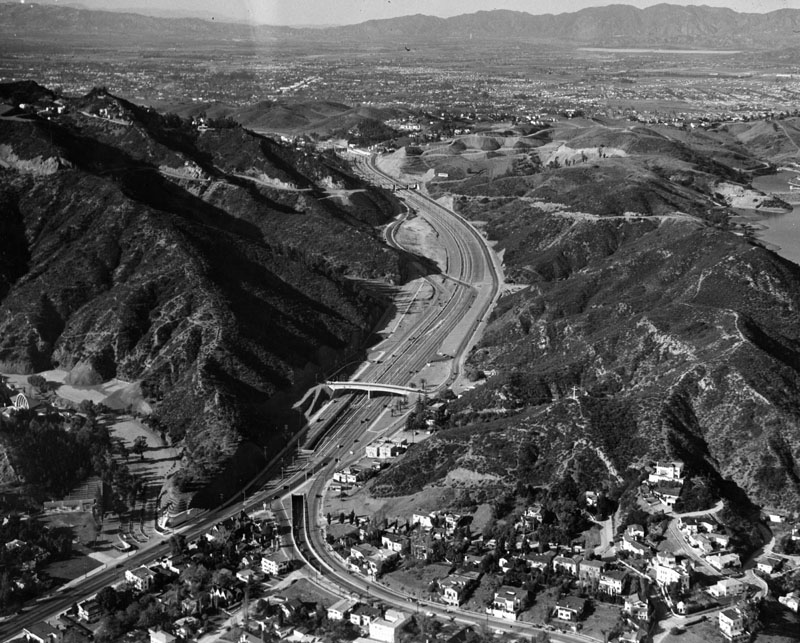 |
|
| (ca. 1951)* - Bird's eye view of the Hollywood Freeway through the Cahuenga Pass, looking towards the Valley. The Cahuenga Tunnel under Highland Avenue can be seen at lower center-left. The "Muse of Music" Statue at the entrance to the Hollywood Bowl is visible just to the left of the tunnel as is part of the Hollywood Bowl shell (center-left). |
Before and After
 |
|
.jpg) |
|
| (1938)^^ vs. (1953)* - View is looking south, with bottom photo showing how the final link of Hollywood Freeway will connect up with the south end of Cahuenga Pass. Tunnel (3) will be eliminated, and a new bridge constructed (broken lines). (1) Shows detour for southbound traffic from Cahuenga Pass to Highland Avenue (2) and on around bridge construction work (left background). |
Historical Notes In 1953, the Cahuenga Tunnel would be demolished and built over for the construction of the Hollywood Freeway Extension (Cahuenga Pass to Downtown LA). Click HERE to see more in Early Views of Cahuenga Pass. |
Hollywood Bowl
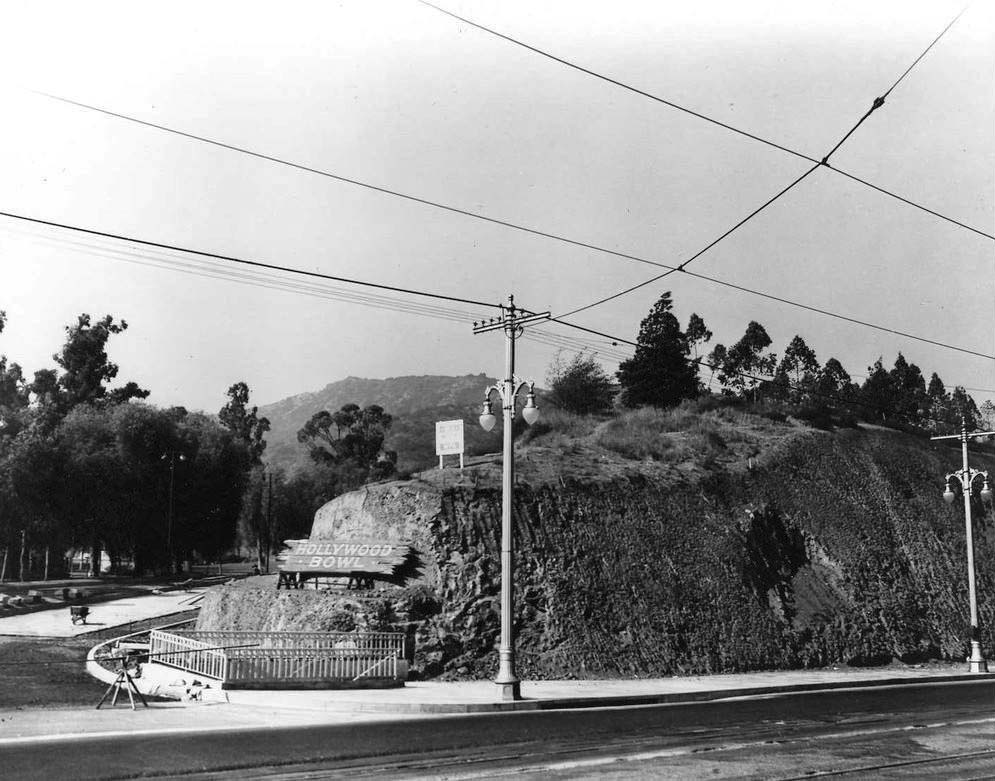 |
|
| (ca. 1930s)#**# - View showing newly paved driveway at the entrance to the Hollywood Bowl, with large wooden sign on the dirt embankment. |
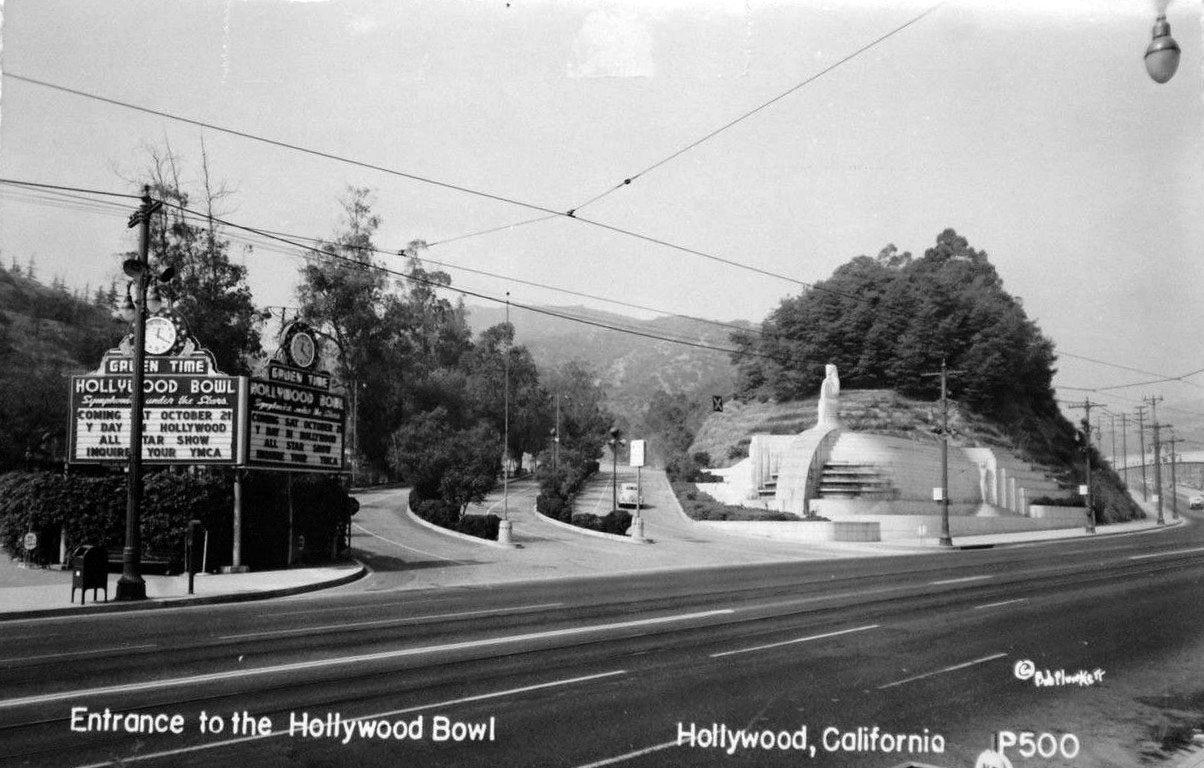 |
|
| (ca. 1940)^^^ - Postcard view of the entrance to the Hollywood Bowl showing the "Muse of Music" statue and the Gruen Watch signboard. |
Historical Notes In 1939, the Hollywood Bowl’s “Muse of Music” entrance statue was erected by the WPA at a cost of $100,000. It was designed by sculptor George Stanley, most noted for his design of the “Oscar” statuette.* |
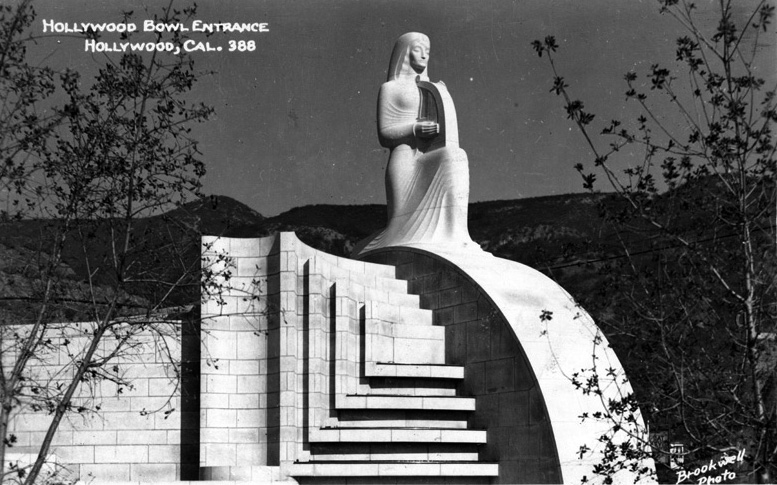 |
|
| (ca. 1940)^^^ - Postcard view of the Hollywood Bowl Entrance at dusk. |
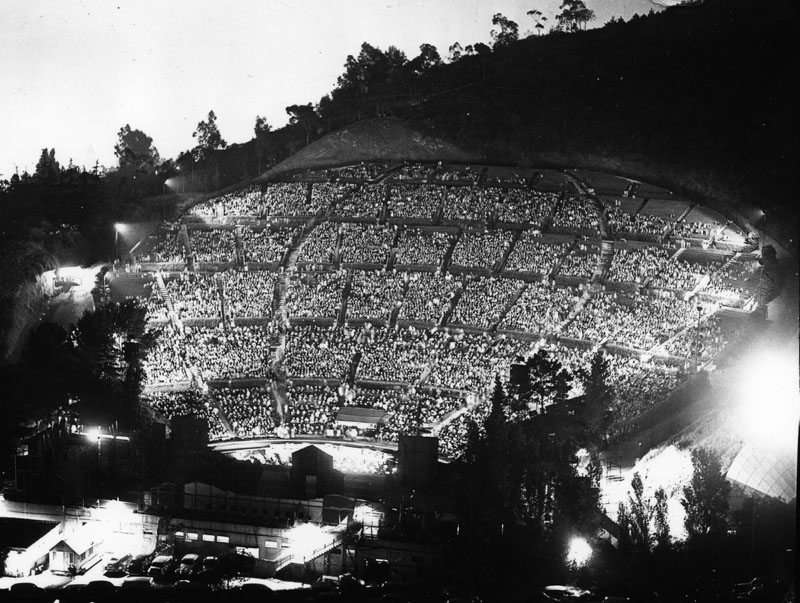 |
|
| (ca. 1940)* - Evening view of the Hollywood Bowl hillside seating area, without the shell. |
Historical Notes Over the years, the Hollywood Bowl shell would go through a series of design modifications all in an effort to improve the acoustics. However, in the early years (1926-1929) the shell configuration was dramatically changed four times.*^ |
Click HERE to see more in Early Views of the Hollywood Bowl |
 |
|
| (ca. 1939)*# - View looking northwest across an empty parking lot toward the intersection of Hollywood and Vine from Selma Ave just west of Argyle Ave. Signboards can be seen everywhere including (l to r): Western Air Lines, Brown Derby, Plaza Hotel, The Broadway-Hollywood, Miller High Life Beer, and the Taft Building. |
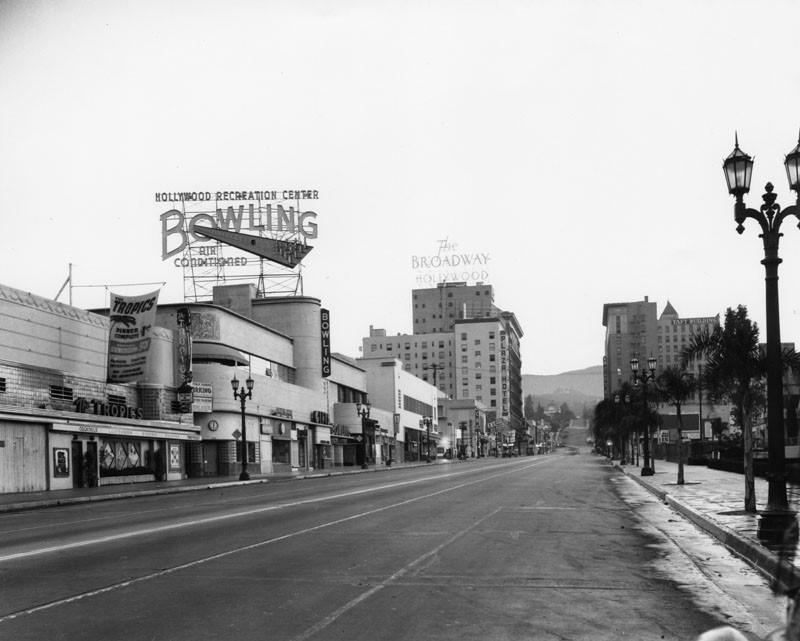 |
|
| (ca. 1939)* - View of Vine Street looking north from Sunset Boulevard. The Tropics Restaurant and Hollywood Recreation Center Bowling are on the left, with the Broadway Hollywood in the distance. There are no cars on the street. The bowling sign features a ball rolling toward the pins. |
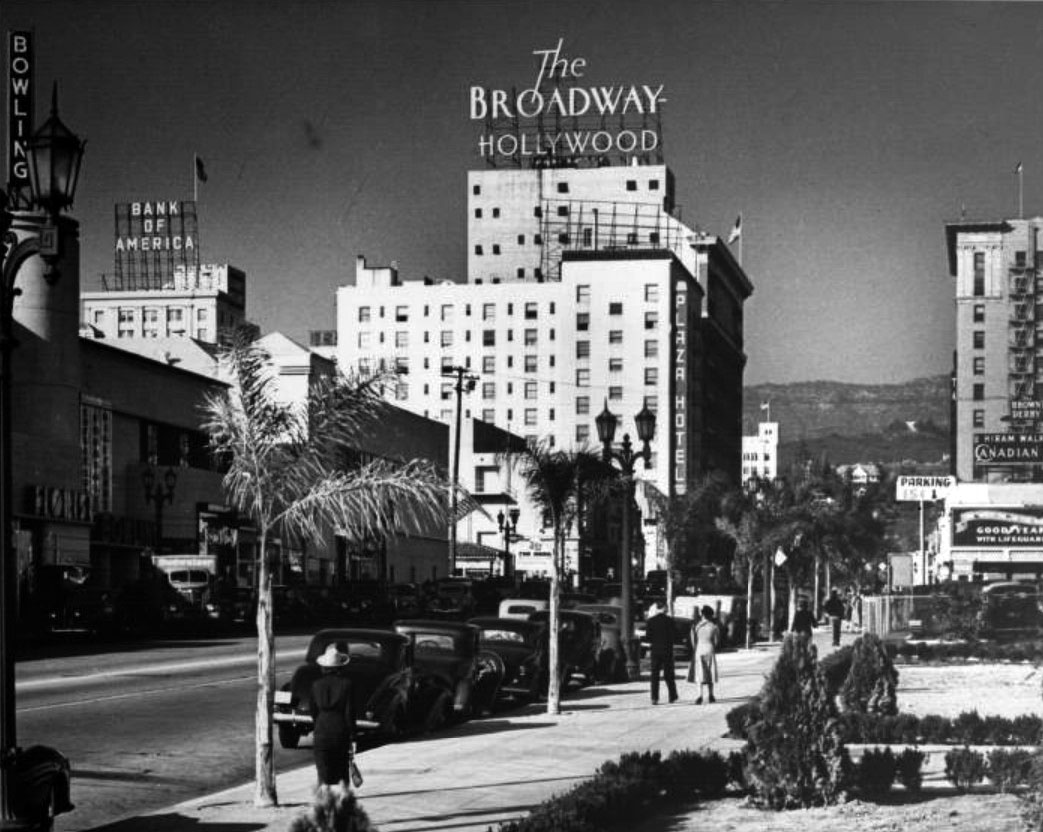 |
|
| (1939)^^ - View looking north on Vine Street toward Hollywood Boulevard and the Hollywood Hills showing several pedestrians walking along the sidewalk. Some of the legible signs include (left to right): Bowling, Bank of America, Plaza Hotel, The Broadway-Hollywood, Canadian Club, and The Brown Derby. Photo by 'Dick' Whittington. |
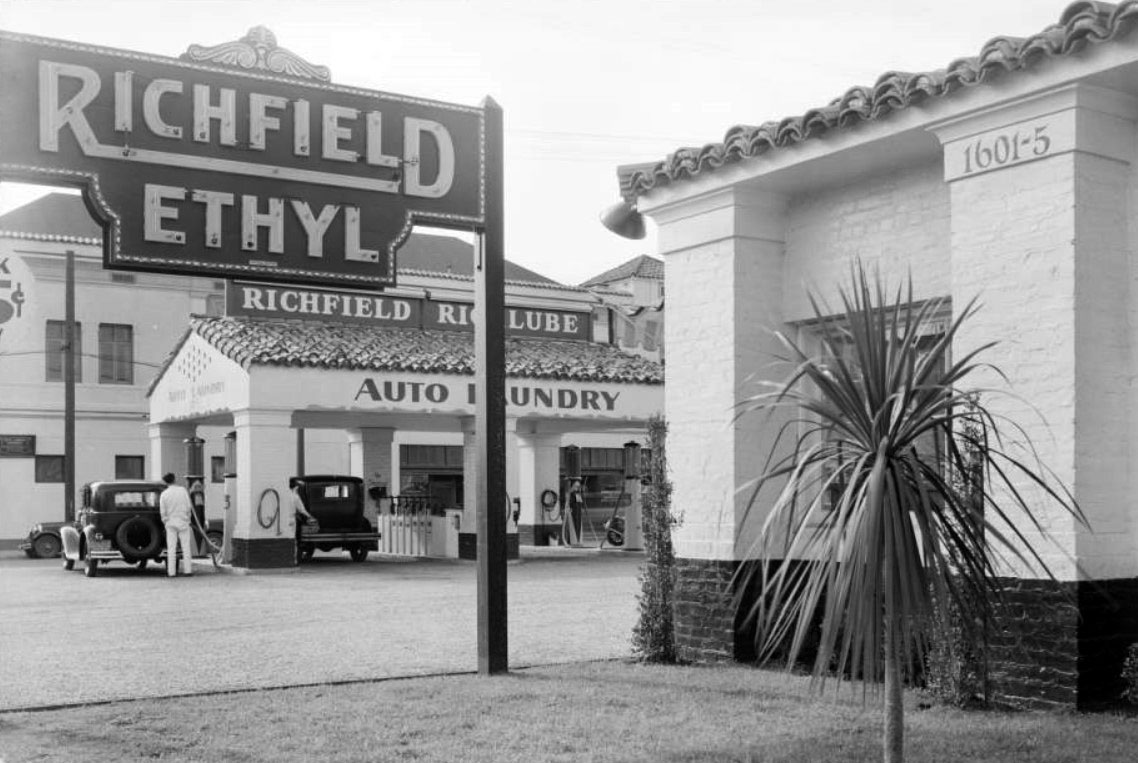 |
|
| (1930)^^ – View looking southwest showing a Richfield Service Station located on the NW corner of Vine Street and Selma Avenue (1601 Vine Street). Sign on side of canopy over gas pumps reads: “Auto Laundry”. |
Historical Notes The Richfield Oil Corporation was founded in 1905 and opened its first automotive service station in Los Angeles in 1917. After quick expansion, Richfield Oil Corp fell to the Great Depression and went into receivership in 1931. Consolidated Oil Corp, in 1935, bought Richfield's eastern United States operations. This maneuver removed Standard Oil of California's interest in Richfield Oil. The east coast gas stations would later be rebranded as Sinclair stations. Richfield Oil Corp emerged from receivership in 1936 after Rio Grande controlled by Consolidated Oil Corp and Cities Service Company agreed to a merger between Richfield Oil and Rio Grande. The company merged with Atlantic Refining to form Atlantic Richfield Corp, also known as ARCO in 1966. ARCO in turn was purchased by BP p.l.c. in 2000. ^ |
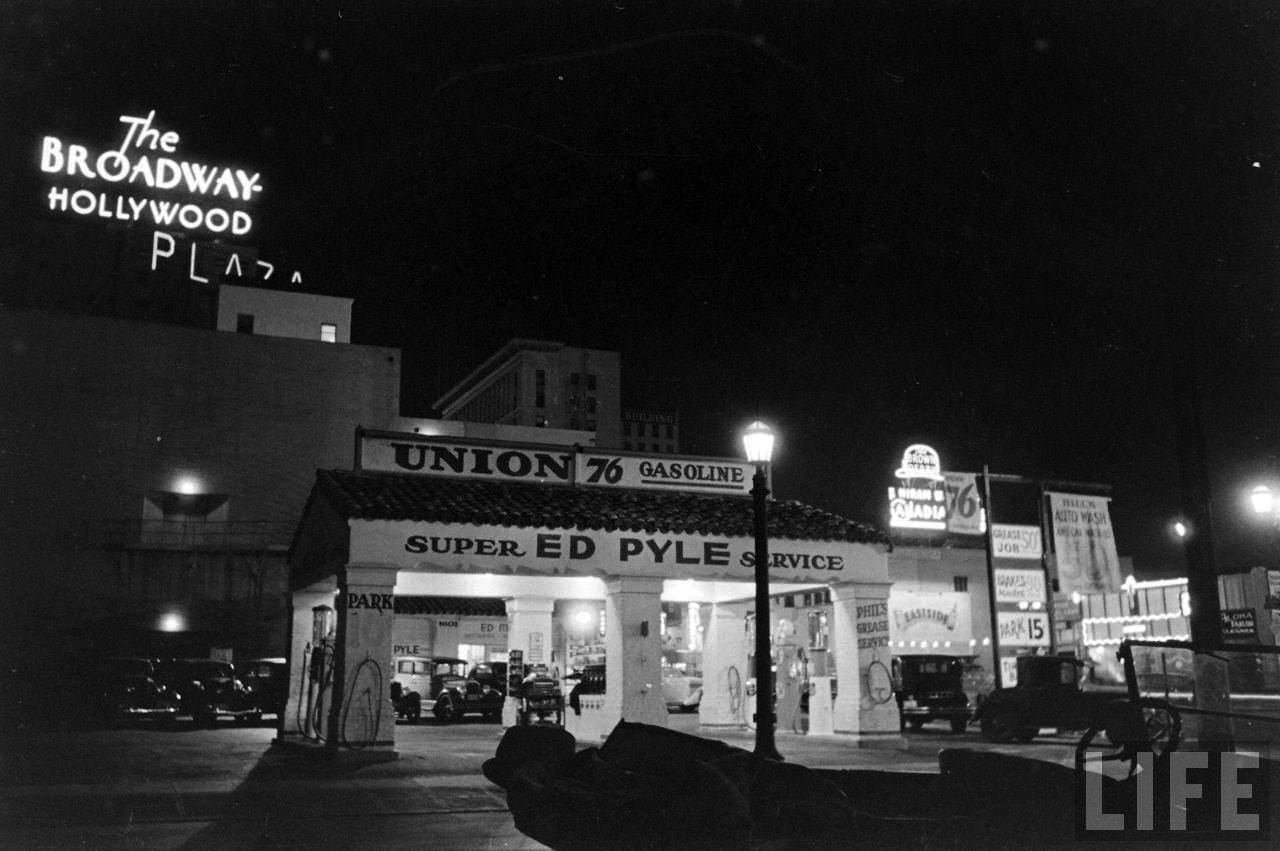 |
|
| (ca. 1932)^x* – Life Magazine photo showing a Union 76 Service Station located on the northwest corner of Selma Ave and Vine Street, which was previously a Richfield Station (see previous photo). Sign over pump reads “Super ED PYLE Service”. Neon lights shine in the background advertising The Broadway-Hollywood, Hollywood Plaza Hotel and the Brown Derby Restaurant. View is looking northeast toward Hollywood Boulevard. |
Historical Notes Union Oil (for many years based in El Segundo, California) introduced "76" gasoline in 1932. The name referred to the 1776 United States Declaration of Independence, and was also the octane rating of the gasoline in 1932. ^ Clcik HERE to see more Early LA Gas Stations. |
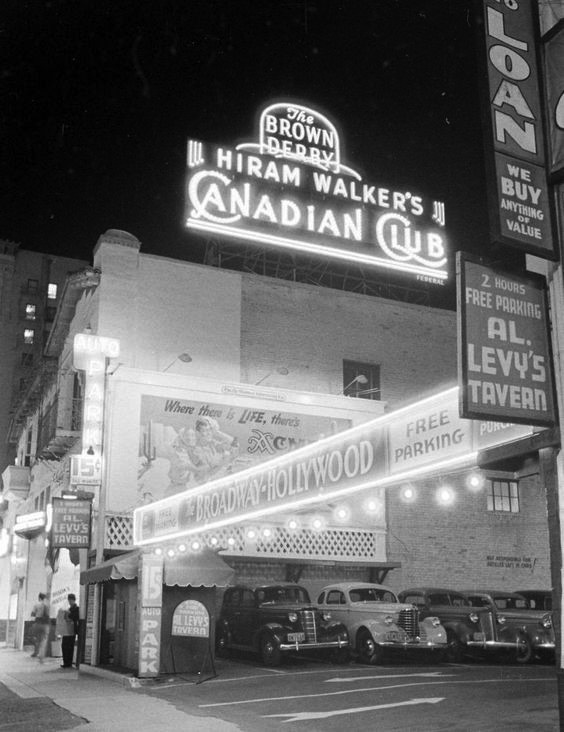 |
|
| (1938)^x^ - View showing a parking lot a block south of the Hollywood and Vine corner where people could park for The Brown Derby, Broadway-Hollywood Department Store, and Al Levy's Tavern (a popular tavern in the 30s and 40s, which would later become Mike Lymon’s Hollywood Grill.) |
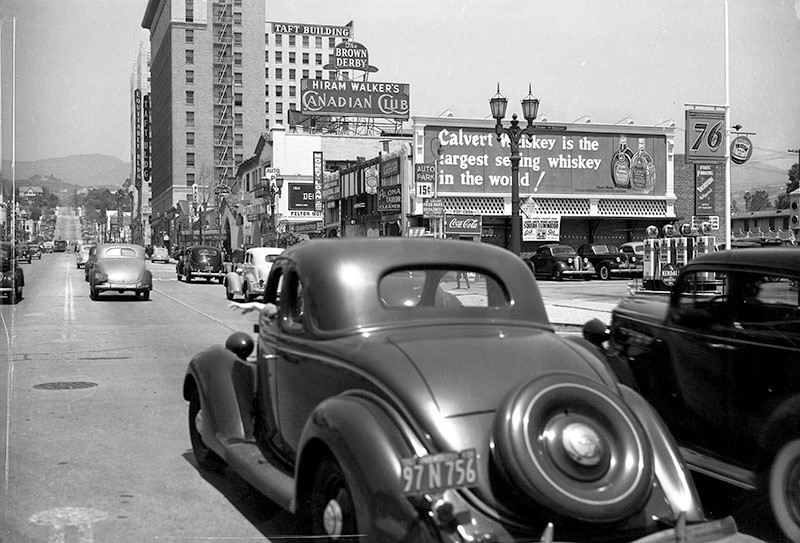 |
|
| (1939)* - View looking north up Vine Street at Selma Avenue, towards the Hollywood Hills. The Taft Building (S/E corner of Hollyood and Vine) stands in the background. The Brown Derby Restaurant at 1628 N. Vine Street is seen at center-left. |
Brown Derby (Hollywood)
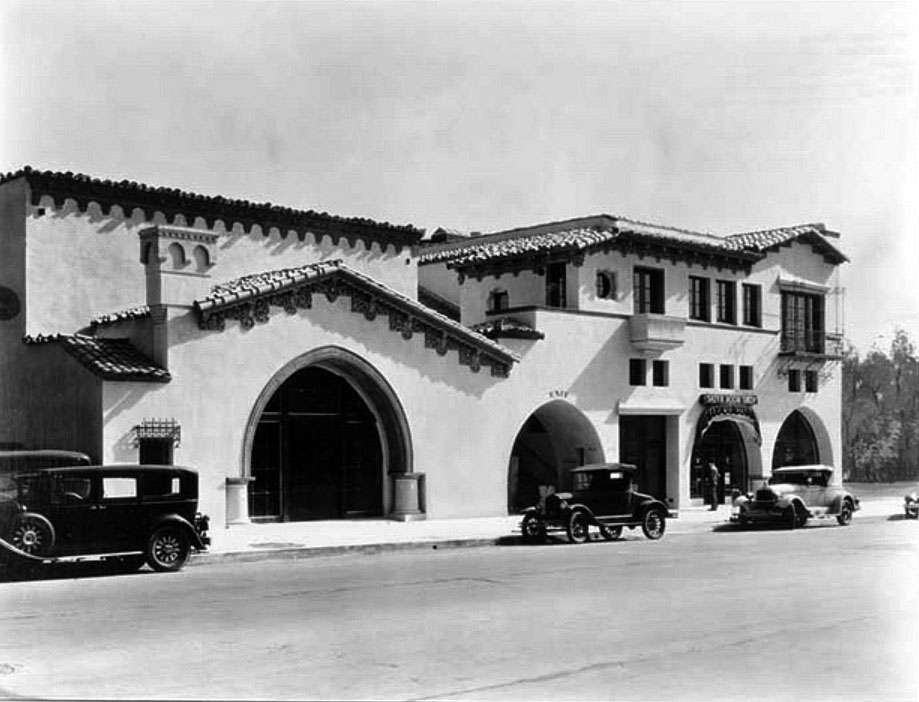 |
|
| (1928)^***^ – View showing the future home of the Hollywood Brown Derby Restaurant located at 1628 N. Vine Street. It is part of a complex of Spanish Colonial Revival buildings designed by architect Carl Jules Weyl. |
Historical Notes The Hollywood Brown Derby Vine Street building was originally designed and constructed as a studio office for Cecile B. Demille. It would open as the Brown Derby Restaurant in 1929. |
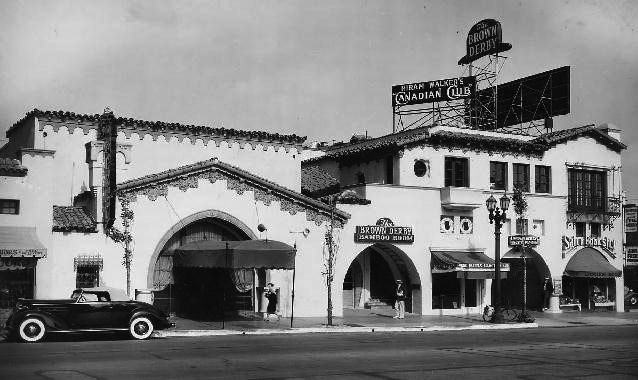 |
|
| (1930s)^.^ - The Hollywood Brown Derby located at 1628 N. Vine Street. A long awning extends over the sidewalk that leads to its entrance. At right, a hat-shaped sign for the Derby is visible extending from the second story of a Spanish Revival-style building, below which a second sign reads "Hiram Walker's 'Canadian Club'". At far right is the Satyr Book Shop, one of the earliest bookstores in Hollywood. |
Historical Notes The Brown Derby chain was started by Robert H. Cobb and Herbert Somborn (a former husband of film star Gloria Swanson). Bob Cobb is known as the inventor of the California Cobb Salad. He was also part owner of the Hollywood Stars baseball team. |
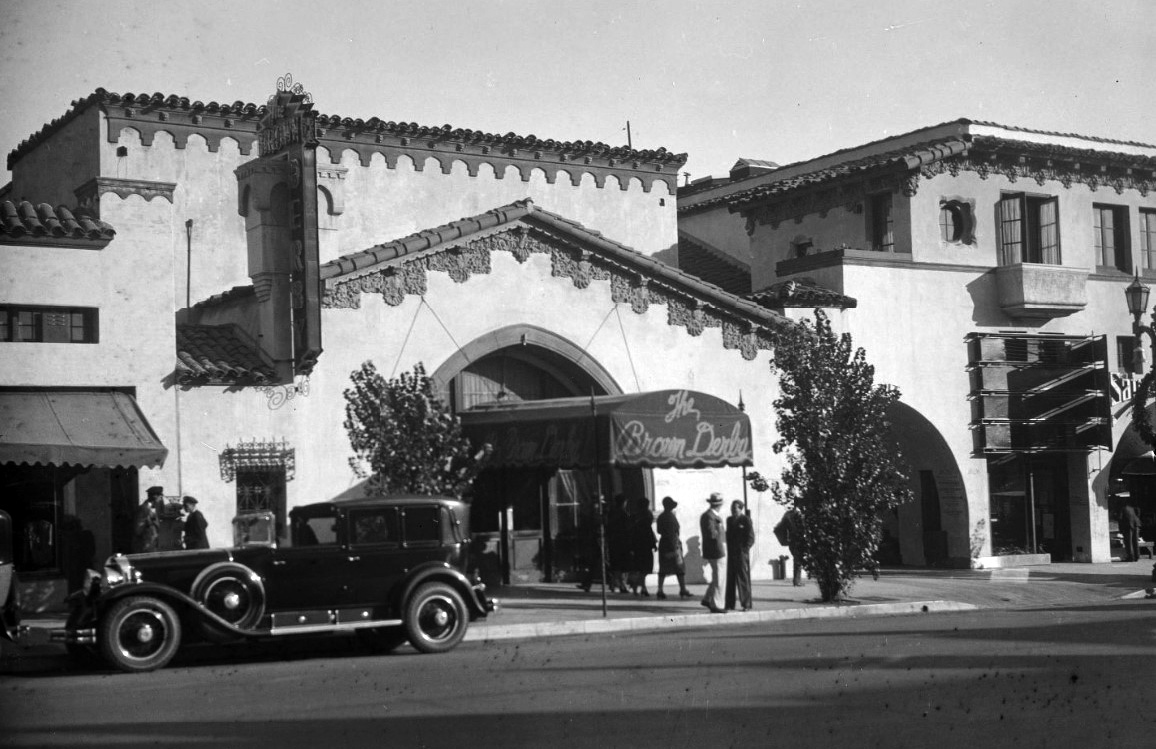 |
|
| (1931)** - Close-up view of the Brown Derby Restaurant entrance, with Vine Street, cars, and pedestrians in foreground. The edge of Satyr Book Shop can be seen at far right. |
Historical Notes Despite its less distinctive Spanish Mission style facade, the Hollywood Brown Derby, which opened on Valentine's Day 1929 at 1628 North Vine Street, was the branch that played the greater part in Hollywood history. Due to its proximity to movie studios, it became the place to do deals and be seen. Clark Gable is said to have proposed to Carole Lombard there. Rival gossip columnists Louella Parsons and Hedda Hopper are recorded as regular patrons.^ |
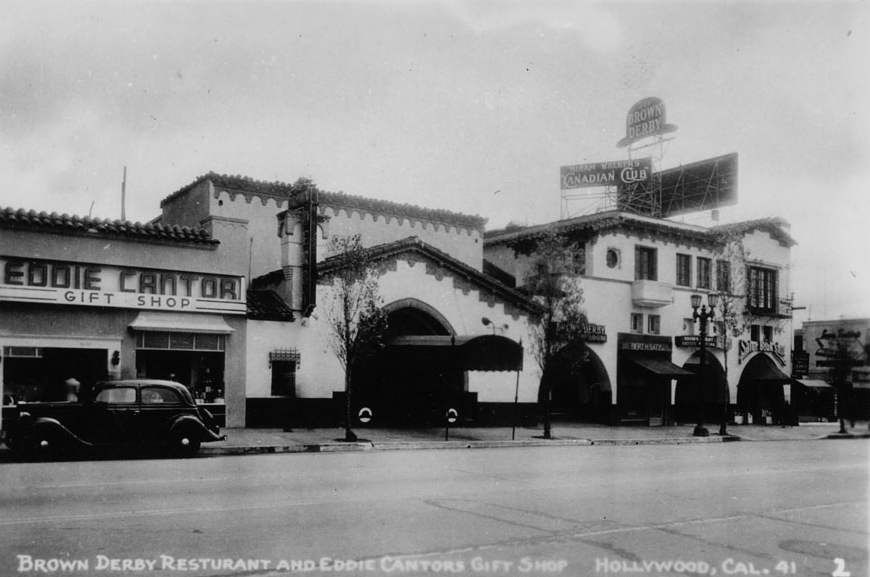 |
|
| (ca. 1938)^ - Postcard view of the Brown Derby Restaurant on Vine Street. At left, an automobile is parked in front of the Eddie Cantor gift shop. |
Historical Notes The building’s architect, Carl Jules Weyl’s, also designed the Hollywood Playhouse further up Vine Street (now home to Avalon nightclub), several other Brown Derbys, the Gaylord Apartments on Wilshire, and many other distinctive homes of the era. He later became a noted art director and went on to win an Academy Award for art direction on the classic 1938 Errol Flynn-Olivia de Havilland film, “The Adventures of Robin Hood.”* |
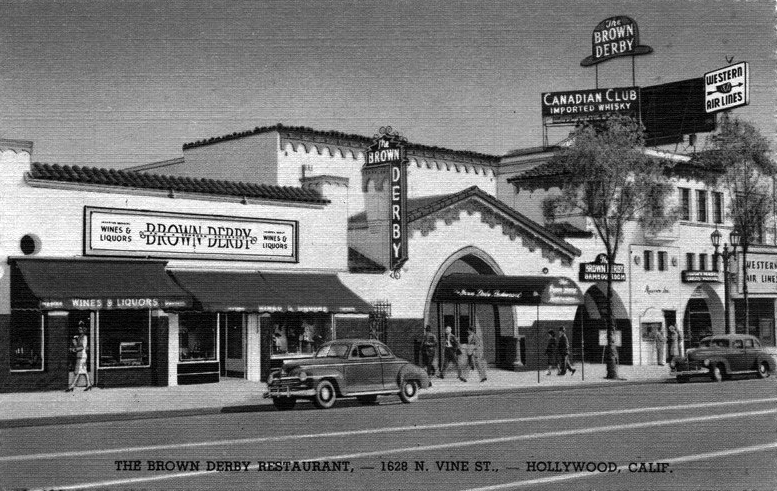 |
|
| (ca. 1939)^^^ - Postcard view of "The Brown Derby Restaurant" - 1628 N. Vine Street - Hollywood, Calif. |
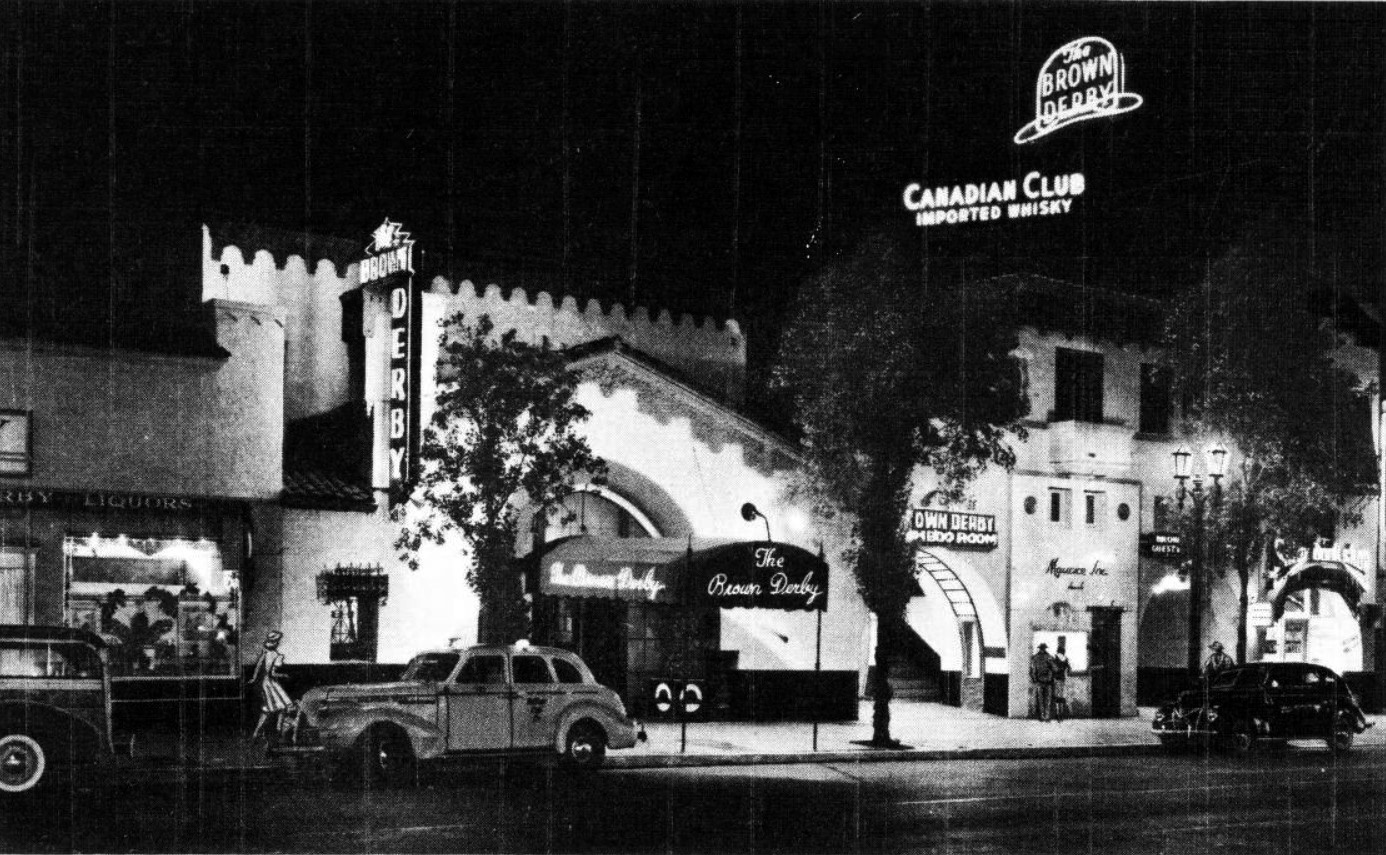 |
|
| (ca. 1940)^^ - Nighttime postcard view of the Brown Derby Restaurant in Hollywood. Picture file card reads: "The rendezvous of the stars, the Brown Derby, Hollywood, California. The famed Brown Derby on Vine Street, Hollywood, with its adjacent distinctive Bamboo Room, is the acknowledged center of the smart social life of the movie colony." |
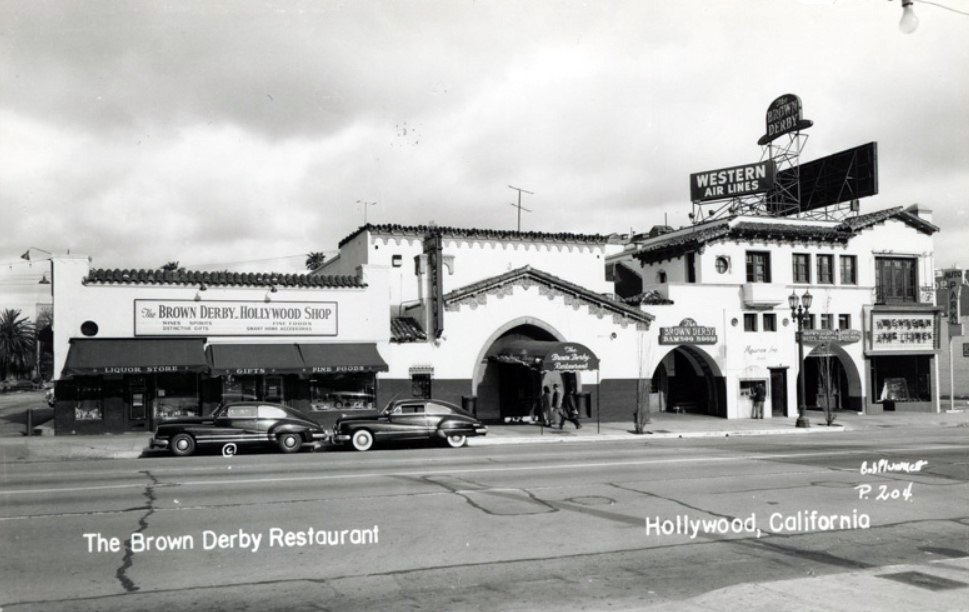 |
|
| (1940s)* - Postcard view showing the Brown Derby Restaurant. Sign above cars on the left reads: The Brown Derby..Hollywood Shop. Photo by Bob Plunkett |
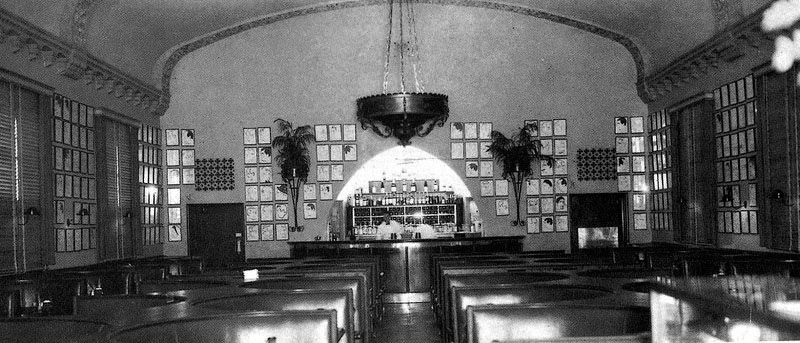 |
|
| (ca. 1930s)^.^ - Interior view of the Vine Street Brown Derby, which opened in 1928. Note the pictures on the wall. |
Historical Notes The interior walls were covered with famous caricatures drawn by an artist whose name was so long and complicated, he shortened it to Vitch. He originally approached the owners of the Brown Derby asking if he could draw the caricatures of diners in exchange for a bowl of hot soup and a cup of coffee. They became very popular and soon it became a “thing” to sit at the Brown Derby below your portrait. |
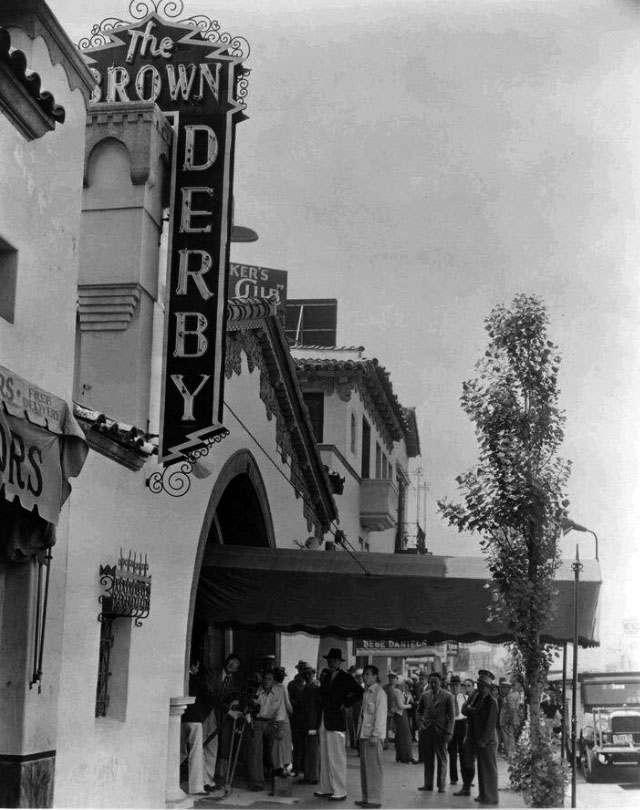 |
|
| (1930s)^.^ – View showing a group of men standing in front of the Brown Derby on Vine Street. |
 |
|
| (ca. 1940s)* - View showing pedestrians walking past the entrance to the Brown Derby. On top of the next building is a prominent sign reading "Western Air Lines". |
Historical Notes The Hollywood Brown Derby became part America's Culture industry. Stars received fan mail addressed simply to: The Brown Derby, Hollywood and Vine. |
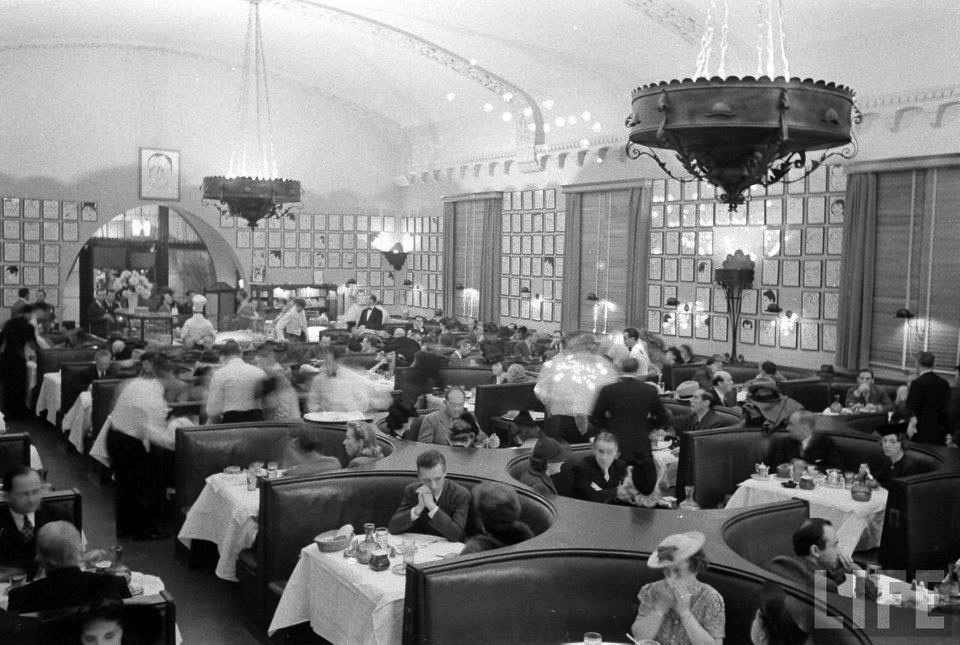 |
|
| (ca. 1940s)*^ – Life Magazine photo showing the interior of the Vine Street Brown Derby. The waiters are bustling around the restaurant, tending to well-dressed patrons huddled in booths, while Eddie Vitch’s caricatures fill every square inch of the walls. Note the ornate chandeliers. |
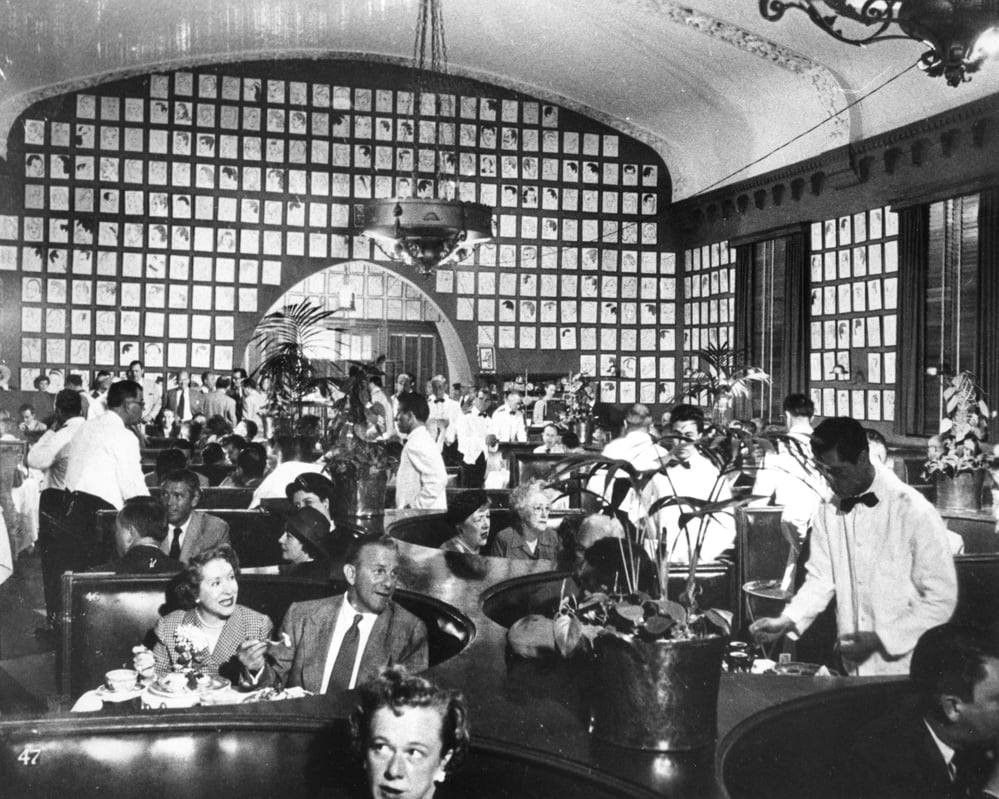 |
|
| (1951)^.^ - George and Gracie Burns having lunch with scores of other patrons at the Brown Derby. Note how the interior walls are covered with famous caricatures. It became a “thing” for the movie stars to sit at a table below their portrait. |
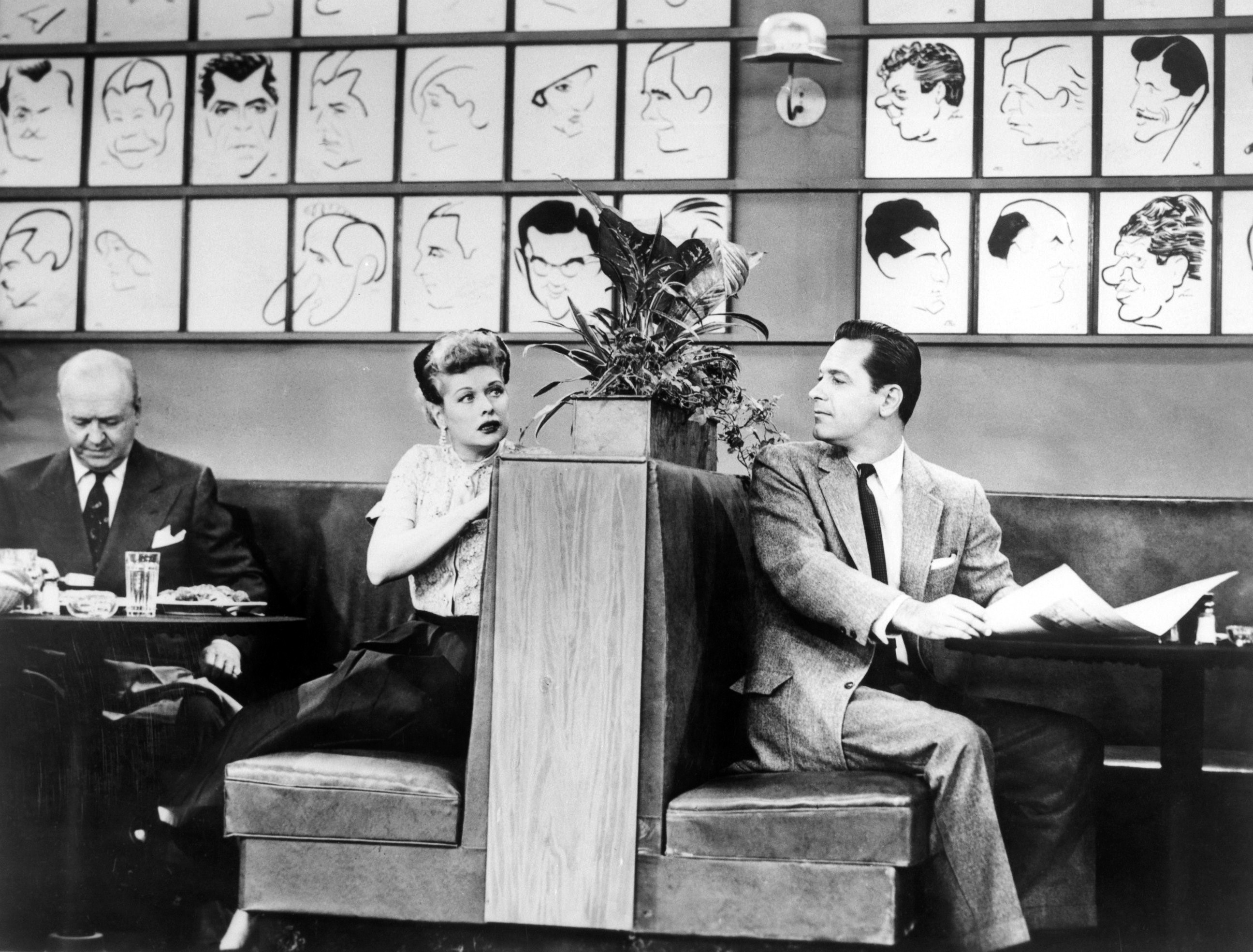 |
|
| (ca. 1950s)* - The Brown Derby on Vine was featured in that legendary episode of "I Love Lucy" where Lucy Ricardo accidentally covers William Holden in food after gawking at the actor from an adjacent booth. |
Historical Notes The Brown Derby in Hollywood is where stars usually frequented, and was the place to see and be seen. Humphrey Bogart, Groucho Marx, Cecille B. Demille and other Hollywood legends could be seen eating here. |
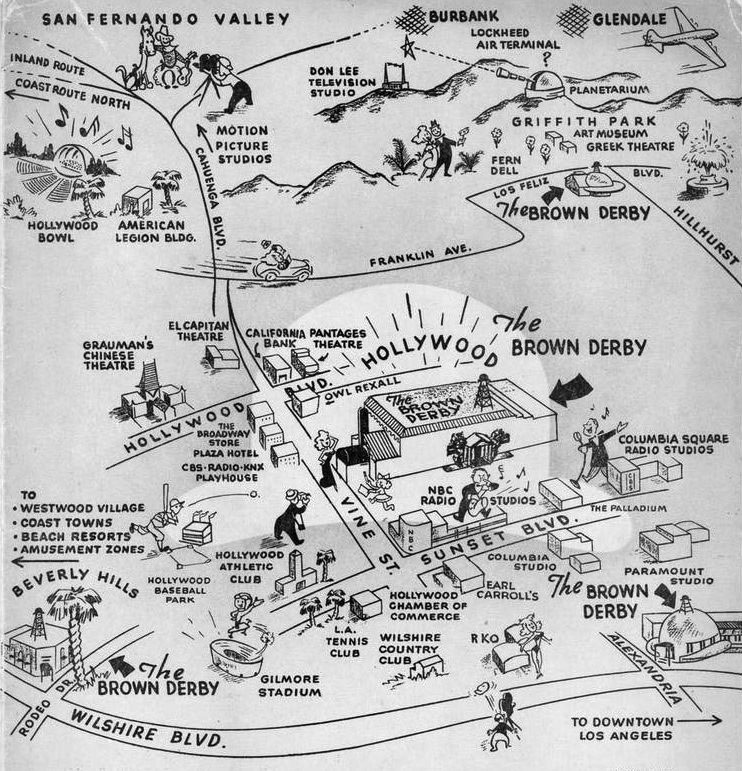 |
|
| (1947)*^ - Entertaining caricature map of Post-World War II Los Angeles, which graced the cover of the dinner menu for the famous Brown Derby Restaurant. Included on the map are the four locations of the Brown Derby. Image courtesy of Barry Lawrence Ruderman Antique Maps (RareMaps.com) |
Historical Notes The Brown Derby chain included restaurants in Hollywood, Beverly Hills, L.A. (Wilshire) and the Los Feliz area. The Los Feliz Brown Derby at 4500 Los Feliz Blvd is the last remaining branch of the chain still extant and in operation. Technically there were seven different Brown Derby buildings: two in Hollywood including this one and later a short-lived one located on the NW corner of Hollywood and Vine; three on Wilshire, all within a few blocks of each other on the north side of Wilshire Boulevard (1st Location; 2nd Location; 3rd Location); one in Beverly Hills; and one in the Los Feliz area. |
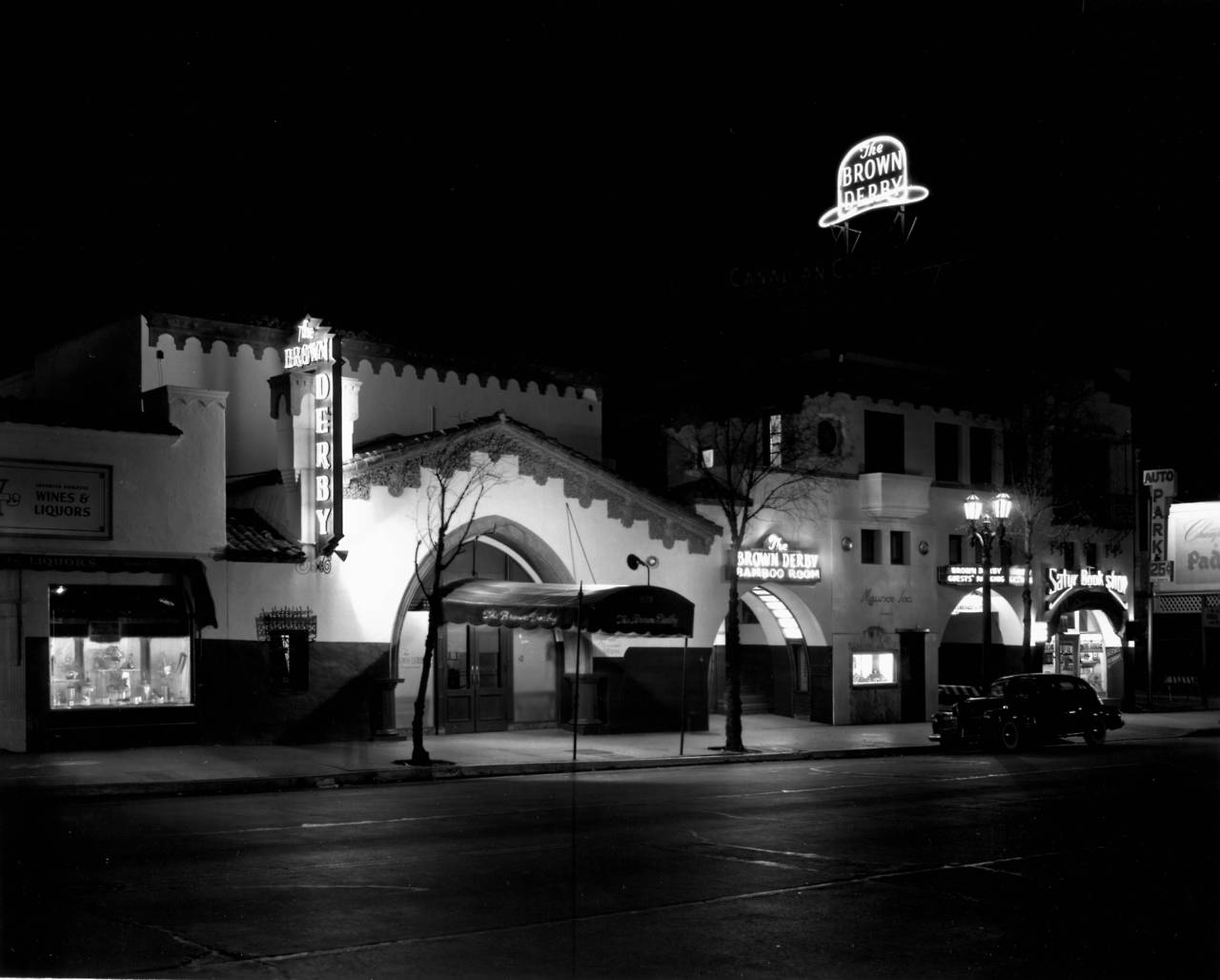 |
|
| (1944)^ - The Brown Derby at night, located at 1628 N. Vine Street. Not quite a still life: the long exposure reveals the blurred spectral figure of a man to the left of the entrance awning. The Satyr Book Shop is seen on the far right. |
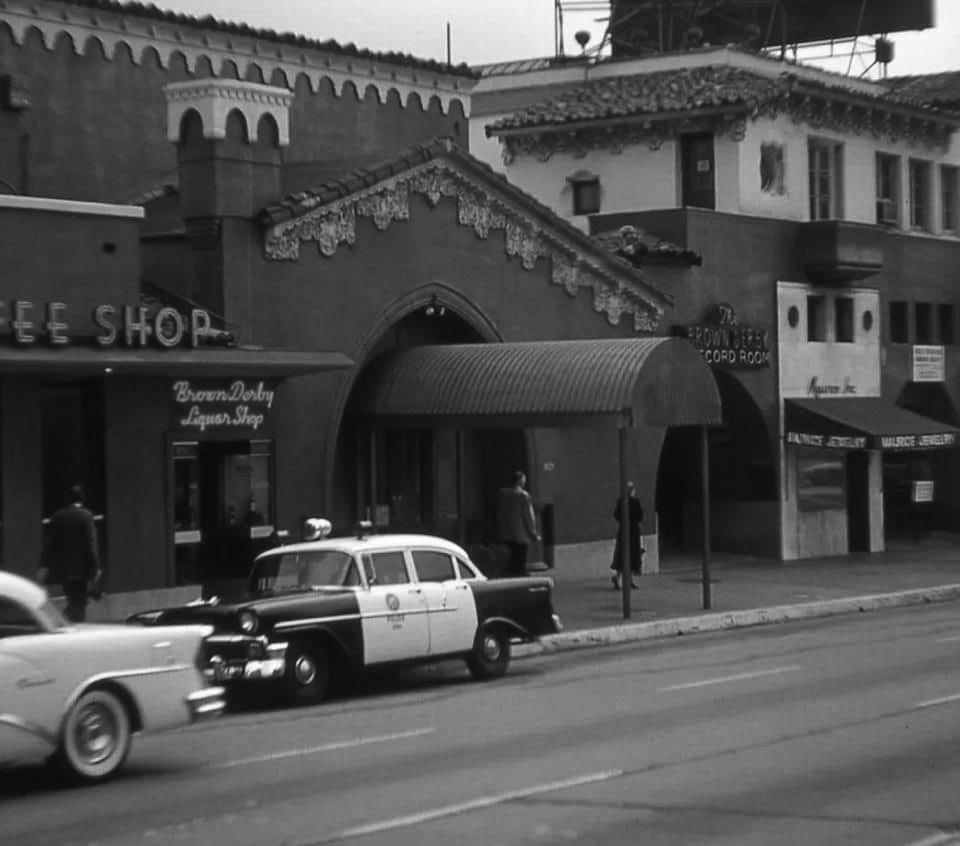 |
|
| (ca. 1955)^.^ - Police car parked in front of the The Brown Derby on Vine. |
Historical Notes The Brown Derby building was largely destroyed by fire in 1987. Only a small fragment of the restaurant's facade remains, and was being incorporated into a new W Hotels development. In the nineties, the building was home to a family of punk squatters.*^ After the fire, the Brown Derby re-emerged on the NW corner of Hollywood and Vine, but would be there for only a short period of time. |
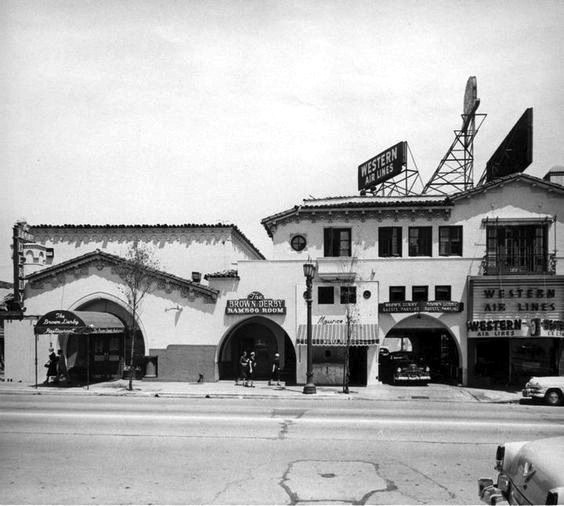 |
|
| (ca. 1949)^x^ - View showing the Brown Derby as seen from across the street with the Western Air Lines office on the right. |
Herman Building (Remaining part of the complex that included the Brown Derby)
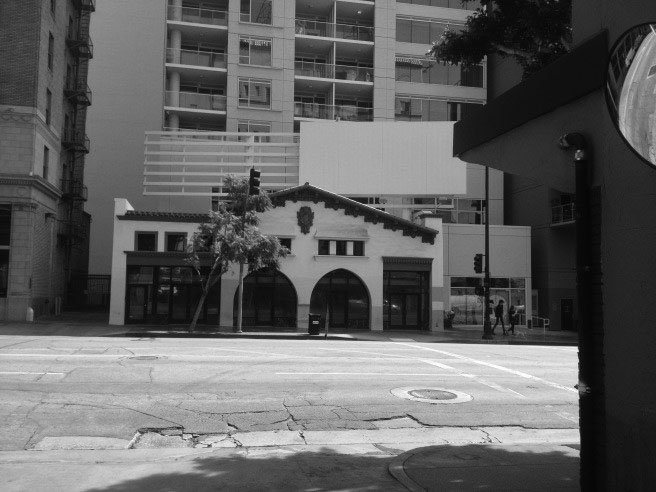 |
|
| (2016)*.* - View showing the Herman Building which was part of a complex of Spanish Colonial Revival buildings designed by architect Carl Jules Weyl that included the now-destroyed Hollywood Brown Derby Restaurant next door. The Taft Building, SE corner of Hollywood and Vine, is on the left. |
Historical Notes Over the years, the Herman Building was home to many businesses, most notably a restaurant in the 1940s-1950s called the Ham & Egger. Johnny Grant, who went on to become the Honorary Mayor of Hollywood, broadcast a live radio show from the restaurant where he interviewed such famous celebrities of the day as Bob Hope, Jimmy Durante and Alan Young. Click HERE to see the Herman Building in 1950. The building has been owned by the Blue Family since the 1970’s. Their business, Bernard Luggage Co., was originally located at the corner of Hollywood & Vine where 33 Taps is today. They moved into the Herman Building in the 1950’s and bought it 20 years later. When the city sought to develop the area for the W Hotel & Residences project, son Bob Blue refused to sell the property and the city attempted to take it by eminent domain. After a contentious battle, Blue eventually won his case, and the W Hotel was built around the property which was reconstructed and restored to its original look. ^ Click HERE for a contemporary Google Street View. |
Satyr Book Shop
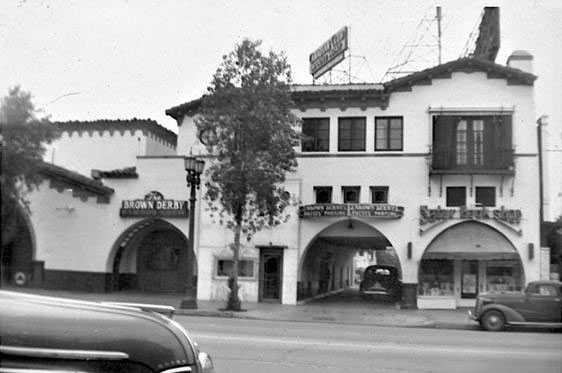 |
|
| (ca. 1937)**## – View showing the Satyr Book Shop (right) located in the same building as the Hollywood Brown Derby Restaruant on Vine Street. The bookstore was originally co-owned by Stanley Rose. |
Historical Notes Stanley Rose was born in Matador, Texas. He served in the United States Army during World War I, and was said to have received an injury to his throat that necessitated treatment at a veterans’ hospital in Palo Alto, California, near Stanford University—from which, according to historian Kevin Starr, Rose “absorbed the atmosphere of books as if by osmosis.” By the mid-1920s he had moved to Los Angeles and entered the book trade, most successfully as an itinerant supplier of books to writers and executives at the Hollywood studios; according to at least one account, he also operated as a bootlegger, smuggling his liquor deliveries into the studios in the false bottoms of the suitcases he used to make his book deliveries. (Many accounts also claim that he sold erotic or pornographic literature as well.) By the late 1920s, he had become a partner in the Satyr Book Shop, which had opened in 1926 on Hudson Street and subsequently moved to a prime location on Vine Street near the Hollywood Brown Derby restaurant. The Satyr partnership dissolved after Rose took the rap for his partners by pleading guilty to a violation of the Copyright Act related to their publication of a pirated edition of a popular risqué humor book of the day, The Specialist by Charles (Chic) Sale. After serving a short jail sentence, Rose opened his own bookshop, on the opposite side of Vine Street from the Satyr. Rose operated his bookshop on Vine Street and at one other location (on Selma Avenue) for about four years prior to moving, in January 1935, to what would become its final and most memorable site, at 6661½ Hollywood Boulevard, a few doors east of the Musso and Franks Grill restaurant. Even before this time the shop had begun to attract many screenwriters and novelists, who came seeking not just books but also the congenial company of their fellows and of Rose himself. *^ |
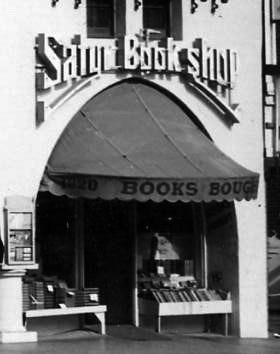 |
(1930s)*^* – View showing the entrance to the Satyr Book Shop located at 1622 Vine Street in Hollywood. Books are stacked on display in front of the store. |
|
 |
|
| (1931)^.^ – View showing two well-dressed men standing by the front entrance to Satyr Book Shop with books in hand. The man on the left is Universal Pictures star John Boles. This is most likely a staged publicity shot (credited to photographer Ray Long). |
Historical Notes John Boles was a singer and actor best known for playing Victor Moritz in the 1931 film Frankenstein.*^ |
* * * * * |
 |
|
| (ca. 1939)* - Night view of Vine Street looking north from Sunset Boulevard. The Brown Derby neon sign can be seen at right-center. The Tropics Restaurant and Hollywood Recreation Center Bowling are on the left, with the Broadway-Hollywood in the distance. There are barely any cars on the street. The neon bowling sign features a ball rolling toward the pins. |
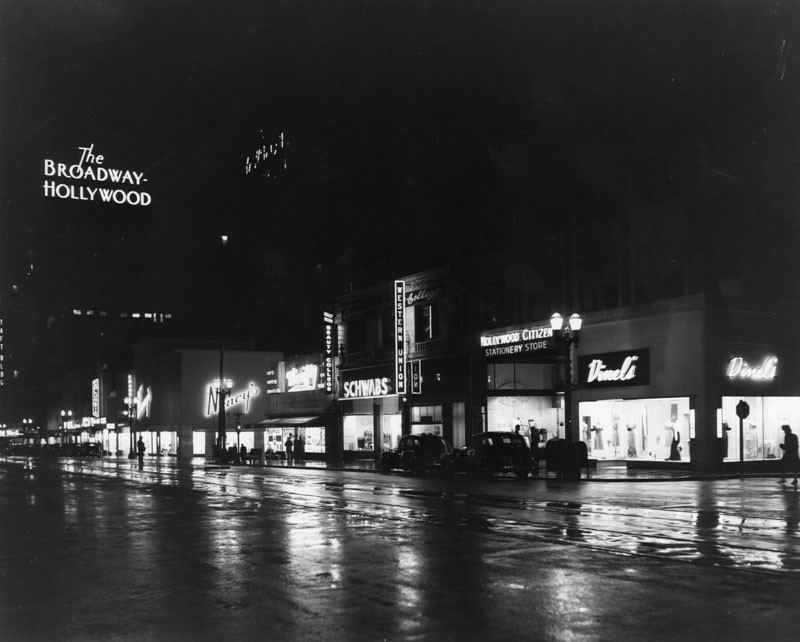 |
|
| (1940s)* - Night view of the south side of Hollywood Boulevard looking east from Cosmo. The Broadway-Hollywood is on the left at the corner of Vine. Seen also, with neon-lighted signage, are Nancy's, Thrifty, Hollywood Beauty College, Schwabs, Western Union, Hollywood Citizen Stationery Store, and Dinel's. |
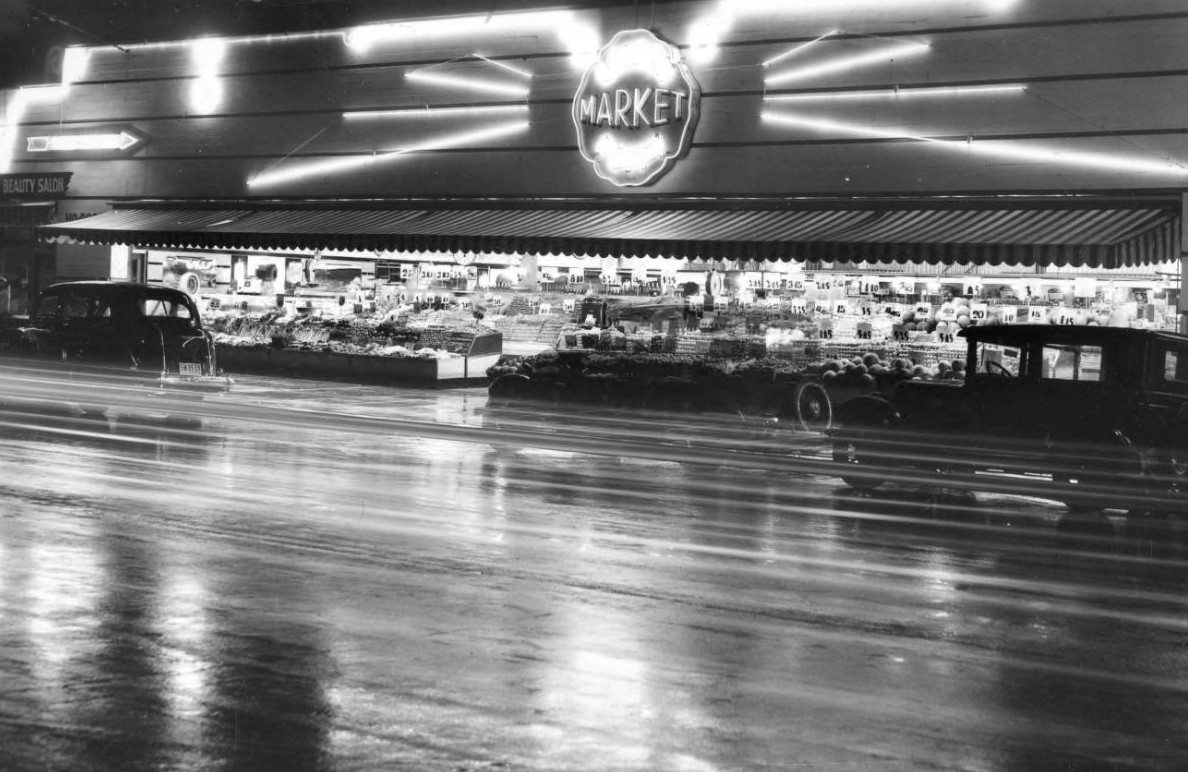 |
|
| (ca. 1938)^ - Night view of a market on Hollywood Boulevard circa 1938. |
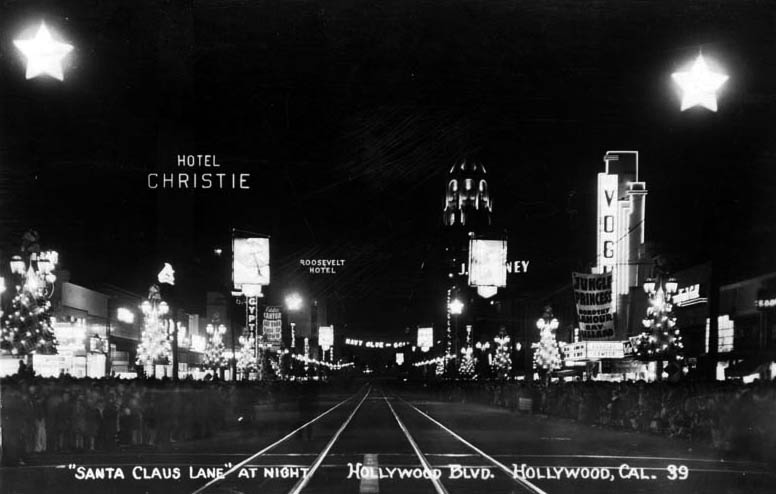 |
|
| (1938)^^^ - Postcard view looking west down the center of Hollywood Boulevard during the Hollywood Christmas Parade. From left to right can be seen the Hotel Christie, Egyptian Theatre, Roosevelt Hotel, First National Bank Building and the Vogue Theatre. |
Historical Notes The Hollywood Chamber of Commerce created the Hollywood Christmas Parade in 1928 to boost shopping. Originally called the Santa Claus Lane Parade, the inaugural event featured only Santa Claus and the actress Jeanette Loff. The parade continued to grow in scale with the help of local businesses and the community. In 1931 Santa Claus rode a truck-pulled float instead of the reindeer-pulled carriage of previous years. American Legion Post 43 marched with a color guard, drum line and bugle corps.*^ |
Admiral Theatre (later Vine Theatre)
 |
|
| (1940)^#^ - A pre-opening photo of the Admiral Theatre located at 6321 Hollywood Boulevard. The theatre is bookended by See's Candies on the left and a Health Juice Bar on the right. Photo by Julius Shulman. |
Historical Notes Designed by S. Charles Lee, the Admiral Theatre opened on May 16, 1940. The building was originally a restaurant* before being remodeled into a theatre. The opening films were "His Majesty's Mistress" with Danielle Darrieux and John Loder along with "Torpedoed" starring H.B. Warner. *In 1933 it was Henry's Restaurant. In March 1934 Henry’s was out and it reopened as Perry's Brass Rail, Perry having moved from three doors to the west. By late 1936 it had become the Weiss Cafe. ^ |
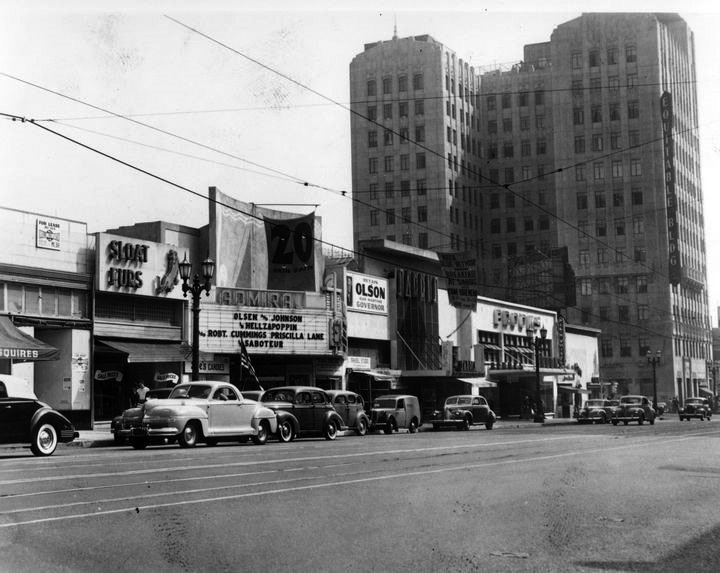 |
|
| (1942)^ – View looking northeast across Hollywood Blvd showing the Admiral Theatre (center-left). On the marquee: "Hellzapoppin" and "Saboteur." Also seen here are: Sardi's Restaurant and Nightclub (to the right of the theater) and the 12-story Equitable Building (NE corner of Hollywood and Vine). |
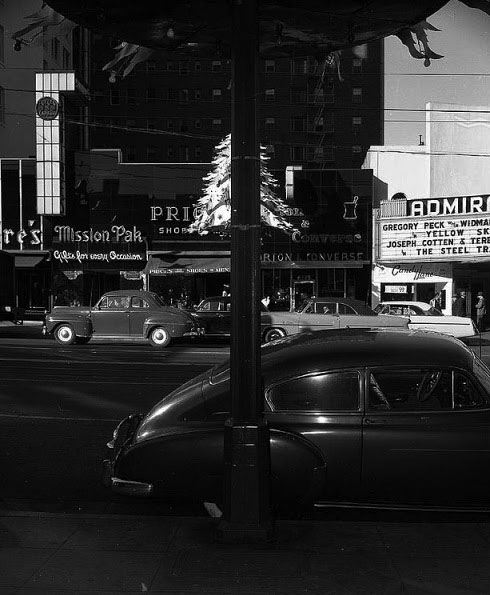 |
|
| (1953)^ – Dusk view looking across Hollywood Boulevard showing a portion of the Admiral Theatre. The two movies playing are: Yellow Sky with Gregory Peck and The Steel Trap starring Joseph Cotton. |
.jpg) |
|
| (1969)^ – View showing the ‘new’ Vine Theatre (originally Admiral Theatre), after it was remodeled.. |
Historical Notes In the 60s the theatre was known as Rector's Admiral and, at the end, played mostly revivals and sub-runs. Trans-Beacon (in association with New York's B.S. Moss circuit) gave it a $200,000 remodel in 1969 and re-named it the Vine Theatre.^ |
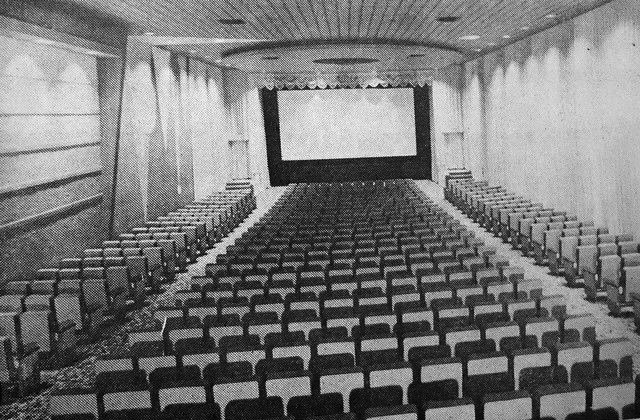 |
|
| (1969)^ - The Vine's auditorium after the 1969 remodel. The photo appeared in the May 19, 1969 issue of BoxOffice. |
Historical Notes Pacific Theatres acquired the theatre and operated it for years (with a yet another remodel in the 70's) as both a Spanish language house and a $2 grindhouse. At the end it was an independent operation with $7 double features. After 70 years of operation (with a few breaks) the Vine closed as a regular film theatre in October 2007. Dolby leased the Vine in late 2013 and the theatre was gutted down to the bare walls in 2014. It was rebuilt as a private demonstration showcase for their Dolby Vision process, featuring laser-based projection.^ Click HERE for contemporary street view of the Vine. |
Florentine Gardens Nightclub
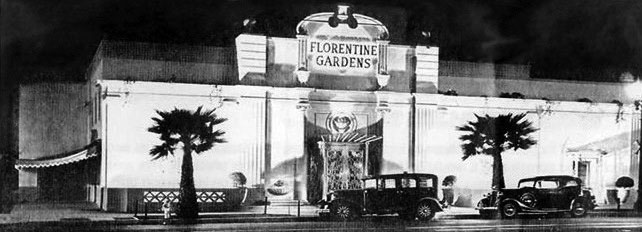 |
|
| (ca. 1939)**## – View showing the Florentine Gardens nightclub located at 5951 Hollywood Boulevard. |
Historical Notes On December 28, 1938 businessman Frank Bruni opened a glamorous dinner theatre on Hollywood Blvd’s easternmost edge. Catering to Hollywood’s elite along with its working classes, the Florentine Gardens charged a $1.25 cover charge or $2.50 to dine and dance. The building was designed by architect Gordon Kaufmann whose other notable achievements were the Los Angeles Times building, Greystone Mansion in Beverly Hills, and Hoover Dam. The original structure, which cost $500,000 to build, was designed to resemble a Moorish palace and proclaimed itself as having the finest dance floor on the Pacific Coast.^ |
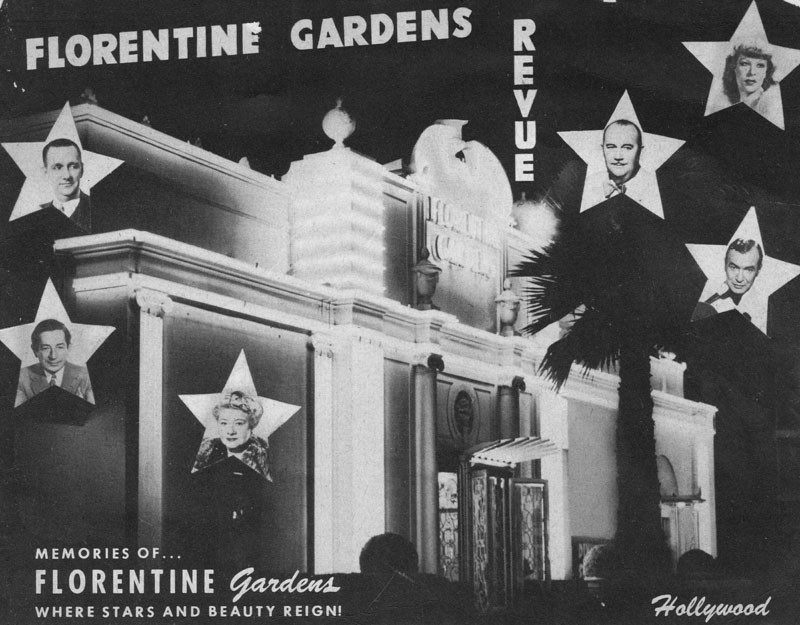 |
|
| (1945)* - Cover of folder containing souvenir photographs from the Florentine Gardens restaurant. |
Historical Notes Various performers made appearances at the Florentine Gardens including such big acts as the Mills Brothers and Sophie Tucker. Yvonne DeCarlo, or more famously known as Lily Munster, from the 1960s television show The Munsters, started as a chorus girl at the Florentine Gardens.^^ |
 |
|
| (n.d.)* - Front view of the Florentine Gardens nightclub--2 palm trees at the front, a timeclock by Gruen and a flag reading "Girl Revue" above the building. |
Historical Notes The Florentine Gardens nightclub could hold 500 people, as much as Earl Carroll’s. It was a popular club featuring Italian food and an often risqué floorshow. By the late 40s/early 50s it had become known more for its scantily clad girlie shows. Probably its biggest claim to fame is that in 1942 Marilyn Monroe and Jim Dougherty held their wedding reception here. The building is still there, complete with the same name, but now appears to be a Latin club. Click HERE for contemporary view. |
Earl Carroll Theatre
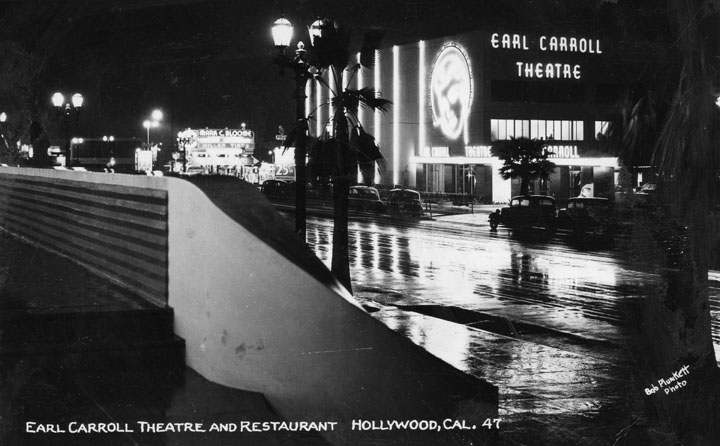 |
|
| (ca. 1938)* - A photographic postcard showing the Earl Carroll Theater, located at 6230 Sunset Boulevard, as seen from across the street at night. Mark C. Bloome, located just east of the theater, can be seen in the distance. |
Historical Notes Earl Carroll Theatre was the name of two important theaters owned by Broadway impresario and showman Earl Carroll. One was located on Broadway in New York City and the other on Sunset Blvd in Hollywood. Earl Carroll built his second famous theatre at 6230 Sunset Blvd. in Hollywood that opened on December 26, 1938. As he had done at the New York theatre, over the doors of the entrance Carroll had emblazoned the words "Through these portals pass the most beautiful girls in the world." *^ |
 |
|
| (ca. 1938)* - View showing the Earl Carroll Theater revolving stage under construction. What appears to be Earl Carroll is reviewing plans with designers and others while the chorus line girls position themselves on the yet to be completed revolving stage. Photo: Vintage Los Angeles. |
Historical Notes An "entertainment palace," the glamorous supper club-theatre offered shows on a massive stage with a 60-foot wide double revolving turntable and staircase plus swings that could be lowered from the ceiling.*^ |
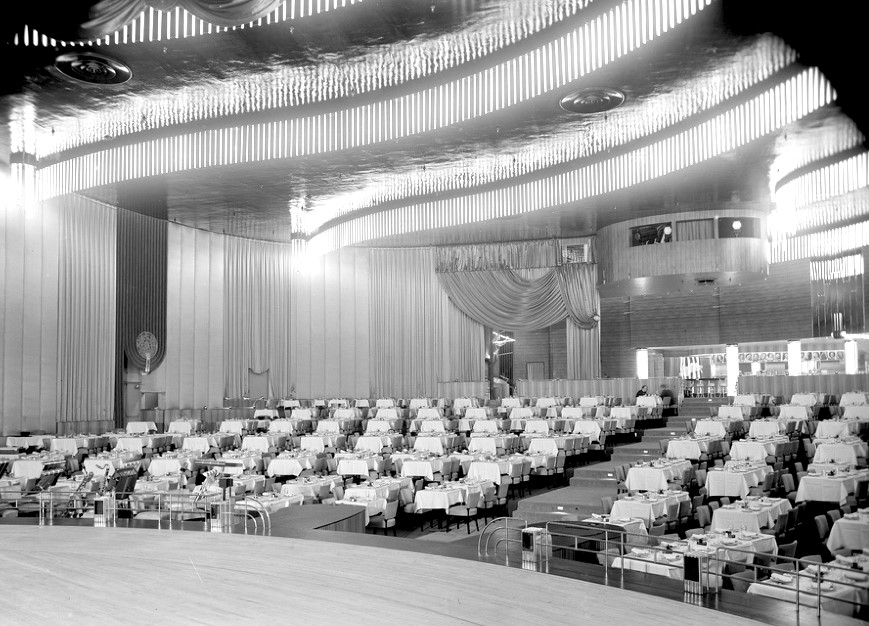 |
|
| (n.d.)**## – Interior view of the Earl Carroll Theater as seen from the revolving stage. |
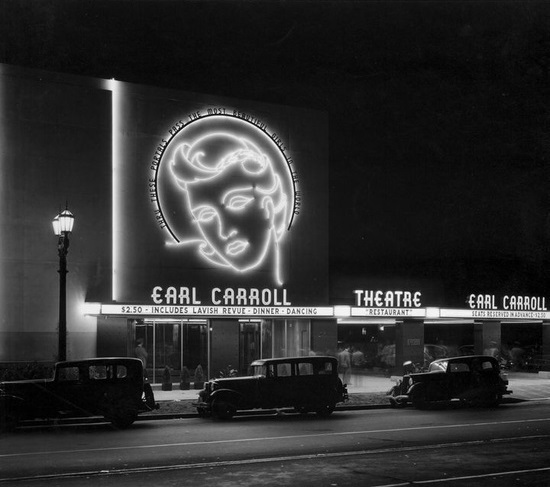 |
|
| (1939)***# - View of the front of the Earl Carroll Theatre with a woman's face in neon outline above the entrance. |
Historical Notes The Earl Carroll Theatre's facade was adorned by what at the time was one of Hollywood's most famous landmarks: a 20-foot high neon head portrait of entertainer Beryl Wallace, one of Earl Carroll's "most beautiful girls in the world," who became his devoted companion. |
 |
|
| (2016)^^^# – Close-up view of the Earl Carroll Theatre neon sign that reads: ‘Thru These Portals Pass The Most Beautiful Girls In The World’. Photo by Sandi Hemmerlein |
Historical Notes The Earl Carroll Theatre's sign had long since vanished by the 1960s, but a re-creation made from photos is today on display at the Museum of Neon Art in Glendale, as part of the collection of historic neon signs from the Museum of Neon Art. |
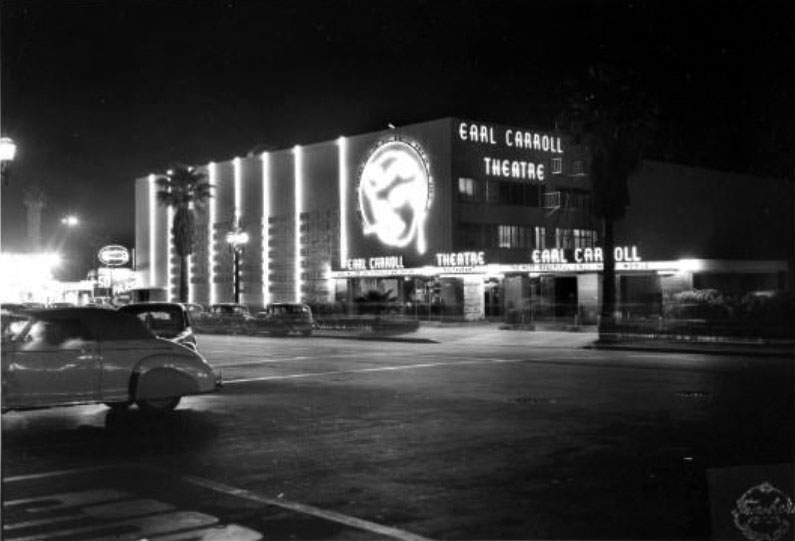 |
|
| (1947)^*^^ – Postcard night view of the Earl Carroll Theatre on Sunset Boulevard near Vine. |
 |
|
| (1940s)#^^^ – Postcard view showing the “Wall of Fame”, Earl Carroll’s Theatre-Restaurant, Hollywood. |
Historical Notes Another major feature at the Earl Carroll Theatre was its "Wall of Fame" where many of Hollywood's most glamorous stars had inscribed personal messages on individual concrete blocks, which were mounted on an outside wall of the building.*^ |
 |
|
| (ca. 1940)* - Exterior view of the Earl Carroll Theatre, located at 6230 Sunset Boulevard in Hollywood. Plaques affixed to the building reveal signatures from some of the top performers of the day; from left to right, Edward G. Robinson, Miriam Hopkins, Jean Hersholt, Binnie Barnes, Charles Laughton, Elsa Lanchester, Bob Hope, Nelson Eddy, Ginger Rogers, and Mickey Rooney. A banner on which most of Jimmy Durante's name is visible hangs a foot or so away from the building. |
Historical Notes Over time, hundreds of movie stars inscribed their signatures on the building’s concrete blocks. One of the great Hollywood mysteries is the fate of all those signed slabs. |
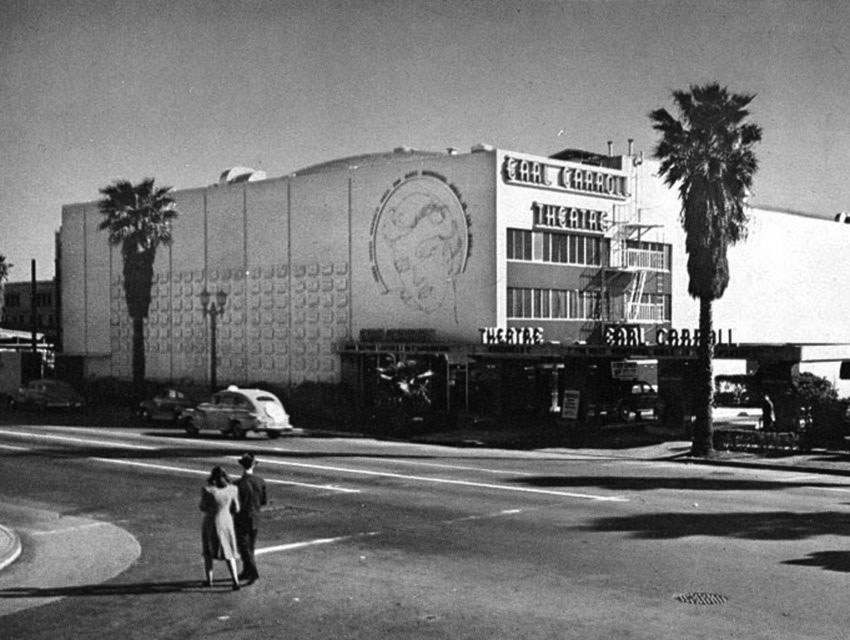 |
|
| (1940s)^^*^* – Postcard view looking southeast showing a couple crossing Argyle Avenue with the Earl Carroll Theatre seen across Sunset Boulevard. |
 |
|
| (1948)^##* – View looking west on Sunset Boulevard at N. El Centro Ave. The Earl Carroll Theatre can be seen in the distance, with Mark C. Bloome Tires on the left. |
Historical Notes The Earl Carroll Theater was sold following the 1948 deaths of Earl Carrolll and Beryl Wallace in the crash of United Airlines Flight 624. It continued to operate but by the early 1950s it was falling on hard times.*^ |
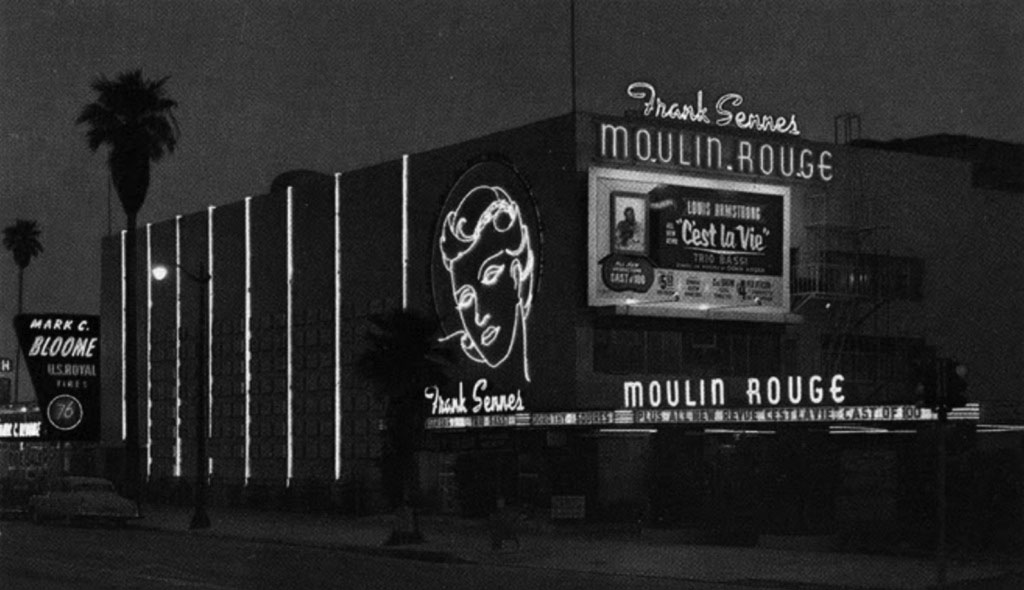 |
|
| (ca. 1953)^^*^* – Night view showing the Frank Sennes Moulin Rouge shown here with the original 20-foot high neon head portrait and also ‘Wall of Fame’ still on the building. Note the Mark C. Bloome sign at left. |
Historical Notes In 1953, Las Vegas showman Frank Sennes reopened the theater as a nightclub under the name "Moulin Rouge". The popular TV contest show Queen for a Day was broadcast from the Moulin Rouge during part of the show's 1956–1964.*^ |
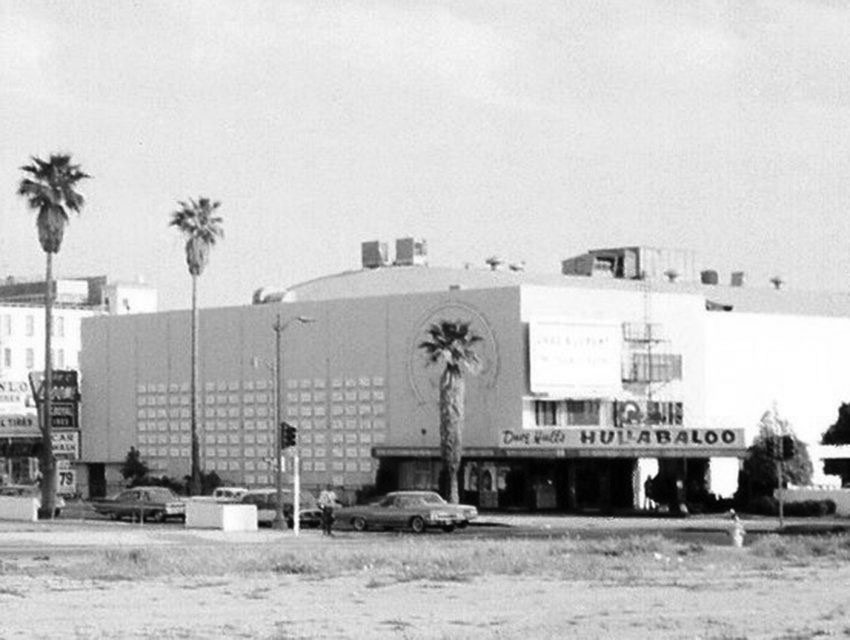 |
|
| (1966)^^*^* – View showing the Hullabaloo Rock and Roll Club. |
Historical Notes In late 1965 the theater became the "Hullabaloo", a minors-welcome rock and roll club, capitalizing on the popularity of the television variety show Hullabaloo. For several months in 1968 it was the "Kaleidoscope" and featured many top West Coast rock acts, with an emphasis on local bands such as The Doors.*^ |
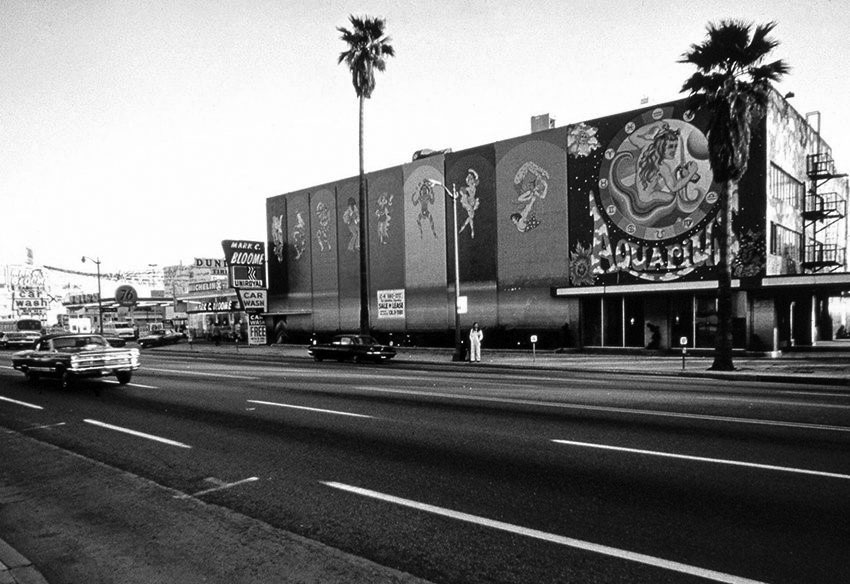 |
|
| (1970)^^*^* – View showing the Aquarius Theater, two years after it was painted for the opening of "Hair” Photograph courtesy Richard Wojcik. |
Historical Notes In late 1968, the venue was redecorated in the psychedelic art style, renamed the "Aquarius Theater", and rededicated as the home of a long-running Los Angeles production of the Broadway musical Hair. It was still sometimes used for rock concerts on Mondays, when the Hair company had its day off, and as a result the Aquarius is famous as the place where The Doors performed on July 21, 1969, making live recordings that were later issued commercially. In 1983, the Pick-Vanoff Company purchased the property and converted it into a state-of-the-art television theater that for nine years was the taping site of Star Search. The Pick-Vanoff Company also owned Sunset-Gower Studios, formerly the home of Columbia Pictures. For many years, it was used for the annual Jerry Lewis MDA Telethon. In the fall of 1993, the theater was the venue for Fox Network's The Chevy Chase Show under the name "The Chevy Chase Theater". The talk show was a disaster and was cancelled after five weeks; the theater reverted to its previous name soon after.*^ |
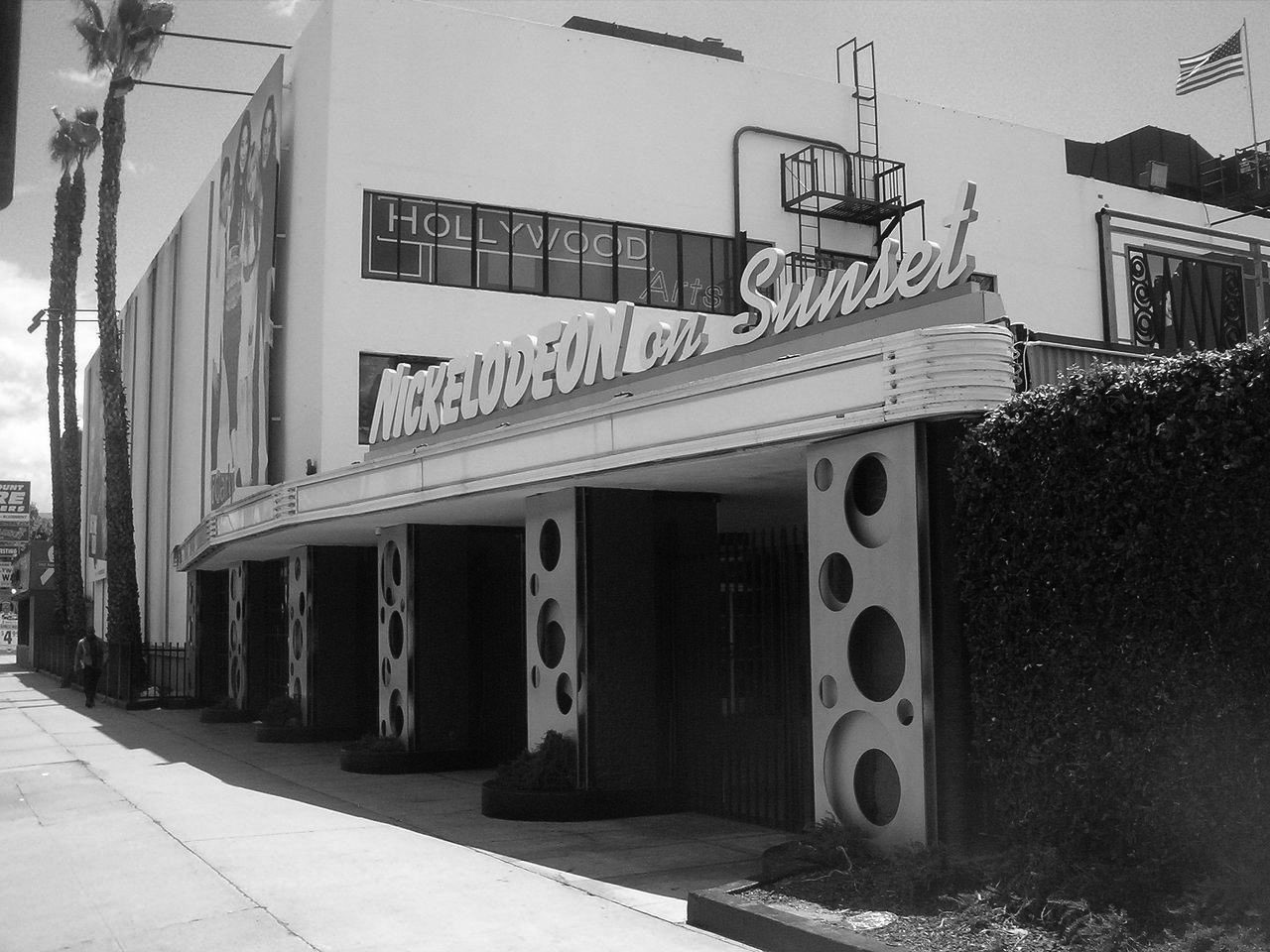 |
|
| (2011)*^ – View showing Nickelodeon on Sunset at 6230 Sunset Boulevard, once the Earl Carrolll Theatre. Photo by Matthew E. Cohen |
Historical Notes In the late 1990s, the name of the theater was changed to "Nickelodeon on Sunset" and it became the headquarters for Nickelodeon's West Coast live-action television production after the theater was acquired by the cable television channel Nickelodeon. Some of the shows filmed there for Nickelodeon include the ten-season run of All That, The Amanda Show, Drake & Josh, and more recently iCarly and Victorious. In 2004, it was sold to a private equity firm as part of a larger parcel of property. As of September 2007, the City of Los Angeles Historic Preservation Board was working to assure that the theater is protected.*^ |
* * * * * |
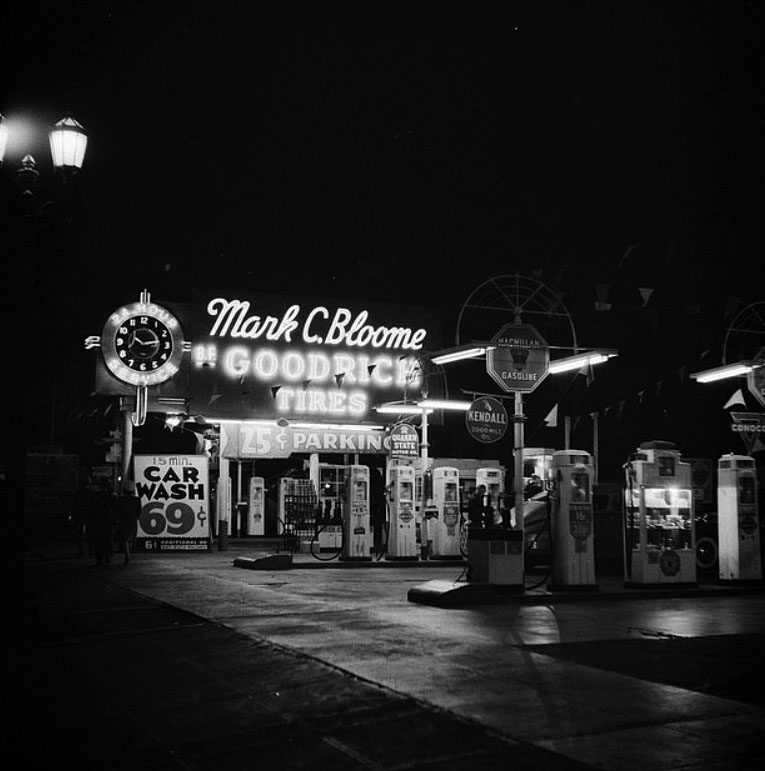 |
|
| (1942)^##* – View showing the Mark C. Bloome Service Station located at 6210 Sunset Boulevard in Hollywood. This service station was on the S/W corner of Sunset and El Centro Avenue, just about opposite the Hollywood Palladium. The Earl Carroll Theatre is just to the right (west) of the station. |
Historical Notes Mark C. Bloome immigrated to Southern California from Canada in 1924 and parlayed a 15-cent-a-gallon Richfield gasoline station into one of the nation's largest chain of tire stores. He survived the Depression years by offering glassware giveaways and other free premiums at his expanding chain of stations and at one point even had women on roller skates speeding among the pumps dispensing gasoline. By the 1950s, Bloome's stations numbered an even dozen and they were selling a broad range of tires from nearly all manufacturers. Customers were waiting in air-conditioned rooms while their cars were being serviced in giant bays a few feet away, a system that was a forerunner of the modern tire store. In 1972, the family sold the business to Petrolane Inc. and Bloome retired. In 1986, Goodyear purchased it. ^^# Today you'll find a strip mall, which includes a Discount Tire Centers, where the Mark C. Bloom Service Station and Tire Shop once stood. Click HERE for Google Street View. Click HERE to see more Early LA Gas Stations. |
* * * * * |
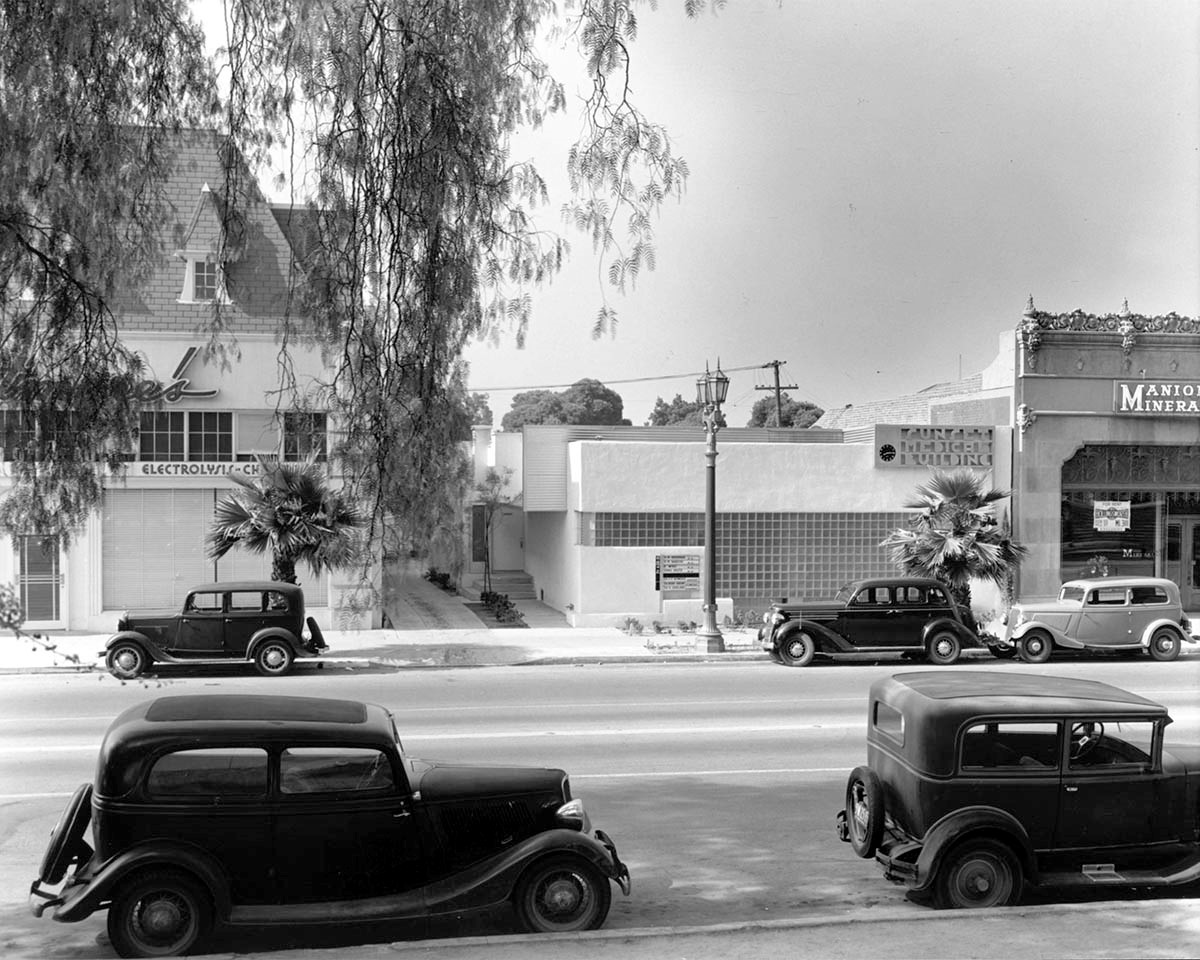 |
|
| (ca. 1936)#+#+ – View looking south across Sunset Boulevard showing the Sunset Medical Building located at 6642 Sunset Boulevard, Hollywood. Photo by Julius Shulman |
Historical Notes From the building records, it looks like 6642 was built as a residence in 1921. The description of the Shulman photos names Rudolph M Schindler as architect, and it's his name that appears on the 1936 alteration permit. There also seems to be a demo permit dated as early as 1967. *# The lot is empty today. Click HERE to see contemporary view. |
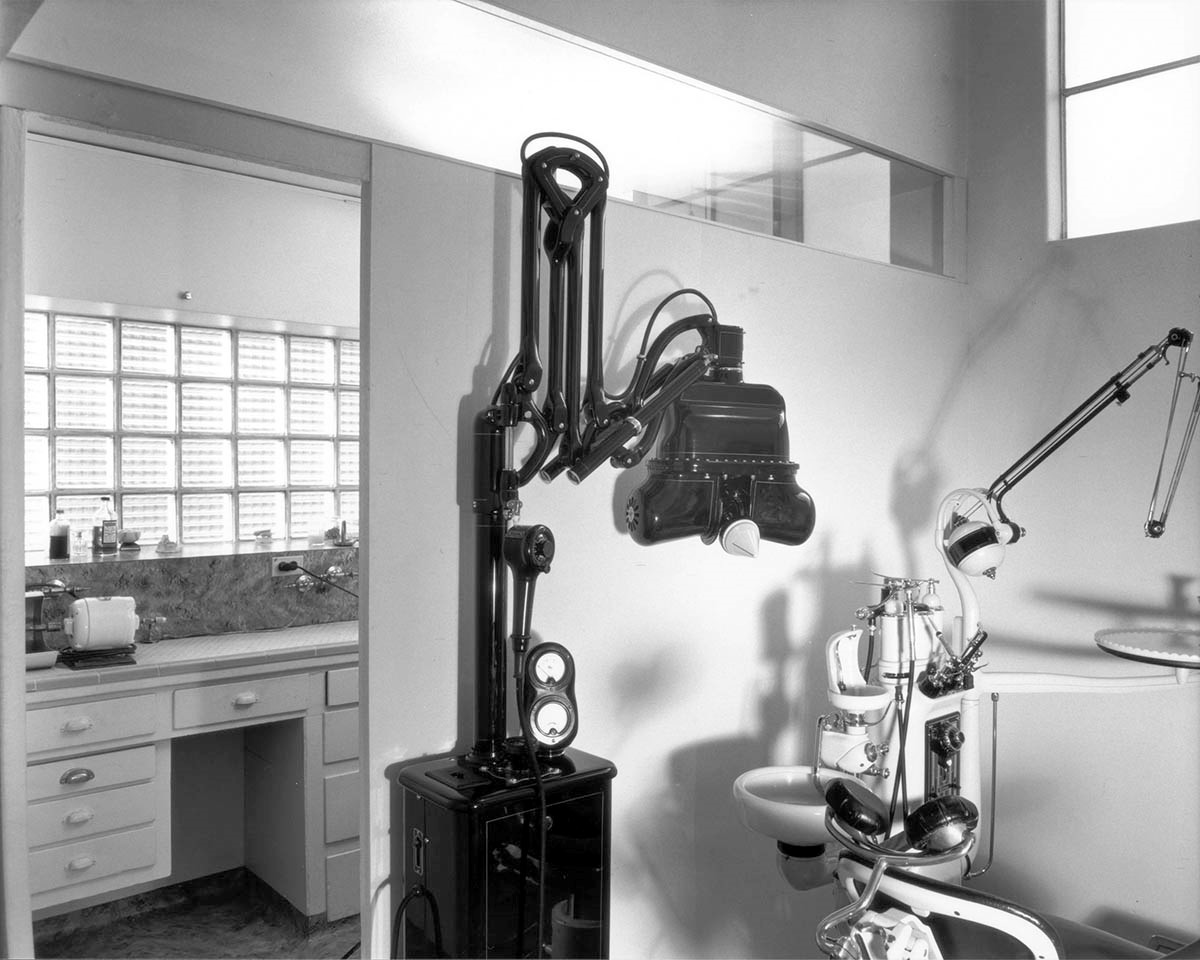 |
|
| (ca. 1936)#+#+ – Interior view of the Sunset Medical Building on Sunset, showing the latest in dental equipment. Photo by Julius Shulman |
* * * * * |
Chili Bowl
 |
|
| (ca. 1937)* - One of the six Chili Bowl restaurants, located at 801 N. La Brea Avenue. The neon sign mounted on the roof reads, "Get the Chili Bowl Habit!" Photo by Herman Schultheis |
Historical Notes Art Whizin established the Chili Bowl restaurant chain in Los Angeles in 1931, known for its distinctive shape in the form of a chili bowl. Whizin was a 25-year-old former amateur boxer when he established the business on Crenshaw Boulevard near Jefferson Boulevard with funding raised by selling "his wife's wedding ring and his roadster." Other businesses at the time were also modeled with architecture featuring eye-catching architectural depictions of the goods sold including ice a cream cones and coffee kettles. These are knows as Programmatic Architecture. Chili Bowl restaurants were arranged with 26 stools around a circular counter (no tables) and employed college "kids" as burger flippers. The specialty dish was an open-faced burger smothered in chili and there were 22 restaurants within a decade of the eatery's opening. After WWII many of the stores were converted into Punch & Judy Ice Cream Parlors that were later closed, and Whizin also built a mall in Agoura Hills that still bears his name.*^ |
 |
|
| (1961)* - Exterior of Theater Ninety, located at 972 Vine Street at Willoughby Avenue (lower left). A Texaco service station is on the far right. This structure's shape and size give away its former life as a Chili Bowl restaurant; it has since been demolished. |
Historical Notes Four Chili Bowl structures survive, one in Huntington Park, Long Beach that is now the Guadalajara Nightclub, another became Kim Chuy Chinese restaurant on Valley Boulevard in Alhambra, the one on Pico Boulevard (that remained open 24 hours during the war effort for nearby workers), is now Mr. Cecil's California Ribs, and the one on San Fernando Road in Glendale is a used-car dealership.*^ Click HERE to see more examples of Programmatic Architecture. |
* * * * * |
Radio Center Market
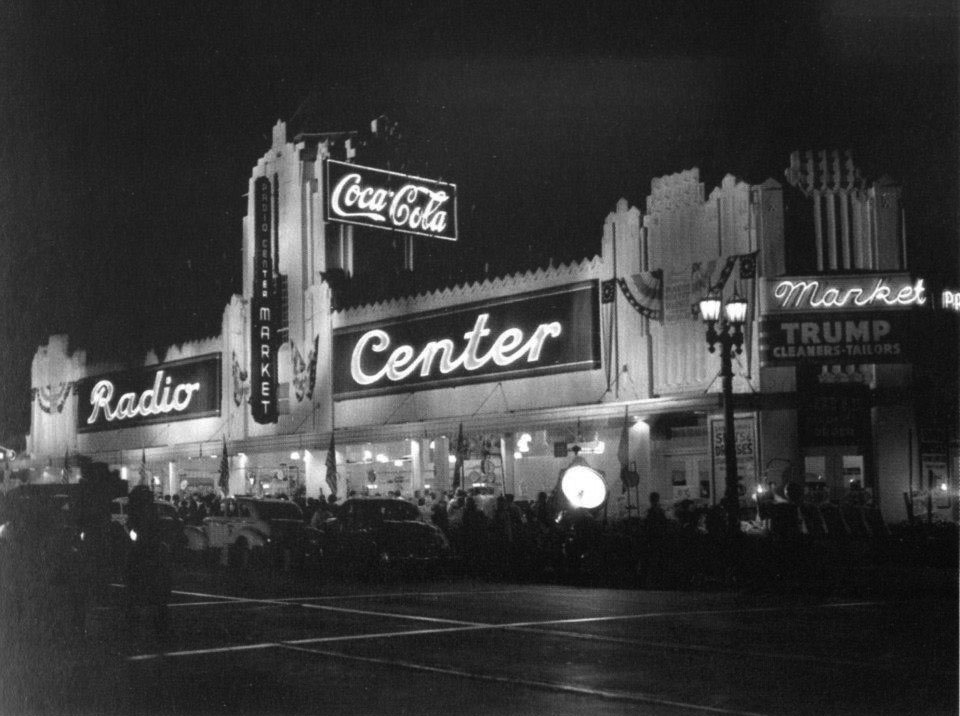 |
|
| (ca. 1939)#**# - Spotlights greet customers to the opening of the Radio Center Market at 1334 Vine Street, Hollywood, not far from the Sunset and Vine corner where the NBC and CBS radio studios were located. Note the sign above the corner entrance reads: 'TRUMP' Cleaners – Tailors. The building still stands today, although modified. Click HERE for contemporary view. |
* * * * * |
Please Support Our CauseWater and Power Associates, Inc. is a non-profit, public service organization dedicated to preserving historical records and photos. Your generosity allows us to continue to disseminate knowledge of the rich and diverse multicultural history of the greater Los Angeles area; to serve as a resource of historical information; and to assist in the preservation of the city's historic records.
|
More Historical Early Views
Newest Additions
Early LA Buildings and City Views
History of Water and Electricity in Los Angeles
* * * * * |
References and Credits
* LA Public Library Image Archive
^* California Historic Landmark Listing (Los Angeles)
^ California Historical Society Digital Archive
** Retronaut - Hollywoodland Sign
#^WhitleyHeights.org: Aerial of Cahuenga; Whitley Heights Aerial
#+LA Weekly: Laurel Canyon Country Store
***The Story of Hollywood by Gregory Paul Williams
^^^California State Library Image Archive
^**Huntington Digital Library Archive
**^Table Magazine: LA Observatory
**#Beguiling Hollywood: The Hollywood Hotel
^^#LA Times: Hollywood Citizens News Building; Marlboro Man Signboard; Mark C. Bloome
+^#Facebook.com: Hidden Los Angeles
^x*Facebook.com: So. Calif. Historic Arrchitecture
*#*Elvis Blog
*.* Greater Streets: Exploring the Walk of Fame — Heart of Hollywood
#^^Hollywood Walk of Fame Historic Buildings
#++GoCalifornia.about.com: Sunset Strip
#^*Pinterest.com: Old Hollywood; Los Angeles
#^# DWP - LA Public Library Image Archive
##*The Daily Mirror: Garden Court Apartments
*^*MTA Transportation and Research Library Archives
*^^Nuestra Señora la Reina de los Ángeles - losangelespast.com
^^*Cinema Treasures: Vogue Theater; Pantages Theater; Iris Theatre; Marcal - World Theatre
*^*^YMCA Hollywood - paulwilliamspoject.org
*^^*Vintage Los Angeles: Facebook.com: Lucy/Holden; Villa Nova; Sunset Tower Apartments; Earl Carroll Revolving Stage; Schwabs Sunset; Player's Club
^*^^Pomona Public Library Poscard Collection
^^^^Water and Power Associates
^*^#Facebook.com - Bizzare Los Angeles
^^^#KCET: How the Town of Sherman Became West Hollywood; The Player's on the Sunset Strip; L.A.'s First Freeways
+++#Go-Go Notebook.com: Flipper's Roller Derby Palace
***^Pinterest.com: Bertrand Lacheze; Vintage Los Angeles: Sunset Strip; Trocadero Nightclub
^**^Griffith Observatory: laparks.org
**##MartinTurnbull.com: The Players; Hollywood-Western Building; Earl Carroll Theater; Sherry's Restaurant; Hollywood and Highland
+##+Restaurant-ing Through History: Ice Cream Parlors
^##*Flickr.com: Michael Ryerson; Bill Badzo
^#^^Facebook.com - Vintage LA: 1968 Sunset Strip; Yellow Submarine; 1984 Sunset Strip
^^#*Flickr.com: Elizabeth Fuller
*#*#Facebook.com - Great Photos from Los Angeles's Past: Players Nightclub
*^#*Calisphere: University of California Image Archive
*^^#Mt. Hollywood - Small Mountain, Big Dreams
*^##OAC - Online Archive of California
#**#Facebook.com: Garden of Allah Novels, Martin Turnbull
#*^#Historic Hollywood Theatres: Grauman's Chinese Theatre
#^**The Go Go's: Local Coffee Shops and Diners; PJ's Nightclub
#^^#The Rise and Fall of Dino's Lodge by Kliph Nesteroff
#^##ShareTV.com: 77 Sunset Strip
##^*Facebook.com: Classic Hollywood-Los Angeles-SFV
*###Google Maps
###*GoLosAngeles.abouttcom: History of the Sunset Strip
####Neatorama.com: Dean Martin and Jerry Lewis Restaurant Owners
#^#*Pinterest.com: Rock'n'Roll & Boogie Woogie
**^**Los Angeles City Historical Society
***^^Oldshowbiz.tmblr.com: Crescendo Club
***##Googie Architecture
**^^^Pinterest.com: Sunset Strip
*^^^^SeriousEats.com: Carneys Diner
*^*^*Blogspot.com: It's a wrap - USA/Mexico - Mel's Drive-In
*^#^*Vintage Everyday
*^*^^Crescendo GNP
^*^*^Go Los Angeles About.com: Sunset Strip
^***^Flickr.com: gsjansen
*^^^*RareMaps.com
^^*^*Los Angeles Magazine: Aquarius Theatre
^#*#^Private Los Angeles Tours: Ciro's Nightclub
^#^#^LA Curbed: Sunset's Tower Records
*#*#*wehoville.com: Tower Records
*# Skyscraperage.com. - Griffith Observatory; Elvis at Knickerbocker Hotel; Gruen Sign; Garden Court Apartments; Mt. Hollywood; Ben-Hur Coffee; Sherry's Restaurant; Griffith Observatory; Sunset Strip 1960s; Cahunega and Highland Intersection ca1937; Googie's; Selma and Argyle; Sunset Medical Building; Ravenswood Apartments
*^ Wikipedia: Hollywood; Hollywood Athletic Club; Hollywood Bowl; Grauman's Chinese Theatre; Grauman's Egyptian Theatre; Pantages Theatre (Hollywood); John Hanson Ford Theatre; 20th Century Fox; Samuel Goldwyn.Studio; Barnsdall Art Park; Greek Theatre; Griffith Observatory; Cinerama Dome; Ralphs; Hollywood Palladium; Hollywood and Vine; Hollywood Masonic Temple; Hollywood Pacific Theatre; Max Factor; West Hollywood; Brown Derby; Hollywood Christmas Parade; The Hollywood Hotel; Cord Automobile: Sunset Tower; West Coast Radio City - Los Angeles; Earl Carroll Theater; Cafe Trocadero; Breakfast in Hollywood; Whitley Heights; Hollywood Christmas Parade; Garden Court Apartments; Chili Bowl Restaurant - Art Whizin; The Hillview; Paramount Studios; Hollywood Freeway; Hollywood Roosevelt Hotel; J. J. Newberry; Claudette Colbert; Whisky A Go-Go; Gazzari's; The Whtie Parade; The Troubador; Starwood Club; Hollywood Post Office; Chubby Checker; Decoration Day; 77 Sunset Strip; Chateau Marmont Hotel; The Doors; The Comedy Store; Ciro's Nightclub; The Ravenswood; Googie Architecture; Charlie Chaplin; Doheny Drive; Shirley Temple
< Back
Menu
- Home
- Mission
- Museum
- Major Efforts
- Recent Newsletters
- Historical Op Ed Pieces
- Board Officers and Directors
- Mulholland/McCarthy Service Awards
- Positions on Owens Valley and the City of Los Angeles Issues
- Legislative Positions on
Water Issues
- Legislative Positions on
Energy Issues
- Membership
- Contact Us
- Search Index